

37 Water Science Experiments: Fun & Easy
We’ve curated a diverse selection of water related science experiments suitable for all ages, covering topics such as density, surface tension, water purification, and much more.
These hands-on, educational activities will not only deepen your understanding of water’s remarkable properties but also ignite a passion for scientific inquiry.
So, grab your lab coat and let’s dive into the fascinating world of water-based science experiments!
Water Science Experiments
1. walking water science experiment.

This experiment is a simple yet fascinating science experiment that involves observing the capillary action of water. Children can learn a lot from this experiment about the characteristics of water and the capillary action phenomenon. It is also a great approach to promote scientific curiosity and enthusiasm.
Learn more: Walking Water Science Experiment
2. Water Filtration Experiment

A water filtering experiment explains how to purify contaminated water using economical supplies. The experiment’s goal is to educate people about the procedure of water filtration, which is crucial in clearing water of impurities and contaminants so that it is safe to drink.
Learn more: Water Filtration Experiment
3. Water Cycle in a Bag
The water cycle in a bag experiment became to be an enjoyable and useful instructional exercise that helps students understand this idea. Participants in the experiment can observe the many water cycle processes by building a model of the water cycle within a Ziplock bag.
4. Cloud in a Jar

The rain cloud in a jar experiment is a popular instructional project that explains the water cycle and precipitation creation. This experiment is best done as a water experiment since it includes monitoring and understanding how water changes state from a gas (water vapor) to a liquid (rain) and back to a gas.
Learn more: Cloud in a Jar
5. The Rising Water
The rising water using a candle experiment is a wonderful way to teach both adults and children the fundamentals of physics while also giving them an exciting look at the properties of gases and how they interact with liquids.
6. Leak Proof Bag Science Experiment

In the experiment, a plastic bag will be filled with water, and after that, pencils will be inserted through the bag without causing it to leak.
The experiments explain how the plastic bag’s polymer chains stretch and form a barrier that keeps water from dripping through the holes the pencils have produced.
Learn more: Leak Proof Bag Science Experiment
7. Keep Paper Dry Under Water Science Experiment

The experiment is an enjoyable way for demonstrating air pressure and surface tension for both adults and children. It’s an entertaining and engaging technique to increase scientific curiosity and learn about scientific fundamentals.
Learn more: Keep Paper Dry Under Water Science Experiment
8. Frozen Water Science Experiment
The Frozen Water Science Experiment is a fun and engaging project that teaches about the qualities of water and how it behaves when frozen.
You can gain a better knowledge of the science behind the freezing process and investigate how different variables can affect the outcome by carrying out this experiment.
9. Make Ice Stalagmites
10. Bending of Light
A fascinating scientific activity that explores visual principles and how light behaves in different surfaces is the “bending of light” water experiment. This experiment has applications in physics, engineering, and technology in addition to being a fun and interesting method to learn about the characteristics of light.
11. Salt on a Stick

This experiment is an excellent way to catch interest, engage in practical learning, and gain a deeper understanding of the characteristics of water and how they relate to other substances. So the “Salt on Stick” water experiment is definitely worth trying if you’re looking for a fun and educational activity to try!
Learn More: Water Cycle Experiment Salt and Stick
12. Separating Mixture by Evaporation
This method has practical applications in fields like water processing and is employed in a wide range of scientific disciplines, from chemistry to environmental science.
You will better understand the principles determining the behavior of mixtures and the scientific procedures used to separate them by performing this experiment at home.
13. Dancing Spaghetti
Have you ever heard of the dancing spaghetti experiment? It’s a fascinating science experiment that combines simple materials to create a mesmerizing visual display.
The dancing spaghetti experiment is not only entertaining, but it also helps you understand the scientific concepts of chemical reactions, gas production, and acidity levels.
14. Magic Color Changing Potion
The magic color-changing potion experiment with water, vinegar, and baking soda must be tried since it’s an easy home-based scientific experiment that’s entertaining and educational.
This experiment is an excellent way to teach kids about chemical reactions and the characteristics of acids and bases while providing them an interesting and satisfying activity.
15. Traveling Water Experiment

In this experiment, you will use simple objects like straws or strings to make a path for water to pass between two or more containers.
Learn more: Rookie Parenting
16. Dry Erase and Water “Floating Ink” Experiment

The dry-erase and water “floating ink” experiment offers an interesting look at the characteristics of liquids and the laws of buoyancy while also being a great method to educate kids and adults to the fundamentals of science.
Learn more: Dry Erase and Water Floating Ink Experiment
17. Underwater Candle
In this experiment, we will investigate a connection between fire and water and learn about the remarkable factors of an underwater candle.
18. Static Electricity and Water
19. Tornado in a Glass

This captivating experiment will demonstrate how the forces of air and water can combine to create a miniature vortex, resembling a tornado.
Learn more: Tornado in a Glass
20. Make Underwater Magic Sand
Be ready to build a captivating underwater world with the magic sand experiment. This experiment will examine the fascinating characteristics of hydrophobic sand, sometimes referred to as magic sand.
21. Candy Science Experiment
Get ready to taste the rainbow and learn about the science behind it with the Skittles and water experiment! In this fun and colorful experiment, we will explore the concept of solubility and observe how it affects the diffusion of color.
Density Experiments
Density experiments are a useful and instructive approach to learn about the characteristics of matter and the fundamentals of science, and they can serve as a starting point for further exploration into the fascinating world of science.
Density experiments may be carried out with simple materials that can be found in most homes.
This experiment can be a great hands-on learning experience for kids and science lovers of all ages.
22. Super Cool Lava Lamp Experiment
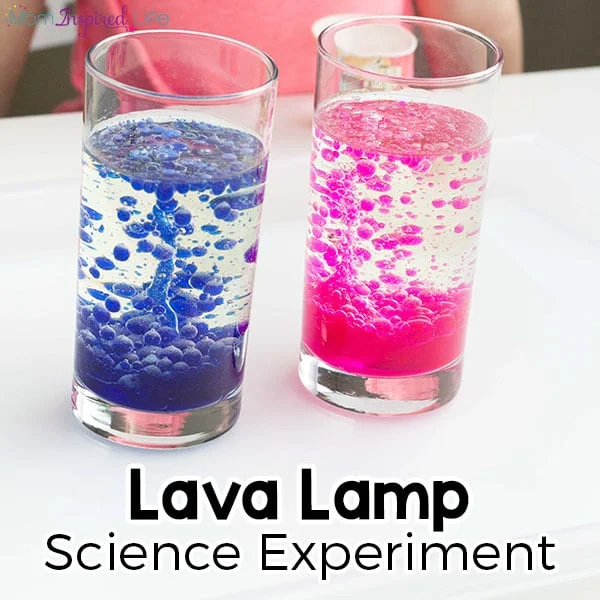
The awesome lava lamp experiment is an entertaining and educational activity that illustrates the concepts of density and chemical reactions. With the help of common household items, this experiment involves making a handmade lava lamp.
Learn more: Lava Lamp Science Experiment
23. Denser Than you Think
Welcome to the fascinating world of density science! The amount of matter in a particular space or volume is known as density, and it is a fundamental concept in science that can be seen everywhere around us.
Understanding density can help us figure out why some objects float while others sink in water, or why certain compounds do not mix.
24. Egg Salt and Water
Learn about the characteristics of water, including its density and buoyancy, and how the addition of salt affects these characteristics through performing this experiment.
25. Hot Water and Cold-Water Density
In this experiment, hot and cold water are put into a container to see how they react to one other’s temperatures and how they interact.
Sound and Water Experiments
Have you ever wondered how sound travels through different mediums? Take a look at these interesting sound and water experiments and learn how sounds and water can affect each other.
26. Home Made Water Xylophone

You can do this simple scientific experiment at home using a few inexpensive ingredients to create a handmade water xylophone.
The experiment demonstrates the science of sound and vibration and demonstrates how changing water concentrations can result in a range of tones and pitches.
Learn more: Home Made Water Xylophone
27. Create Water Forms Using Sound!
A remarkable experiment that exhibits the ability of sound waves to influence and impact the physical world around us is the creation of water formations using sound.
In this experiment, sound waves are used to generate patterns and shapes, resulting in amazing, intricate designs that are fascinating to observe.
28. Sound Makes Water Come Alive
These experiments consist of using sound waves to create water vibrations, which can result in a variety of dynamic and captivating phenomena.
29. Water Whistle
The water whistle experiment includes blowing air through a straw that is submerged in water to produce a whistle.
This experiment is an excellent way to learn about the characteristics of sound waves and how water can affect them.
Water Surface Tension Experiments
You can observe the effects of surface tension on the behavior of liquids by conducting a surface tension experiment.
By trying these experiments, you can gain a better understanding of the properties of liquids and their behavior and how surface tension affects their behavior.
30. Floating Paperclip
In this experiment, you will put a paper clip on the top of the water and observe it float because of the water’s surface tension.
31. Water Glass Surface Tension
Have you ever noticed how, on some surfaces, water drops may form perfect spheres? The surface tension, which is a characteristic of water and the cohesive force that holds a liquid’s molecules together at its surface, is to blame for this.
32. Camphor Powered Boat
The camphor-powered boat experiment is a fun and fascinating way to explore the principles of chemistry, physics, and fluid mechanics. In this experiment, a miniature boat is used to travel across the water’s surface using camphor tablets.
33. Pepper and Soap Experiment

The pepper in a cloud experiment is a simple and interesting activity that explains the concept of surface tension. This experiment includes adding pepper to a bowl of water and then pouring soap to the mixture, causing the pepper to move away from the soap.
Learn more: Pepper and Soap Experiment
Boiling Water Experiments
Experiments with boiling water are an engaging and informative way to learn about physics, chemistry, and water’s characteristics.
These investigations, which include examining how water behaves when it changes temperature and pressure, can shed light on a variety of scientific phenomena.
It’s important to take the proper safety measures when performing experiments with hot water. Boiling water can produce steam and hot particles that are dangerous to inhale in and can result in severe burns if it comes into contact with skin.
34. Make It Rain

This experiment can be accomplished using basic supplies that can be found in most homes, make it an excellent opportunity for hands-on learning for both kids and science lovers.
Learn more: Make it Rain
35. Fire Water Balloons
Learning about the fundamentals of thermodynamics, the behavior of gases, and the effects of heat on objects are all made possible by this experiment.
36. Boil Water with Ice
The Boiling Water with Ice experiment is an engaging and beneficial approach to learn about temperature and the behavior of water. It can also serve as an introduction for further discovery into the wonderful world of science.
37. Boil Water in a Paper Cup
The “boil water in a cup” experiment is an easier but powerful approach to illustrate the idea of heat transmission by conduction. This experiment is often used in science classes to teach students about thermal conductivity and the physics of heat transfer.
Similar Posts:
- 68 Best Chemistry Experiments: Learn About Chemical Reactions
- Top 100 Fine Motor Skills Activities for Toddlers and Preschoolers
- Top 50 Fun Food Science Experiments
Leave a Comment Cancel reply
Save my name and email in this browser for the next time I comment.
- Grades 6-12
- School Leaders
Give Students a Voice in This Digital Storytelling Competition!
72 Easy Science Experiments Using Materials You Already Have On Hand
Because science doesn’t have to be complicated.
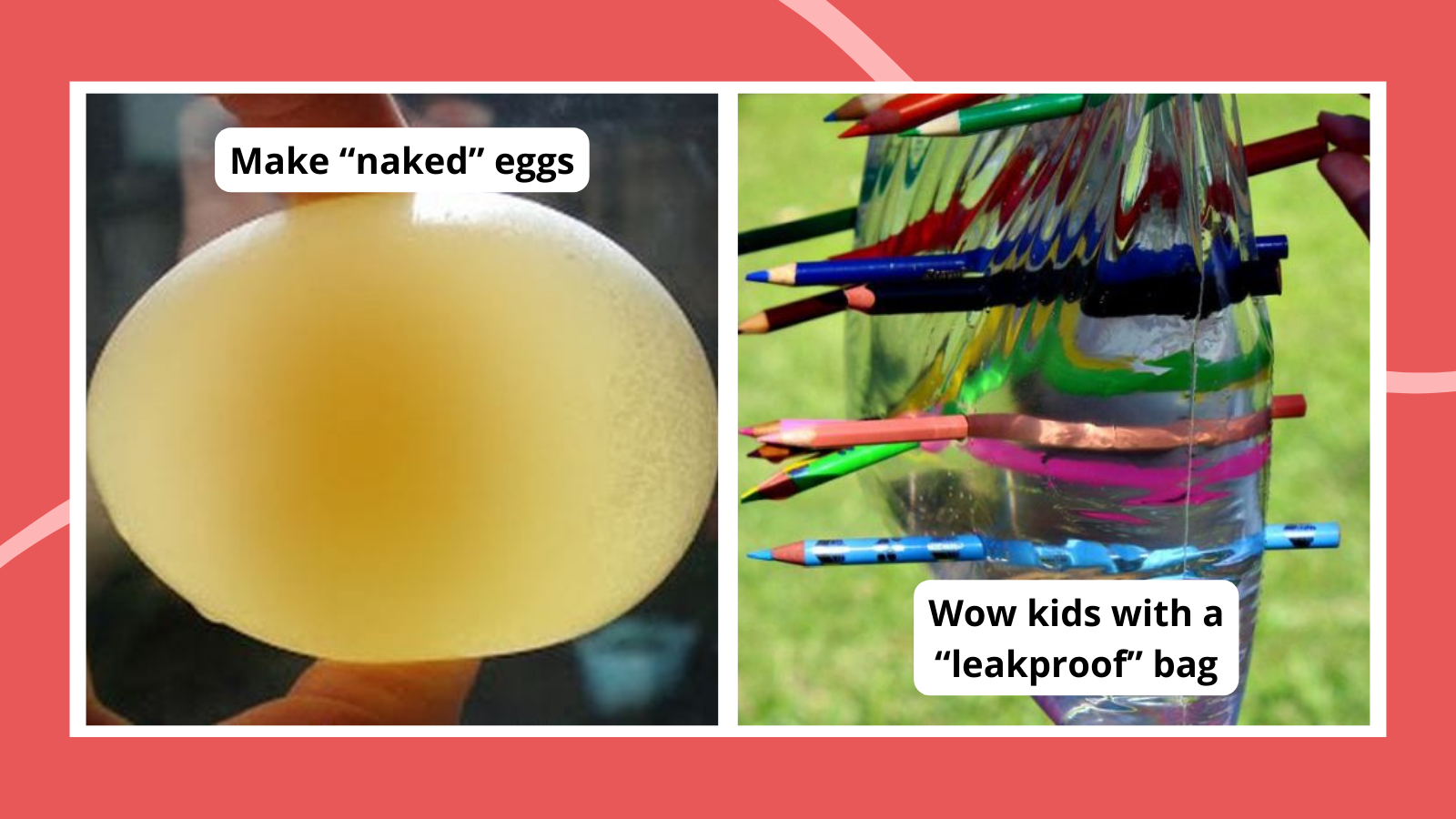
If there is one thing that is guaranteed to get your students excited, it’s a good science experiment! While some experiments require expensive lab equipment or dangerous chemicals, there are plenty of cool projects you can do with regular household items. We’ve rounded up a big collection of easy science experiments that anybody can try, and kids are going to love them!
Easy Chemistry Science Experiments
Easy physics science experiments, easy biology and environmental science experiments, easy engineering experiments and stem challenges.
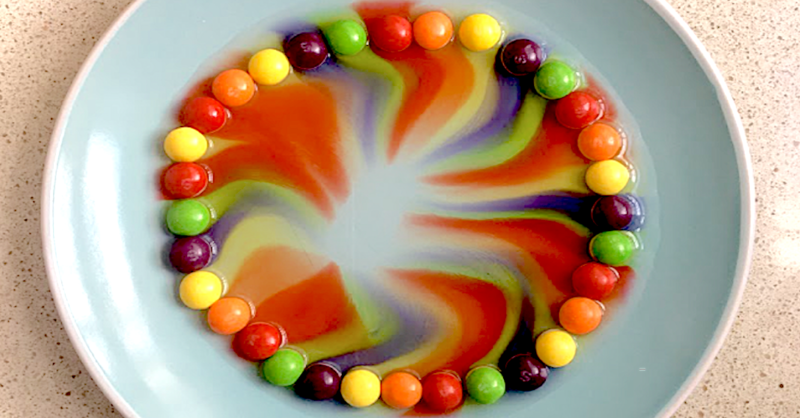
1. Taste the Rainbow
Teach your students about diffusion while creating a beautiful and tasty rainbow! Tip: Have extra Skittles on hand so your class can eat a few!
Learn more: Skittles Diffusion
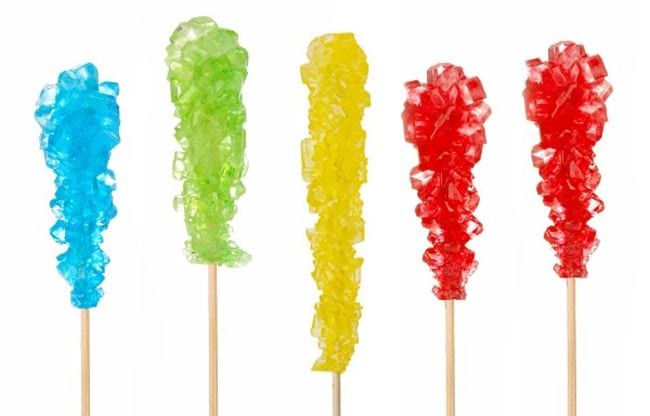
2. Crystallize sweet treats
Crystal science experiments teach kids about supersaturated solutions. This one is easy to do at home, and the results are absolutely delicious!
Learn more: Candy Crystals
3. Make a volcano erupt
This classic experiment demonstrates a chemical reaction between baking soda (sodium bicarbonate) and vinegar (acetic acid), which produces carbon dioxide gas, water, and sodium acetate.
Learn more: Best Volcano Experiments
4. Make elephant toothpaste
This fun project uses yeast and a hydrogen peroxide solution to create overflowing “elephant toothpaste.” Tip: Add an extra fun layer by having kids create toothpaste wrappers for plastic bottles.
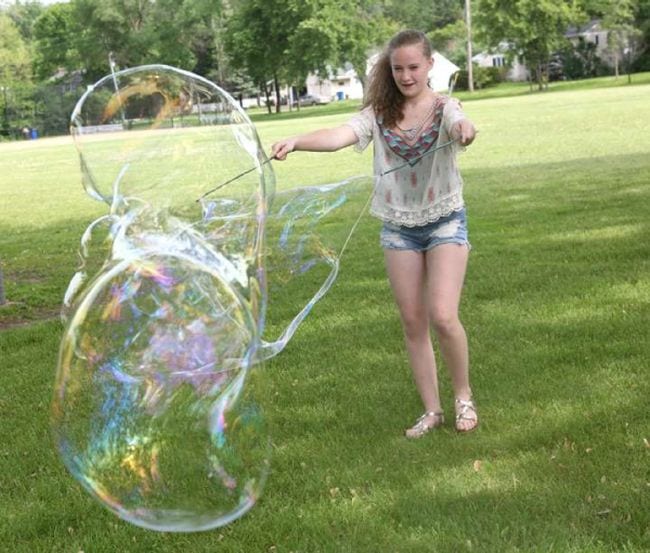
5. Blow the biggest bubbles you can
Add a few simple ingredients to dish soap solution to create the largest bubbles you’ve ever seen! Kids learn about surface tension as they engineer these bubble-blowing wands.
Learn more: Giant Soap Bubbles
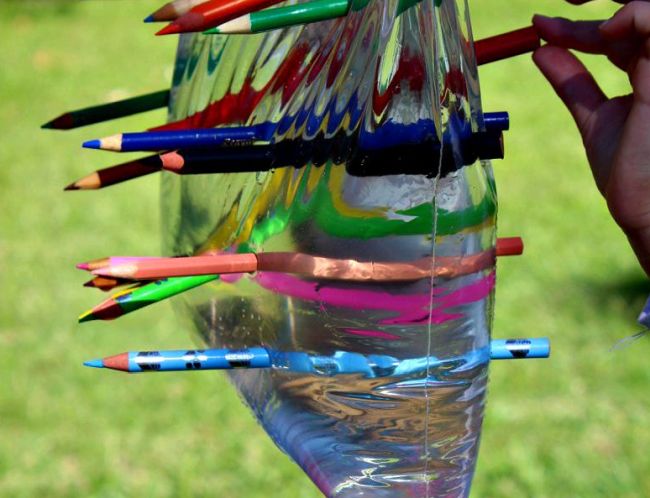
6. Demonstrate the “magic” leakproof bag
All you need is a zip-top plastic bag, sharp pencils, and water to blow your kids’ minds. Once they’re suitably impressed, teach them how the “trick” works by explaining the chemistry of polymers.
Learn more: Leakproof Bag
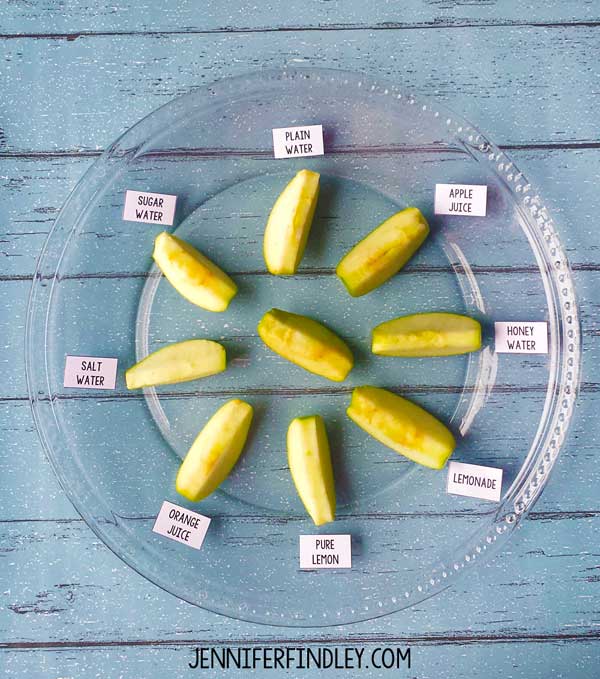
7. Use apple slices to learn about oxidation
Have students make predictions about what will happen to apple slices when immersed in different liquids, then put those predictions to the test. Have them record their observations.
Learn more: Apple Oxidation
8. Float a marker man
Their eyes will pop out of their heads when you “levitate” a stick figure right off the table! This experiment works due to the insolubility of dry-erase marker ink in water, combined with the lighter density of the ink.
Learn more: Floating Marker Man

9. Discover density with hot and cold water
There are a lot of easy science experiments you can do with density. This one is extremely simple, involving only hot and cold water and food coloring, but the visuals make it appealing and fun.
Learn more: Layered Water

10. Layer more liquids
This density demo is a little more complicated, but the effects are spectacular. Slowly layer liquids like honey, dish soap, water, and rubbing alcohol in a glass. Kids will be amazed when the liquids float one on top of the other like magic (except it is really science).
Learn more: Layered Liquids

11. Grow a carbon sugar snake
Easy science experiments can still have impressive results! This eye-popping chemical reaction demonstration only requires simple supplies like sugar, baking soda, and sand.
Learn more: Carbon Sugar Snake
12. Mix up some slime
Tell kids you’re going to make slime at home, and watch their eyes light up! There are a variety of ways to make slime, so try a few different recipes to find the one you like best.

13. Make homemade bouncy balls
These homemade bouncy balls are easy to make since all you need is glue, food coloring, borax powder, cornstarch, and warm water. You’ll want to store them inside a container like a plastic egg because they will flatten out over time.
Learn more: Make Your Own Bouncy Balls

14. Create eggshell chalk
Eggshells contain calcium, the same material that makes chalk. Grind them up and mix them with flour, water, and food coloring to make your very own sidewalk chalk.
Learn more: Eggshell Chalk
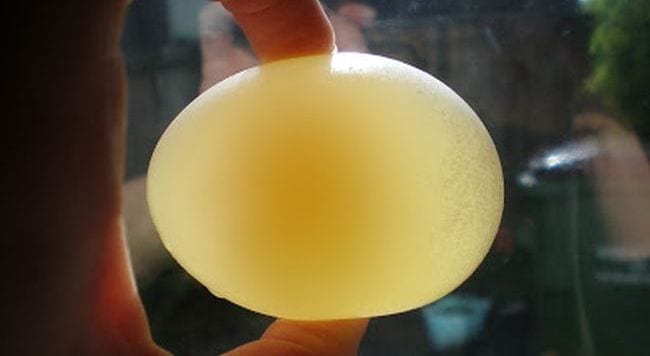
15. Make naked eggs
This is so cool! Use vinegar to dissolve the calcium carbonate in an eggshell to discover the membrane underneath that holds the egg together. Then, use the “naked” egg for another easy science experiment that demonstrates osmosis .
Learn more: Naked Egg Experiment
16. Turn milk into plastic
This sounds a lot more complicated than it is, but don’t be afraid to give it a try. Use simple kitchen supplies to create plastic polymers from plain old milk. Sculpt them into cool shapes when you’re done!

17. Test pH using cabbage
Teach kids about acids and bases without needing pH test strips! Simply boil some red cabbage and use the resulting water to test various substances—acids turn red and bases turn green.
Learn more: Cabbage pH

18. Clean some old coins
Use common household items to make old oxidized coins clean and shiny again in this simple chemistry experiment. Ask kids to predict (hypothesize) which will work best, then expand the learning by doing some research to explain the results.
Learn more: Cleaning Coins

19. Pull an egg into a bottle
This classic easy science experiment never fails to delight. Use the power of air pressure to suck a hard-boiled egg into a jar, no hands required.
Learn more: Egg in a Bottle
20. Blow up a balloon (without blowing)
Chances are good you probably did easy science experiments like this when you were in school. The baking soda and vinegar balloon experiment demonstrates the reactions between acids and bases when you fill a bottle with vinegar and a balloon with baking soda.
21 Assemble a DIY lava lamp
This 1970s trend is back—as an easy science experiment! This activity combines acid-base reactions with density for a totally groovy result.
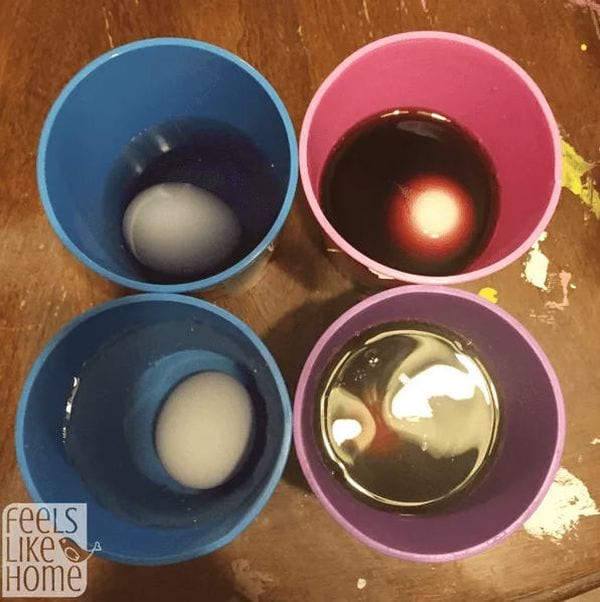
22. Explore how sugary drinks affect teeth
The calcium content of eggshells makes them a great stand-in for teeth. Use eggs to explore how soda and juice can stain teeth and wear down the enamel. Expand your learning by trying different toothpaste-and-toothbrush combinations to see how effective they are.
Learn more: Sugar and Teeth Experiment
23. Mummify a hot dog
If your kids are fascinated by the Egyptians, they’ll love learning to mummify a hot dog! No need for canopic jars , just grab some baking soda and get started.
24. Extinguish flames with carbon dioxide
This is a fiery twist on acid-base experiments. Light a candle and talk about what fire needs in order to survive. Then, create an acid-base reaction and “pour” the carbon dioxide to extinguish the flame. The CO2 gas acts like a liquid, suffocating the fire.
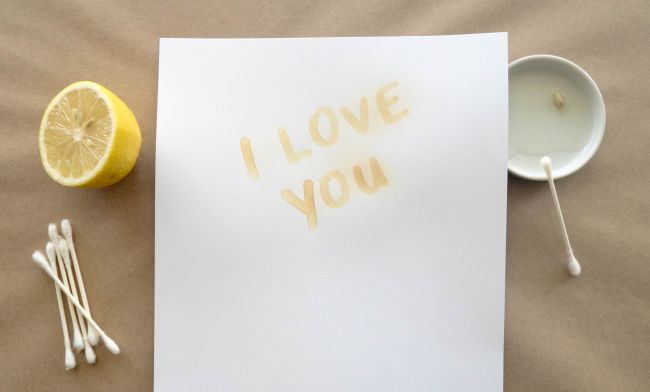
25. Send secret messages with invisible ink
Turn your kids into secret agents! Write messages with a paintbrush dipped in lemon juice, then hold the paper over a heat source and watch the invisible become visible as oxidation goes to work.
Learn more: Invisible Ink
26. Create dancing popcorn
This is a fun version of the classic baking soda and vinegar experiment, perfect for the younger crowd. The bubbly mixture causes popcorn to dance around in the water.
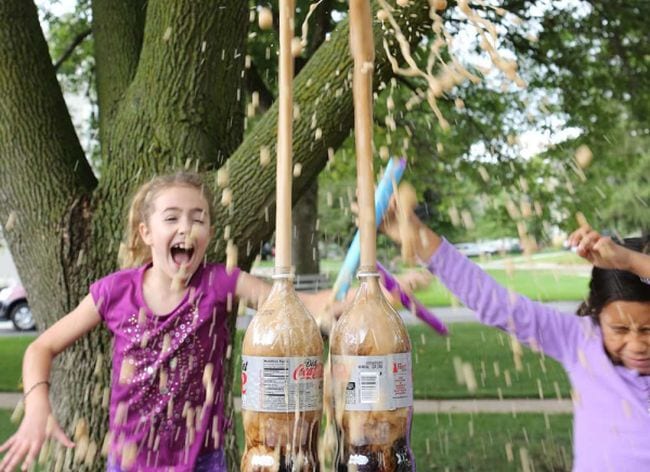
27. Shoot a soda geyser sky-high
You’ve always wondered if this really works, so it’s time to find out for yourself! Kids will marvel at the chemical reaction that sends diet soda shooting high in the air when Mentos are added.
Learn more: Soda Explosion
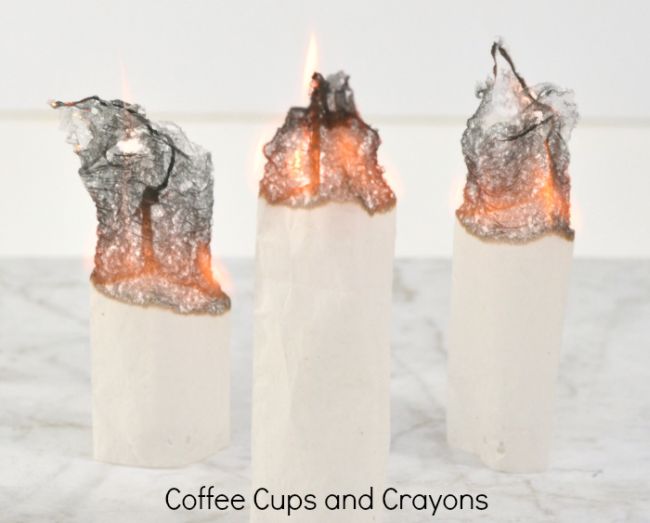
28. Send a teabag flying
Hot air rises, and this experiment can prove it! You’ll want to supervise kids with fire, of course. For more safety, try this one outside.
Learn more: Flying Tea Bags

29. Create magic milk
This fun and easy science experiment demonstrates principles related to surface tension, molecular interactions, and fluid dynamics.
Learn more: Magic Milk Experiment
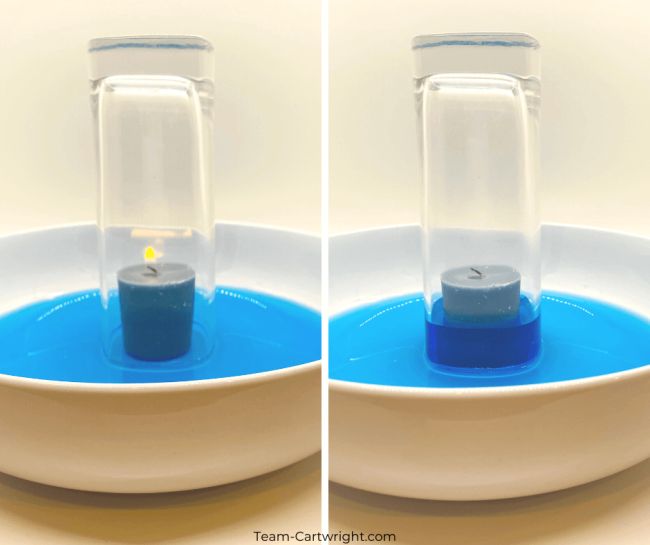
30. Watch the water rise
Learn about Charles’s Law with this simple experiment. As the candle burns, using up oxygen and heating the air in the glass, the water rises as if by magic.
Learn more: Rising Water

31. Learn about capillary action
Kids will be amazed as they watch the colored water move from glass to glass, and you’ll love the easy and inexpensive setup. Gather some water, paper towels, and food coloring to teach the scientific magic of capillary action.
Learn more: Capillary Action
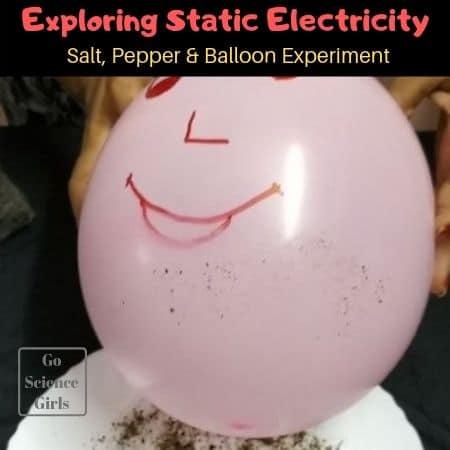
32. Give a balloon a beard
Equally educational and fun, this experiment will teach kids about static electricity using everyday materials. Kids will undoubtedly get a kick out of creating beards on their balloon person!
Learn more: Static Electricity

33. Find your way with a DIY compass
Here’s an old classic that never fails to impress. Magnetize a needle, float it on the water’s surface, and it will always point north.
Learn more: DIY Compass
34. Crush a can using air pressure
Sure, it’s easy to crush a soda can with your bare hands, but what if you could do it without touching it at all? That’s the power of air pressure!

35. Tell time using the sun
While people use clocks or even phones to tell time today, there was a time when a sundial was the best means to do that. Kids will certainly get a kick out of creating their own sundials using everyday materials like cardboard and pencils.
Learn more: Make Your Own Sundial
36. Launch a balloon rocket
Grab balloons, string, straws, and tape, and launch rockets to learn about the laws of motion.
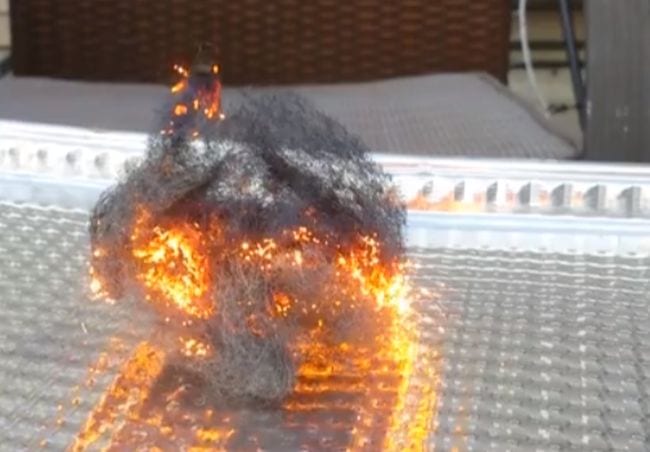
37. Make sparks with steel wool
All you need is steel wool and a 9-volt battery to perform this science demo that’s bound to make their eyes light up! Kids learn about chain reactions, chemical changes, and more.
Learn more: Steel Wool Electricity
38. Levitate a Ping-Pong ball
Kids will get a kick out of this experiment, which is really all about Bernoulli’s principle. You only need plastic bottles, bendy straws, and Ping-Pong balls to make the science magic happen.

39. Whip up a tornado in a bottle
There are plenty of versions of this classic experiment out there, but we love this one because it sparkles! Kids learn about a vortex and what it takes to create one.
Learn more: Tornado in a Bottle
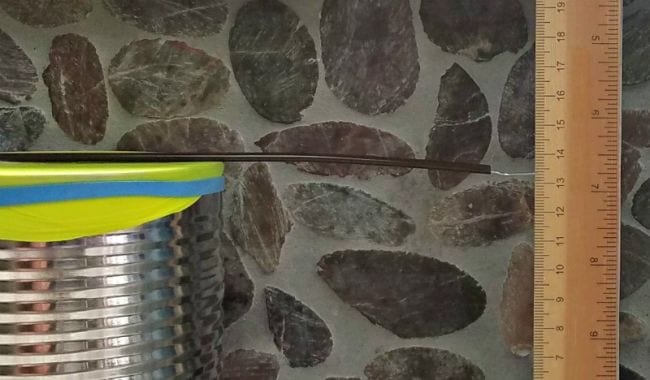
40. Monitor air pressure with a DIY barometer
This simple but effective DIY science project teaches kids about air pressure and meteorology. They’ll have fun tracking and predicting the weather with their very own barometer.
Learn more: DIY Barometer
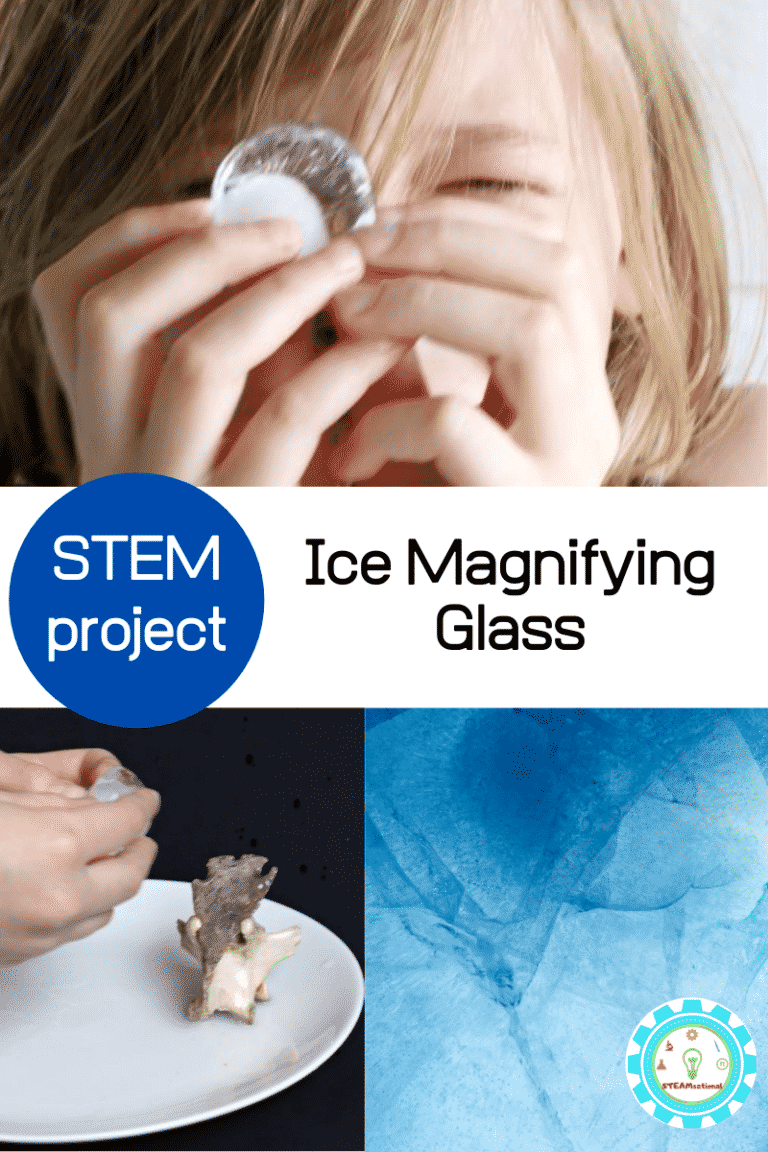
41. Peer through an ice magnifying glass
Students will certainly get a thrill out of seeing how an everyday object like a piece of ice can be used as a magnifying glass. Be sure to use purified or distilled water since tap water will have impurities in it that will cause distortion.
Learn more: Ice Magnifying Glass

42. String up some sticky ice
Can you lift an ice cube using just a piece of string? This quick experiment teaches you how. Use a little salt to melt the ice and then refreeze the ice with the string attached.
Learn more: Sticky Ice

43. “Flip” a drawing with water
Light refraction causes some really cool effects, and there are multiple easy science experiments you can do with it. This one uses refraction to “flip” a drawing; you can also try the famous “disappearing penny” trick .
Learn more: Light Refraction With Water
44. Color some flowers
We love how simple this project is to re-create since all you’ll need are some white carnations, food coloring, glasses, and water. The end result is just so beautiful!

45. Use glitter to fight germs
Everyone knows that glitter is just like germs—it gets everywhere and is so hard to get rid of! Use that to your advantage and show kids how soap fights glitter and germs.
Learn more: Glitter Germs
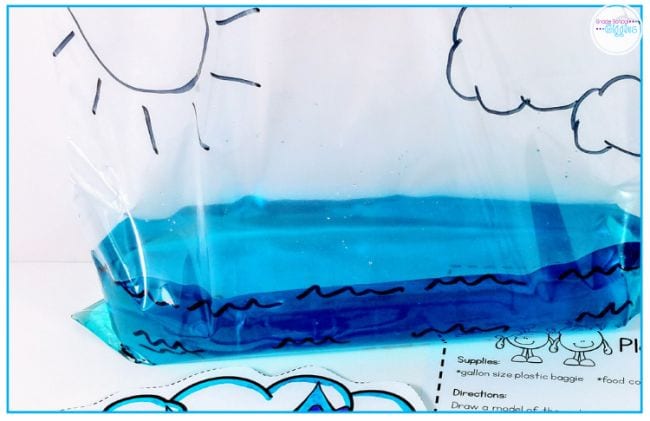
46. Re-create the water cycle in a bag
You can do so many easy science experiments with a simple zip-top bag. Fill one partway with water and set it on a sunny windowsill to see how the water evaporates up and eventually “rains” down.
Learn more: Water Cycle
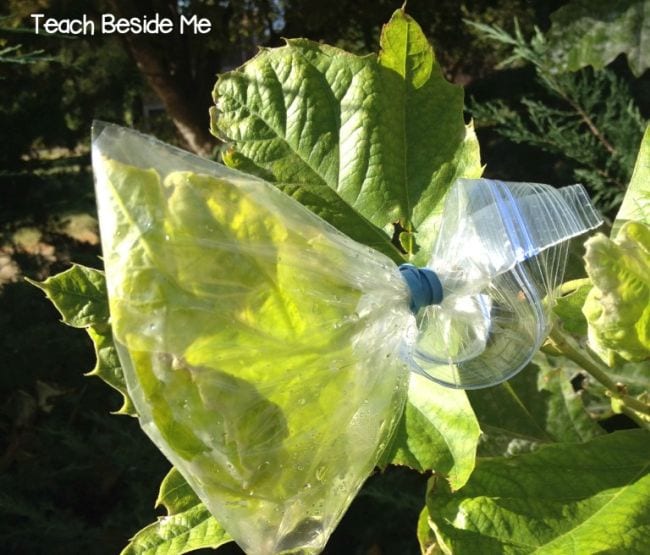
47. Learn about plant transpiration
Your backyard is a terrific place for easy science experiments. Grab a plastic bag and rubber band to learn how plants get rid of excess water they don’t need, a process known as transpiration.
Learn more: Plant Transpiration

48. Clean up an oil spill
Before conducting this experiment, teach your students about engineers who solve environmental problems like oil spills. Then, have your students use provided materials to clean the oil spill from their oceans.
Learn more: Oil Spill

49. Construct a pair of model lungs
Kids get a better understanding of the respiratory system when they build model lungs using a plastic water bottle and some balloons. You can modify the experiment to demonstrate the effects of smoking too.
Learn more: Model Lungs
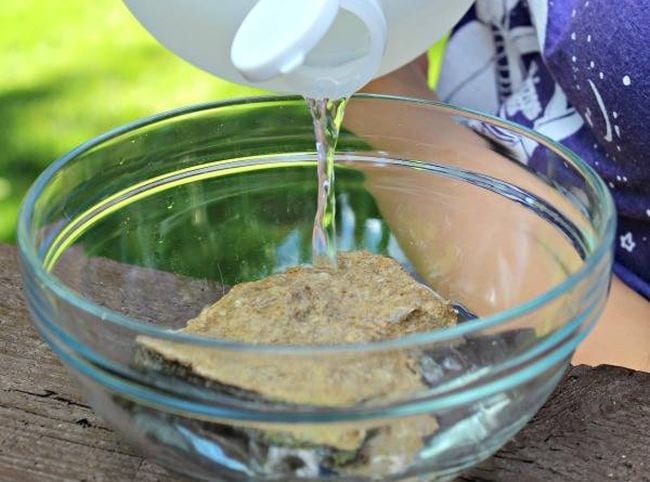
50. Experiment with limestone rocks
Kids love to collect rocks, and there are plenty of easy science experiments you can do with them. In this one, pour vinegar over a rock to see if it bubbles. If it does, you’ve found limestone!
Learn more: Limestone Experiments
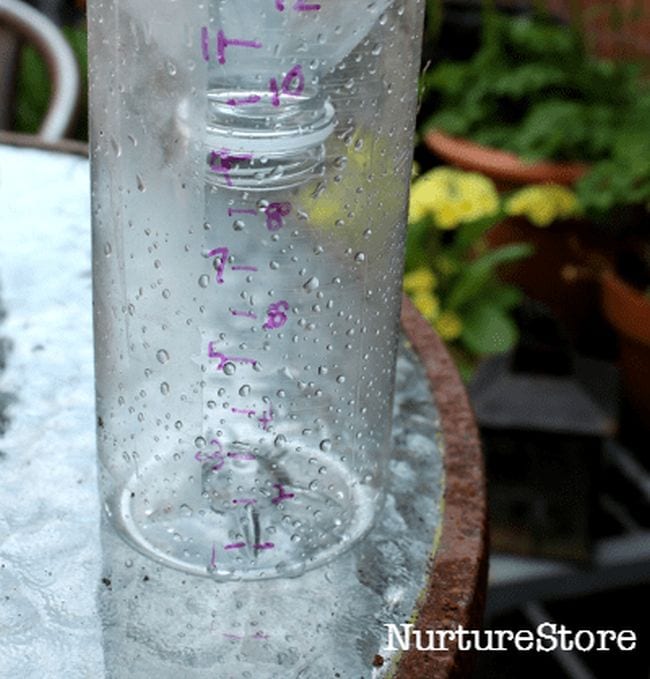
51. Turn a bottle into a rain gauge
All you need is a plastic bottle, a ruler, and a permanent marker to make your own rain gauge. Monitor your measurements and see how they stack up against meteorology reports in your area.
Learn more: DIY Rain Gauge
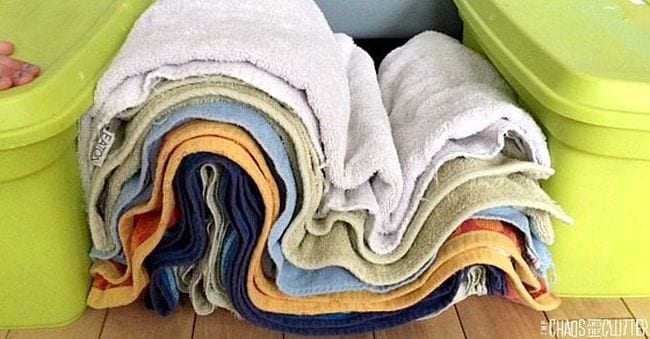
52. Build up towel mountains
This clever demonstration helps kids understand how some landforms are created. Use layers of towels to represent rock layers and boxes for continents. Then pu-u-u-sh and see what happens!
Learn more: Towel Mountains
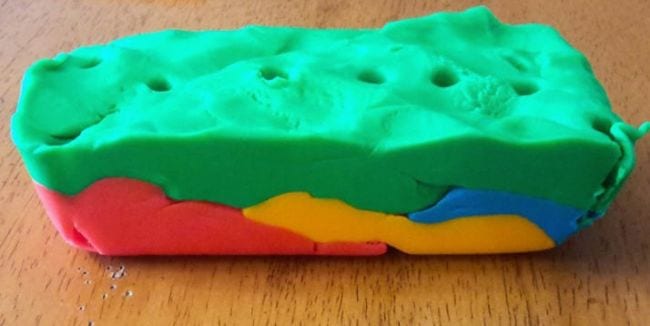
53. Take a play dough core sample
Learn about the layers of the earth by building them out of Play-Doh, then take a core sample with a straw. ( Love Play-Doh? Get more learning ideas here. )
Learn more: Play Dough Core Sampling

54. Project the stars on your ceiling
Use the video lesson in the link below to learn why stars are only visible at night. Then create a DIY star projector to explore the concept hands-on.
Learn more: DIY Star Projector
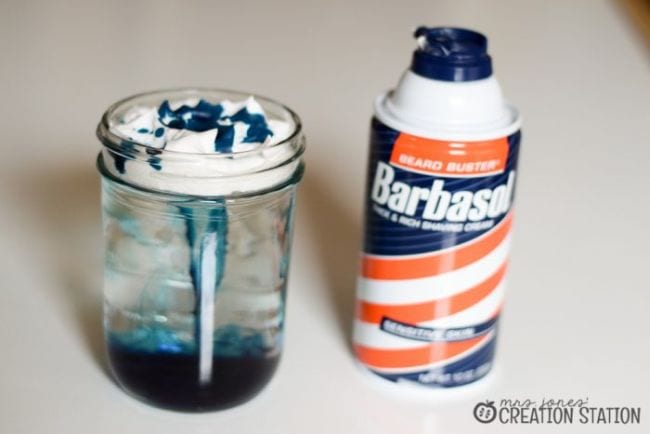
55. Make it rain
Use shaving cream and food coloring to simulate clouds and rain. This is an easy science experiment little ones will beg to do over and over.
Learn more: Shaving Cream Rain
56. Blow up your fingerprint
This is such a cool (and easy!) way to look at fingerprint patterns. Inflate a balloon a bit, use some ink to put a fingerprint on it, then blow it up big to see your fingerprint in detail.
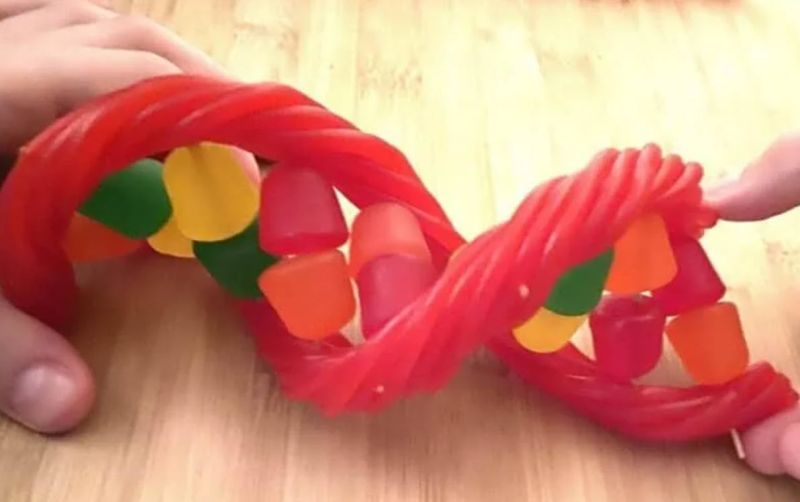
57. Snack on a DNA model
Twizzlers, gumdrops, and a few toothpicks are all you need to make this super-fun (and yummy!) DNA model.
Learn more: Edible DNA Model
58. Dissect a flower
Take a nature walk and find a flower or two. Then bring them home and take them apart to discover all the different parts of flowers.

59. Craft smartphone speakers
No Bluetooth speaker? No problem! Put together your own from paper cups and toilet paper tubes.
Learn more: Smartphone Speakers

60. Race a balloon-powered car
Kids will be amazed when they learn they can put together this awesome racer using cardboard and bottle-cap wheels. The balloon-powered “engine” is so much fun too.
Learn more: Balloon-Powered Car

61. Build a Ferris wheel
You’ve probably ridden on a Ferris wheel, but can you build one? Stock up on wood craft sticks and find out! Play around with different designs to see which one works best.
Learn more: Craft Stick Ferris Wheel
62. Design a phone stand
There are lots of ways to craft a DIY phone stand, which makes this a perfect creative-thinking STEM challenge.
63. Conduct an egg drop
Put all their engineering skills to the test with an egg drop! Challenge kids to build a container from stuff they find around the house that will protect an egg from a long fall (this is especially fun to do from upper-story windows).
Learn more: Egg Drop Challenge Ideas
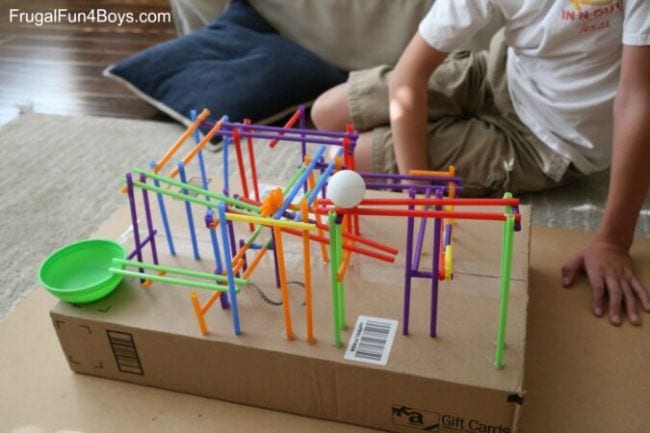
64. Engineer a drinking-straw roller coaster
STEM challenges are always a hit with kids. We love this one, which only requires basic supplies like drinking straws.
Learn more: Straw Roller Coaster
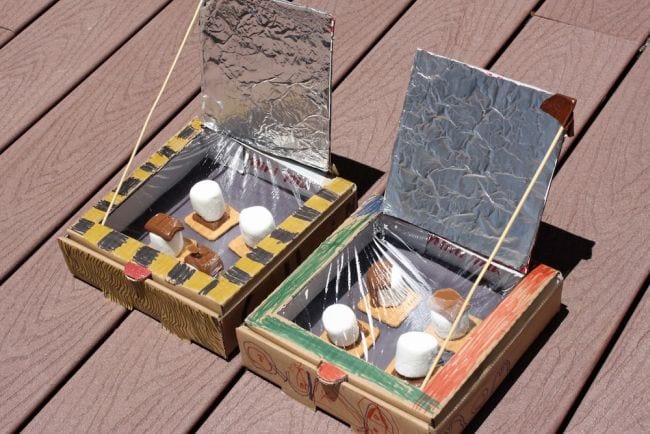
65. Build a solar oven
Explore the power of the sun when you build your own solar ovens and use them to cook some yummy treats. This experiment takes a little more time and effort, but the results are always impressive. The link below has complete instructions.
Learn more: Solar Oven

66. Build a Da Vinci bridge
There are plenty of bridge-building experiments out there, but this one is unique. It’s inspired by Leonardo da Vinci’s 500-year-old self-supporting wooden bridge. Learn how to build it at the link, and expand your learning by exploring more about Da Vinci himself.
Learn more: Da Vinci Bridge
67. Step through an index card
This is one easy science experiment that never fails to astonish. With carefully placed scissor cuts on an index card, you can make a loop large enough to fit a (small) human body through! Kids will be wowed as they learn about surface area.
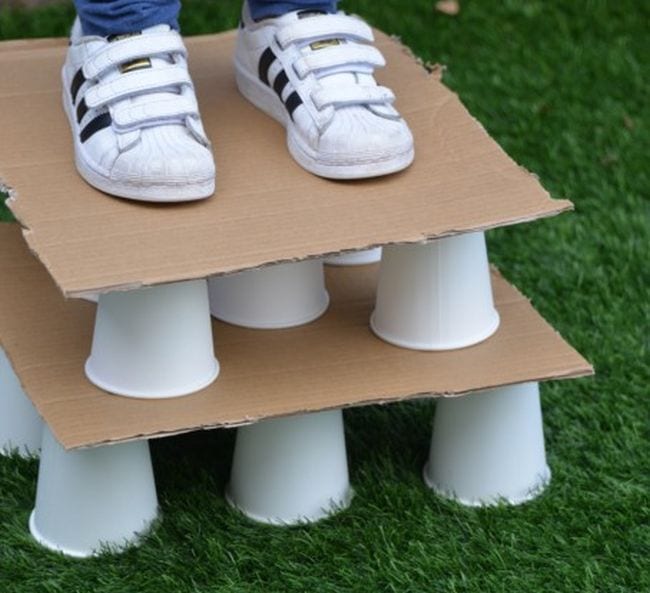
68. Stand on a pile of paper cups
Combine physics and engineering and challenge kids to create a paper cup structure that can support their weight. This is a cool project for aspiring architects.
Learn more: Paper Cup Stack
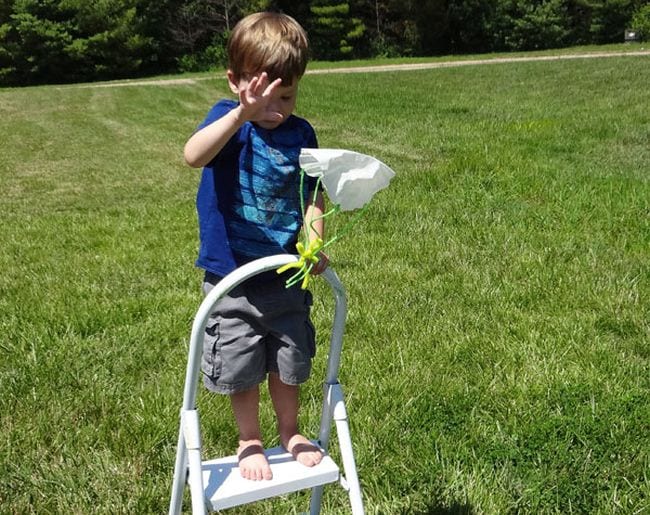
69. Test out parachutes
Gather a variety of materials (try tissues, handkerchiefs, plastic bags, etc.) and see which ones make the best parachutes. You can also find out how they’re affected by windy days or find out which ones work in the rain.
Learn more: Parachute Drop
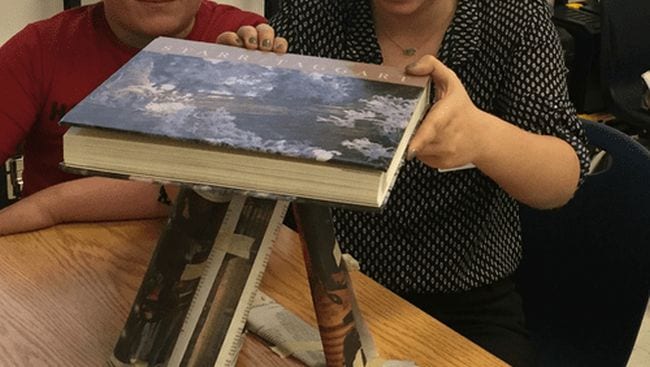
70. Recycle newspapers into an engineering challenge
It’s amazing how a stack of newspapers can spark such creative engineering. Challenge kids to build a tower, support a book, or even build a chair using only newspaper and tape!
Learn more: Newspaper STEM Challenge

71. Use rubber bands to sound out acoustics
Explore the ways that sound waves are affected by what’s around them using a simple rubber band “guitar.” (Kids absolutely love playing with these!)
Learn more: Rubber Band Guitar
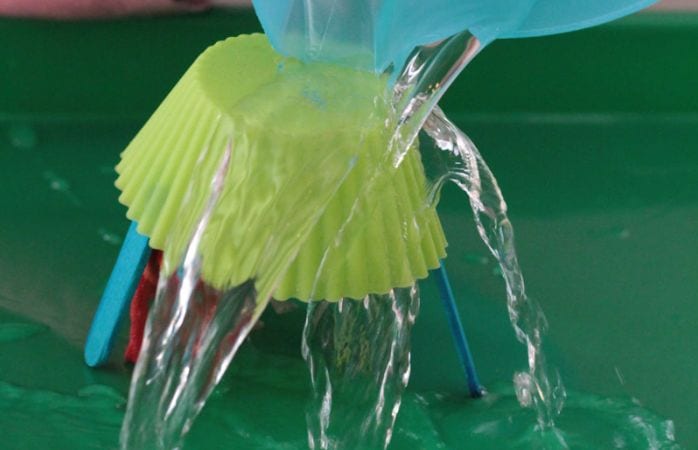
72. Assemble a better umbrella
Challenge students to engineer the best possible umbrella from various household supplies. Encourage them to plan, draw blueprints, and test their creations using the scientific method.
Learn more: Umbrella STEM Challenge
Plus, sign up for our newsletters to get all the latest learning ideas straight to your inbox.
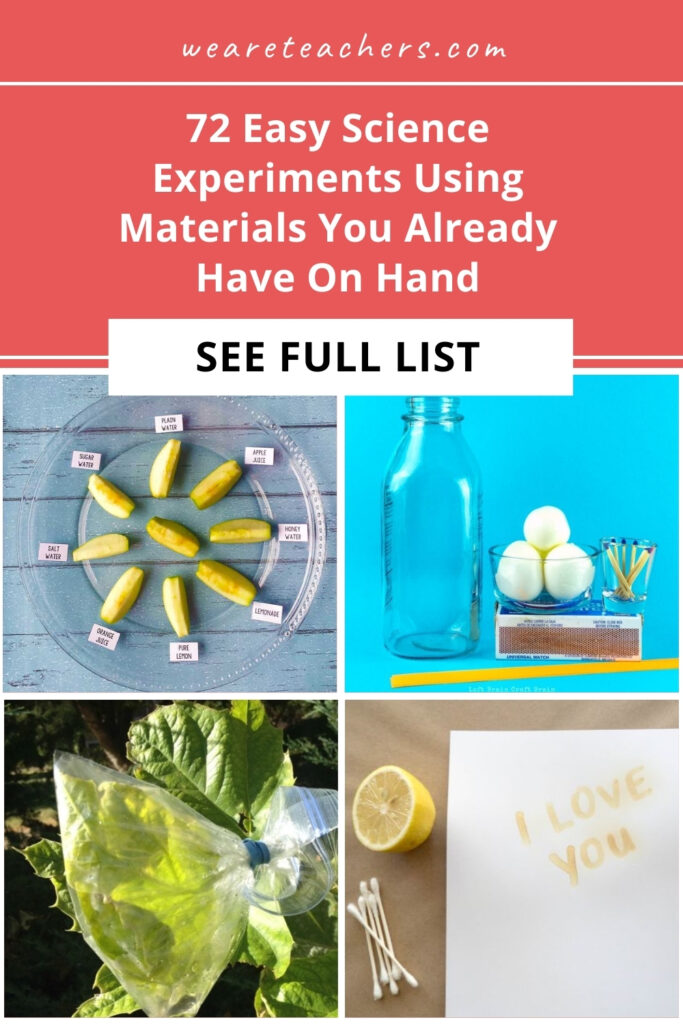
You Might Also Like
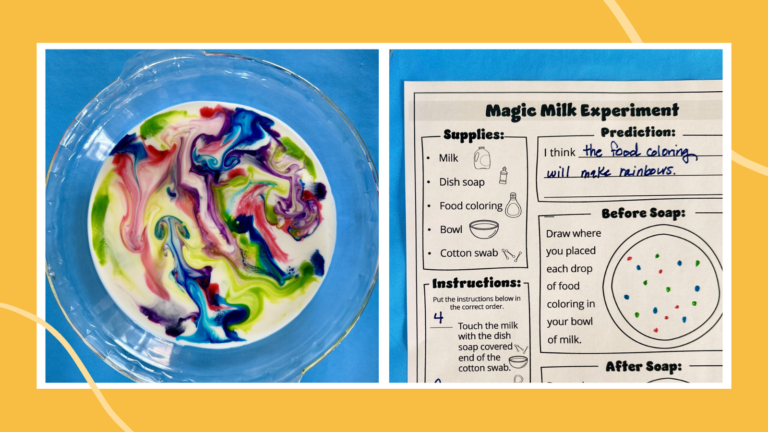
Magic Milk Experiment: How-To Plus Free Worksheet
This classic experiment teaches kids about basic chemistry and physics. Continue Reading
Copyright © 2024. All rights reserved. 5335 Gate Parkway, Jacksonville, FL 32256
Look! We're Learning!
Early Learning. Happy Teaching.
40 Simple Water Science Experiments for Kids
April 16, 2018 by Selena Robinson Leave a Comment
Sharing is caring!

Warmer weather means lots of water play and, for us, that means plenty of simple water science experiments to try with the kids!
Since we’ve been homeschooling, I’ve learned that science doesn’t have to be a complicated subject to teach.
Many scientific concepts sound complicated (and really are amazingly intricate), but showing kids how they work doesn’t have to be complex.

Turns out that you can use a few household supplies and demonstrate how scientific principles work in a kid-friendly way!
And that’s why I’ve rounded up 40 easy water science experiments that would be great to share with kids – either indoors or outdoors!
Don’t miss our list of science experiments that you can do in just 15 minutes too!

1. Simple Light In Water Refraction Experiment – Look! We’re Learning!
2. Milk Jug Water Wheel Experiment – J Daniel 4’s Mom
3. Float Vs Sink Experiment – Teach Me Mommy
4. Leak-Proof Bag Science Experiment – Fun Learning for Kids
5. How to Make a Lava Lamp – Coffee Cups and Crayons
6. Measuring Water Beads – Blue Bear Wood
7. Water Balloon Parachute – Fantastic Fun and Learning
8. Food Coloring Fluid Mechanics Experiment – Mama Smiles
9. Measuring Buoyancy Experiment – KC Edventures
10. Color Mixing Experiment – Science Sparks
11. Tide Pool Science Experiment – Buggy and Buddy
12. Floating Peep Boats – Sixth Bloom
13. Traveling Water Experiment – The Wise Owl Factory
14. Simple Water Displacement Experiment – Life with Moore Babies
15. Ripple Water Experiment – J Daniel 4’s Mom
16. Why Does Water Rise STEM Experiment – STEAM Powered Family
17. Make a Rain Cloud In a Jar – Coffee Cups and Crayons
18. Water Xylophone Sound Experiment – Little Bins for Little Hands
19. Growing Mint in Water – Sloely
20. Sticky Ice Experiment – Capri Plus 3

See more of these awesome simple water science experiments on page 2!

Leave a Reply Cancel reply
Your email address will not be published. Required fields are marked *
Save my name, email, and website in this browser for the next time I comment.
All Science Fair Projects
1000 science fair projects with complete instructions.

34 Water Experiments
Get ready to dive into some exciting water projects that will help you understand how incredible water is! Explore how water plays a vital role in plants, discover the special properties that make water unique and do fun chemical reactions with water! Dive in and discover the fascinating world of water!
Browse Water Experiments
Check out all the different water projects with complete instructions and videos. They're great for students' science fair projects and a fun way for kids to learn about the science of water!
More related science projects


25 Water Science Experiments and Activities!
This post may contain affiliate links.

Water is something we can all get our hands on. Following are 25 wonderful water science experiments and activities you can use in your teaching. These are great for extra warm days outside in the summer, or inside at any time of year. There is something about learning with water that gets kind excited!

1. Rising Water Science Experiment
This is a cool experiment that makes the water rise into the glass! It’ll wow your kids.

2. Water Chemistry Experiment with at Home Water Testing
Test your water with and at-home water testing kit. It’s fascinating to see what’s in the water near you.

3. Water Striders: Insect Science
This fun water experiment demonstrates how insects can glide on water.

4. Dry Ice Bubbles
Use dry ice, water & soap to make these amazing dry ice bubbles! This is the ultimate water science activity!

5. Water Science: Water Pump Sprinkler
This fun water science activity demonstrates how a sprinkler or a water pump work

6. Water Drop Maze
This is just all around fun!

7. Homemade Water Clock: Ancient Science
Did you know they used water clocks to tell time anciently? This is a cool history and science lesson in one.

8. Rainbow Walking Water Experiment
This is a classic water experiment that everyone loves!

9. Preschool Counting: How Many Drops to Fill the Dot?
Math and science with water? Yes, please!

10. Dissolving Science Experiment- What Dissolves in Water?
Learn what things dissolve in water. This is a great water science activity for your littler ones.

11. Colored Convection Currents Science Experiment
This water science experiment is cool and colorful! Watch conviction currents at work in colored water.

12. Science Art: Alcohol and Watercolor Painting
You know I love pairing s cience with art ! This project also involves watercolor painting. It’s beautiful & fun!

13. How to Make Oobleck: Water + Cornstarch
Mix water with cornstarch in this awesome sensory science activity.

14. Homemade Thermometer Science Experiment
Did you know you can make your own thermometer? This is a neat weather science activity that will fascinate everyone!

15. Homemade Straw Glasses
Ok so maybe we used juice, but it would work with water, too! These are so much fun to make with your kids! Learn the science behind how the liquid comes up through the straw, too.

16. Homemade Toy Rubber Band Boats
Wind up boats are the perfect water learning activity.

17. Submarine Science
Make your own mini submarine in this water science activity!

18. Magnet Boats
These simple little boats are a great water learning and play activity for kids.

19. Environmental Science: Oil Spill Clean Up Experiment
Learn about keeping our ocean water clean with this oil spill clean-up activity.

20. Water Filtration Experiment
This is a great activity to learn about how water filters work.

21. Sink or Float Water Science
I don’t have photos of this activity, but it’s a fun and easy one to do anytime. Gather some small objects- coin, rock, plastic toys, screws, beads, sticks, etc… Fill up the sink, or a large bowl with water. Before putting the objects into the water, have your child divide the objects out on the paper with the words Float, Sink according to their predictions. After you test them in the water have your child draw or write them onto the graph. You could easily make this chart reusable by laminating it. Click above on the picture to download the chart.
22. Water Xylophone
Make water music! We love this water learning and play activity.

23. Simple Science: Making a Solar Still
Filter water using the sun!

24. Blooming Paper Flowers
This little experiment is so much fun! Watch these paper flowers bloom in water!

25. Make Ice Boats & Learn Why Ice Floats !

26. Rain Painting

Former school teacher turned homeschool mom of 4 kids. Loves creating awesome hands-on creative learning ideas to make learning engaging and memorable for all kids!
Similar Posts

Teaching Money to Kids: The Money Game

Thanksgiving Color By Number Worksheets

Homemade Wind Vane or Weather Vane Science
Children’s music by mr. roberelli (giveaway).

Easy Mosaic Craft for Kids

Continent Fortune Teller
Water experiments are one of my favorites to do with little people. Such a fun science topic! Amie-from the HHH
what fun activities! I love the water music idea, I might have to try that one 🙂
That looks like such fun!
Lots of great ideas! I might have to try the water bottle idea. We have done the sink or float experiement here and the other day I found my son in the bathroom with a fork-he said he was playing sink or float. Lol.
Leave a Reply Cancel reply
You must be logged in to post a comment.
Get Your ALL ACCESS Shop Pass here →

30 Easy Water Experiments For Kids
Water experiments aren’t just for summer! Water is easy and budget-friendly for science learning with preschoolers, elementary-age kids, and even middle school science. Check out our list of our favorite science experiments with water and look for the free printable water themed science camp week guide!

SCIENCE EXPERIMENTS WITH WATER
What do all these science experiments and STEM projects below have in common? They all use water!
These water experiments, using simple household items like salt, are perfect for at home and in the classroom. Also, check out our science experiments with baking soda.
Let’s dig in if you want to explore science with water as the main ingredient! While you’re at it, make sure to check out more kid-friendly science experiments.

Easy Water Experiments For Kids
Click on each link below to explore cool experiments with water! Easy water experiments for elementary through middle school include concepts like the water cycle, buoyancy, density, and more.
This age group is beginning to learn about core concepts in chemistry , including states of matter, how different substances mix or interact, and the properties of different materials.
ICE IS NICE SCIENCE
Explore the solid forms of water and ice. Three great ice experiments perfectly highlight the scientific method!

ALKA SELTZER REACTION RATES
How does temperature affect reaction rate? All you need is different temperatures of water, and Alka Seltzer tablets for this quick experiment.
ALKA SELTZER BOAT EXPERIMENT
This experiment is a fun way to explore physics and chemistry with Newton’s Third Law of Motion. When the Alka Seltzer tablet reacts with water, it produces carbon dioxide which will propel the mini boat.
BENDING WATER
Can you bend water? Yes, you can with static electricity. Grab a balloon and some water to set up this easy experiment.
CANDLE IN WATER EXPERIMENT
Can you make the water rise by burning a candle under a jar? Grab a few simple supplies and find out.
CELERY EXPERIMENT
Here’s a simple explanation of how osmosis works with celery and water and a fun science demonstration!
COFFEE FILTER FLOWERS
Water is the main ingredient in this gorgeous but super easy combined science and art activity. Make a bouquet of colorful, coffee-filter flowers and explore solubility too!
COLOR CHANGING FLOWERS
This engaging color-changing flower experiment explores the concept of capillary action as your flowers magically turn from white to green. Easy to set up and perfect for a group of kiddos to do at the same time or as an interesting water science fair project.

CRUSHED SODA CAN EXPERIMENT
What happens when you heat and cool water inside a soda can?
DISSOLVING CANDY
There are all kinds of fun things you can dissolve in water!
DRY-ERASE MARKER EXPERIMENT
Is it magic or is it science? Create a dry-erase drawing and watch it float in water.
FREEZING WATER EXPERIMENT
Will it freeze? What happens to the freezing point of water when you add salt? Check out this easy water experiment to find out.
GROW A RAINBOW
A fun and colorful experiment that uses a paper towel, markers and water to demonstrate the process of capillary action.
GUMMY BEAR OSMOSIS LAB
Learn about the process of osmosis when you try this easy gummy bear osmosis experiment. Watch your gummy bears grow as you investigate what liquid makes them grow the biggest.

HOT AND COLD WATER EXPERIMENT
What happens when you mix hot and cold water? Learn about how changes in temperature affect the density of water.
HOW DO SHARKS FLOAT?
Explore buoyancy with this simple oil and water experiment.
HOW MANY DROPS OF WATER ON A PENNY?
All you need for this experiment are a few coins, an eyedropper or pipette, and water! How many drops fit on the surface of a penny? What else could you use? A bottle cap turned over, a flat LEGO piece, or another small, smooth surface! Take a guess at how many drops it will take and then test it out.
ICE FISHING
Did you know you can go fishing indoors with salt, string, and ice! Kids will have a blast!
ICE MELT ACTIVITIES
Playful hands on science and learning which is perfect for our preschoolers. Explore water science with one of these fun theme ice melt activities.
LEGO WATER EXPERIMENT
Build a dam from Lego bricks and explore the flow of water.
OCEAN CURRENTS
Build a simple model of the ocean currents with ice and water.
OCEAN LAYERS
Just like layers of the earth, the ocean has layers too! Have you ever wondered how you could see them without going scuba diving in the ocean? Explore the layers of the ocean with a liquid density tower experiment for kids.
OIL AND WATER EXPERIMENT
Do the oil and water mix? Explore the densities of liquids with this simple oil and water experiment.

PAPER TOWEL TEST
Set up an experiment to investigate which brand of paper towel will absorb the most water.
POTATO OSMOSIS LAB
Explore what happens to potato when you put them in concentration salt water and then pure water. Learn about osmosis when you try this fun potato osmosis experiment with the kids.
RAINBOW IN A JAR
Can you make a rainbow in a jar? This neat rainbow water experiment explores water density with just a few materials. Instead of salt we use sugar and food coloring to stack the colors of the rainbow.
PENNY BOAT CHALLENGE
Design a simple tin foil boat, and see how many pennies it can hold before it sinks in the water. How many pennies will it take to make your boat sink?
MAKE A PADDLE BOAT
Fill the kiddie pool or tun with water and make this DIY paddle boat for fun physics!

SALT LAVA LAMP EXPERIMENT
Explore what happens when you add salt to oil and water.
SALTWATER DENSITY EXPERIMENT
Can you make an egg float? Will different items sink in freshwater but float in saltwater? Compare saltwater to freshwater with a fun experiment with salt and water. Make your predictions and test your results.
SINK OR FLOAT EXPERIMENT
Check out what you have in the kitchen for an easy science experiment with water with some very interesting results!

SKITTLES EXPERIMENT
A super simple water science experiment with everyone’s favorite candy! Did you know you can try it with M&Ms too? You can also you those red and white mints, old candy canes, and even jelly beans!
SOAP POWERED BOAT EXPERIMENT
Explore surface tension as kids observe firsthand how soap influences the movement of a small boat on the water’s surface.
SOLID LIQUID GAS EXPERIMENT
Learn about the properties of solids, liquids and gases with this simple water experiment. Have fun observing how water changes from a solid to a liquid to a gas.
STRAW BOATS
Design a boat made from nothing but straws and tape, and see how many items it can hold before it sinks in the water. Explore buoyancy while you test out your engineering skills.
SUGAR CUBE EXPERIMENT
With this easy-to-setup experiment, investigate what materials will best absorb water and stop the sugar cube from dissolving in water.
TOOTHPICK STARS
Make a star out of broken toothpicks by only adding water. Learn about capillary action with a totally do-able water experiment.
WALKING WATER EXPERIMENT
Can water walk? Make a colorful rainbow with a little color theory mixed in too! This walking water experiment is super easy and fun to set up! Mason jars, plastic cups, or bowls will also work just fine for this experiment. Also try this walking rainbow variation.

WATER CYCLE IN A BOTTLE
Make a discovery bottle all about the water cycle. One of the best water science activities is one where we can learn more about one of the most important and necessary cycles on Earth, the water cycle!
WATER CYCLE IN A BAG
The water cycle is important because it’s how water gets to all the plants, animals and even us!! Learn about the water cycle with this easy water cycle in a bag experiment.
WATER DISPLACEMENT EXPERIMENT
Add this simple water displacement experiment to your science lesson plans this season. Learn about water displacement and what it measures.
WATER EVAPORATION EXPERIMENT
Dive into the evaporation process (a liquid changes to a gas) with this simple water evaporation experiment. Investigate how temperature, airflow, and surface area affect the evaporation rate.
WATER REFRACTION EXPERIMENT
Why do objects look different in water? A simple water experiment that shows how light bends or refracts as it moves through water.

WATER XYLOPHONE
A homemade water xylophone is perfect for exploring physics and sound science!
WATER ABSORBTION EXPERIMENT
This is a very simple and fun water experiment which is great for preschoolers. My son had a blast exploring what materials absorb water and what don’t.
WHAT DISSOLVES IN WATER
This is super simple chemistry using common items around the house to explore mixtures and discover which items dissolve in water !
Compare how fast different everyday items melt in the sun, including ice cubes. A fun experiment to do in the summer!
WATER WHEEL
Hop on this engineering project and design a water wheel that moves! Use our idea as a springboard to create your own or follow the step-by-step directions.
WATER CLOCK
Find out how to use water to tell the time with this water clock project .

Plan a Water Summer Science Camp
Grab this free guide and plan a day or two of water theme science camp activities . We have 12 free guides, each with a different theme! Use them all year long.
More Easy Science Experiments with Water
- States of Matter Experiments
- Surface Tension of Water Experiments
- Chemistry Experiments
- Physics Experiments
- Fizzing Experiments
- Physical Changes
- Capillary Action Experiments
Printable Science Projects Pack
If you’re looking to grab all of our printable science projects in one convenient place plus exclusive worksheets and bonuses like a STEAM Project pack, our Science Project Pack is what you need! Over 300+ Pages!
- 90+ classic science activities with journal pages, supply lists, set up and process, and science information. NEW! Activity-specific observation pages!
- Best science practices posters and our original science method process folders for extra alternatives!
- Be a Collector activities pack introduces kids to the world of making collections through the eyes of a scientist. What will they collect first?
- Know the Words Science vocabulary pack includes flashcards, crosswords, and word searches that illuminate keywords in the experiments!
- My science journal writing prompts explore what it means to be a scientist!!
- Bonus STEAM Project Pack: Art meets science with doable projects!
- Bonus Quick Grab Packs for Biology, Earth Science, Chemistry, and Physics
- Science Fair Project Pack with experiments to try!

this site is the best i got an A on my assignment
- Pingback: Salt Water Density Experiment For Kids | Little Bins for Little Hands
- Pingback: Summer Science Camp Ideas And Activities | Little Bins for Little Hands
- Pingback: The BEST Very Simple Science Experiments for Kids to Try Anywhere
Comments are closed.

Subscribe to receive a free 5-Day STEM Challenge Guide
~ projects to try now ~.


Easy Water Science Experiments for Kids
By: Author Susanne Williams
Posted on Published: May 3, 2022 - Last updated: December 30, 2023
Here is a full list of our 25 Best Science Experiments With Water .
From growing a rainbow through to sink and float experiments, or a water cycle activity. There is a lot to explore and learn at home and in the classroom.
Let’s dive right in and get inspired!

There are affiliate links in this post, meaning, at no additional cost to you, I will be compensated if you click through and take action. As an Amazon Associate, I earn from qualifying purchases.
Table of Contents
Simple water science experiments for kids, best science kits for kids, pin these science projects with water.
Play, explore, and learn. This is the slogan of our list of fun science projects with water. Here you will find simple experiments with water to do at home or in a school setting.
They are all easy to manage and do not need a lot of preparation. Most of these water science experiments are suitable for preschoolers and older children.
Go check out our fun list of the 25 Best Water Science Experiments for kids now:
Are you interested in more kid’s activities, arts & crafts, and science experiments? I have made it easy for you! Simply join our newsletter now and I will send you new fun for kids. Subscribe for free
Best Water Science Experiments for Kids
Go check out our full list of fun STEM water projects for preschoolers and older kids.
The link below brings you directly to the instructions and will explain everything you need to know about the science behind these fun experiments with water.
Let's get started:

Fizzy Ice Cubes Water Experiment for Kids
Playing with water is so much fun. To make it more interesting, make some fizzy ice cubes for your kids.
It will help them stay cool during the hot summer. It is such a fun experiment with water!

Sherbert Water Science Experiment
For this cool water science project, you will need Sherbert.
The article will show you how much oxygen Sherbert can produce and explain the science behind it for you!

DIY Rainbow Cloud
Our rainbow cloud is such a cool science experiment about water. It helps you to learn and understand our water cycle on Earth.

Cool Water Experiment for Kids: Grow a Rainbow
Let's stay at our weather activities and learn how to make grow your own rainbow. I tell you it is super simple but so much fun.
Give it a try!

Water Experiment with Explanation: Dancing Grapes
Dancing Grapes is on the other hand a totally different STEM water project. By letting grapes dance it explains to you how air can move objects.
It is set up in 5 minutes and needs only 2 ingredients. Super simple right?

Skittles Experiment
This skittle STEM water acitivity is a classic! All you need is skittles and water and you are good to go.
You can make different patterns or even just use red and blue once for American holiday activities such as 4th of July or Memorial Day.

Surprise Egg Project
Have fun with the classic sink or float experiment, with a twist. Use surprise eggs to add an extra element of excitement to this activity

Water Cycle Bag Activity
See how water transforms through the water cycle with this simple water cycle bag experiment.
You have everything in your kitchen right now to get started

Simple Water Experiment: Snowstorm in a Jar
Did you know you can make a miniature blizzard right in your own kitchen?
Check out this cool science experiment that lets kids create a snowstorm in a jar!

Sink or Float Science Experiment with Water
This water experiment for preschoolers is so much fun. They can experiment with different toys or materials if they sink and float.
It is super easy but so much fun, you will see.

Magic Water Crystals
Experiment with water and salt by making beautiful crystals! Only three ingredients are needed!

Rainbow Walking Water Science Experiment for Kids
Walking water is such a fun STEM water project. It gives your children the chance to learn about colors and how they are mixed. They will see with their own eyes and remember better.

Bottle Crush
This is such a cool magic trick, isn't it? Learn how to crush a bottle with your own mind and science. Go find out how it works here.

Lava Lamp Water Science Experiment
This is a very simple water science experiment for kids.
Within 5 minutes, they can make their own lava lamp and calm down while watching the oil flow in the water.

Pepper and Soap STEM Project
This pepper and soap STEM activity is a great water science fair project.
You can show your classmates and family members fast how soap reacts with pepper and water and explain the science about it.

Glowing Water Science Experiment
Let's make some glowing water. This fun water STEM activity is especially popular during Halloween but can be used all year round.

Fireworks in a Glass
Did you make your own Firework in a jar yet? It is so much fun and if you use blue and red it makes such a great 4th of July STEM activity for preschoolers or at home. Give it a try!
More Science Experiments with Water
If these water experiments for kids weren't enough go check out the following experiments with water:
- Floating Eggs Water Experiment
- Rippel Effekt Experiment
- Water Experiment with Milk Jug
- DIY Lava Lamp
- Sand Filter Experiment with Water
- Water Pollution Experiment for Kids
- Oil and Water Science Experiment
- Water Balloon STEM Activity
- Traveling Water Experiment for Kids
- Under Water Sound STEM Experiment
You might also enjoy these Edible Glass Science Project , Crystal Snowflake Ornaments – DIY Borax Science Experiment , or check out these cool Water Toys instead.
Are you a visual learner? Then check out this great video with these 25 easy science water experiments for your home:
You do not have all the ingredients at home for our fun science projects with water? Or do you simply like the convenience of a science kit where you have everything in one place?
No problem here is a list of the Best Science Kits for Kids for you:
- National Geographic Sensory Experiment Set
- Primary Science Lab Set Deluxe
- Science Kit for Kids
- Doctor Jupiter My First Science Kit for Kids 4-6-8 Years Old
Why bother with science experiments? Here you can find 8 Benefits of STEM Education and why it is so important for kids.
Now I would like to hear from you! Did you try any of those simple science experiments with water? Which one is your favorite? Either way, let me know by leaving a comment below right now. I would love to hear from you!
Don’t forget to save these 25 Easy Science Projects with Water on Pinterest for later! Be sure you are following along with Lil Tigers.
- Activities for Kids
H2Oh! 7 Easy Science Experiments That Use Water

As soon as kids can reach a faucet, it seems they are drawn to splashing around in the water—much to the chagrin of your kitchen floor. Turn your little bit’s intrigue into intellect with these simple water-based science experiments for kids that you can do at home

Cloud in a Jar
What you need: A jar with a lid, 1/3 cup hot water, ice, hairspray.
How to: Pour hot water into jar. Place lid upside down on top of jar. Place a handful of ice cubes on the lid and let sit there for approximately 20 seconds. Remove the lid and quickly spray a spritz of hairspray into the jar. Replace the lid with the ice on top back onto the jar, and watch as a cloud forms inside the jar. When a good amount of condensation forms, remove the lid and watch as the cloud escapes.
How it works: Some of the warm water in the jar turns to water vapor as it rises to the top of the jar and comes into contact with cold air. Water vapor condenses as it cools and a cloud forms when the vapor has something to stick to (i.e. pollution...or hairspray).
photo: Gift of Curiosity

Have you tried any cool water science experiments with your kids?
—Ayren Jackson-Cannady
RELATED STORIES:
Classic Science Experiments for Kids
Awesome Sidewalk Science Experiments
Edible Science Experiments Worth a Taste-Test
Gross-but-Cool Science Experiments for Kids
Science Experiments About Floating & Density
Need some fresh ideas?
Subscribe to our weekly newsletter for expert parenting tips and simple solutions that make life instantly better.
By subscribing you agree to Tinybeans Terms and Privacy Policy
Related reads

Why Are Gen Z Kids Covering Their Noses in Family Photos?

Screen Time for Babies Linked to Sensory Differences in Toddlerhood, Study Shows

Kids Shouldn’t Have to Finish Dinner to Get Dessert, Dietitian Explains

The Questions Parents Should Be Asking Their Pediatrician—but Aren’t

6 Better Phrases to Say Instead of ‘Be Careful’ When Kids Are Taking Risks
- your daily dose

- and connection

- Your daily dose


STEM Water Projects and Science Experiments For Kids
50+ STEM Water Science Experiments and STEM Projects for Kids in Elementary – play, educate and grow with nature’s favourite drink
Water is one of the greatest mediums for exploring science. It’s easy to work with, it’s readily available, it’s safe and kids love playing with it. It is impossible not to have fun while learning with water. Are you looking for some great ideas for water projects in your class, homeschool or home? Find inspiration on this list of over 50 fun science experiments and water projects for kids!
The Best Water Science Experiments for Kids
What you will discover in this article!

Disclaimer: This article may contain commission or affiliate links. As an Amazon Influencer I earn from qualifying purchases. Not seeing our videos? Turn off any adblockers to ensure our video feed can be seen. Or visit our YouTube channel to see if the video has been uploaded there. We are slowly uploading our archives. Thanks!
To make navigating this resource easier, I have divided all of our water projects and STEM activities into some general categories.
CHEMISTRY WATER EXPERIMENTS
Bath Bombs or Bath Fizzies are the ultimate in bath time fun! They are also an exceptional chemistry experiment. You can simply make a bath bomb and see how water is the magic ingredient to trigger the reaction, or do a science experiment exploring the effect of water temperature on bath bomb reactions .

Water Lab Exploring Safe Drinking Water is a science experiment that turns students into water testers with an eye for safety. Using water sources around your home or school you can easily set up this activity and in the process learn a valuable lesson about how precious safe water is for families everywhere. For more testing ideas you can check out this article .
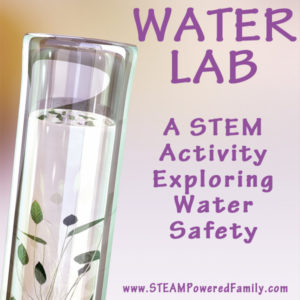
What’s the difference between baking soda and baking powder? Learn the answer in this experiment. Take water and add sodium bicarbonate or baking powder. Watch the results to see something spectacular!

Super Simple Chemistry is a kid favourite activity that explores how different substances mix with water. Not everything dissolves, start exploring these ideas with this simple activity.
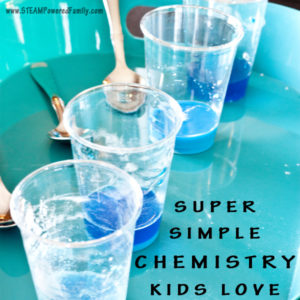
Learn about pH (acidic and basic) properties with this fun fluids experiment that uses items from your kitchen to create a fascinating lab study.

Elephant Toothpaste might not seem like a water science experiment at first, but this activity is actually really cool because one of the by products of the chemical reaction is water!

WATER PROJECTS EXPLORING DENSITY
Skittles Experiments require only two things – Skittles and Water. It may be simple, but this is one water experiment that is stunningly gorgeous and will have kids begging for more science time! With our study we brought in Vincent van Gogh’s Starry Night as a way to see fluid dynamics in action.

The classic oil and water experiment is a fascinating way to introduce students the density, and in this experiment the results are beautiful!
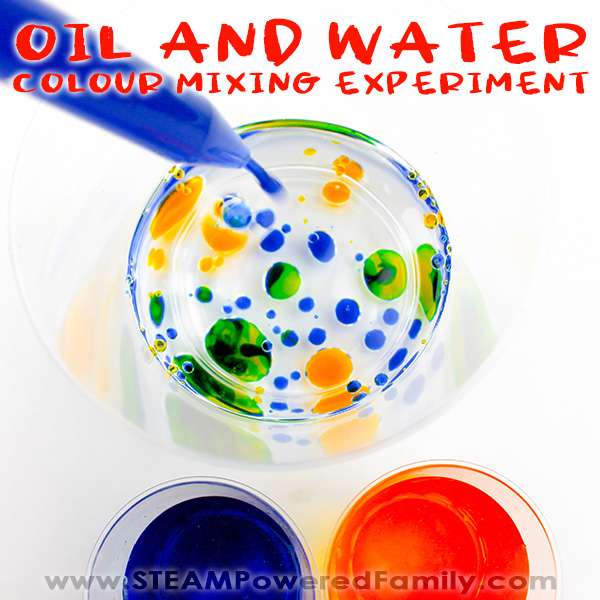
Marble Run Density Project is a simple activity that explores the density of different liquids using marbles. It’s fun and accessible for all ages. Everyone loves a good race!
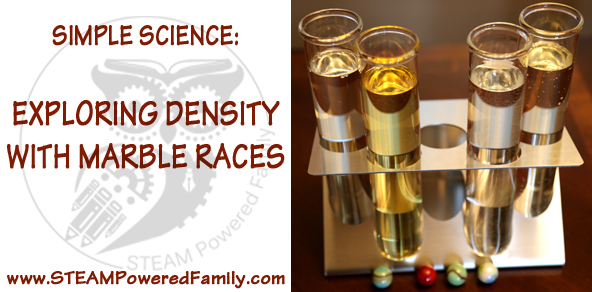
Does It Float – Pop Can edition is a fascinating activity that demonstrates how the density of different canned drinks affects whether they float or not. The results are fun and this makes for a great activity during camp outs.
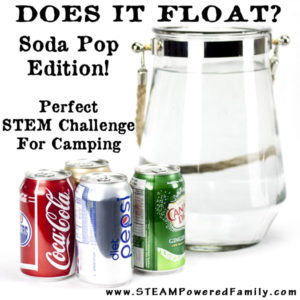
Teaching The Scientific Process With Water Balloons – This is a fantastic idea for learning how to create scientific proof by exploring the science behind the “does it float pop can edition” experiment.

COLOURFUL WATER PROJECTS
Chromatography Flowers is a super easy activity that even little kids will be able to do with minimal adult help. Watch how water helps colours travel through the coffee filter making pretty designs. For older kids, take the challenge up a level and light up your flowers with a simple circuit building activity.

Walking Rainbow – This was our attempt at the walking rainbow experiment but when things went wrong it became a whole new and exciting water science lesson.

WINTER THEMED WATER PROJECTS FOR KIDS
It’s time to get chilly with this mind bending experiment. In Snow and Ice Simple Science – Melting Magic we ask kids to predict the outcome of a test that will have them saying WOW! when they see the outcome.

Why does salt melt ice? This STEM activity dives into some great winter science as it explores how salt affects ice.
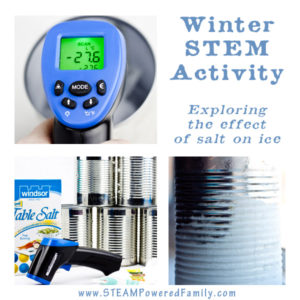
Live somewhere cold? Explore the Mpemba Effect in a spectacular way as you create snow.

Bottle Crush is a project that will have kids asking to go outside on a cold winter day over and over again. Like magic, kids will learn how to crush a plastic bottle without touching it, astounding their friends and family.
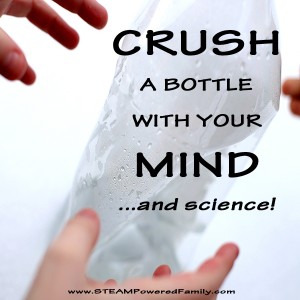
Ice Fishing Science Experiment – What is more winter than Ice Fishing? In this fun, hands on science, kids learn how salt and water interact as they go fishing for the big catch! A great challenge for a classroom or summer camp.
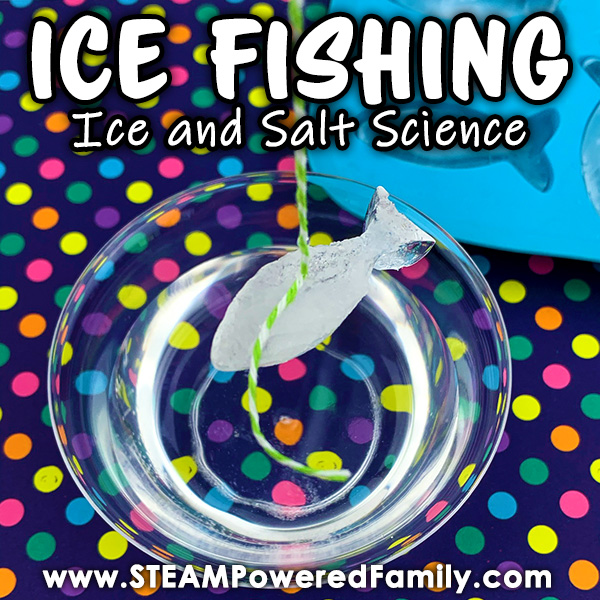
SWEET WATER SCIENCE
Slurpee Science Continue exploring the power of salt and water with states of matter changes with this experiment that ends with a tasty treat.

Layered Lollipops is a fascinating study into density. Makes a beautiful experiment that smells amazing!

Lego Gummy Mummies is a project that explores what happens when water is removed, also known as desiccation which is part of the mummification process. It’s also an experiment using candy minifigs, so kids love it!

ENGINEERING WITH WATER PROJECTS
Build A Water Clock and learn a bit about history with this easy STEM project. This project can be scaled for use by kids of all ages.
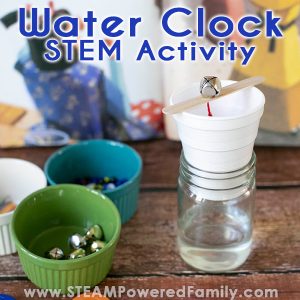
Ice STEM Projects explore all the amazing things you can do when water enters a solid state, better known as ice! The dinosaur ice sculpture is just too cute and kids will love engineering their own ice creations.

Build a Compass and embrace your inner Einstein! Witness the invisible forces that captured a young Einstein’s imagination and led to a lifetime of incredible discoveries.
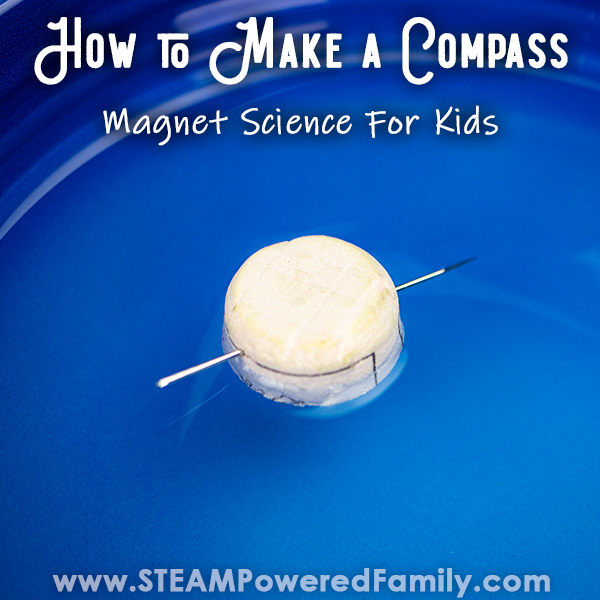
Build a Heart Model filled with water (aka blood) and explore how the blood moves around the heart.
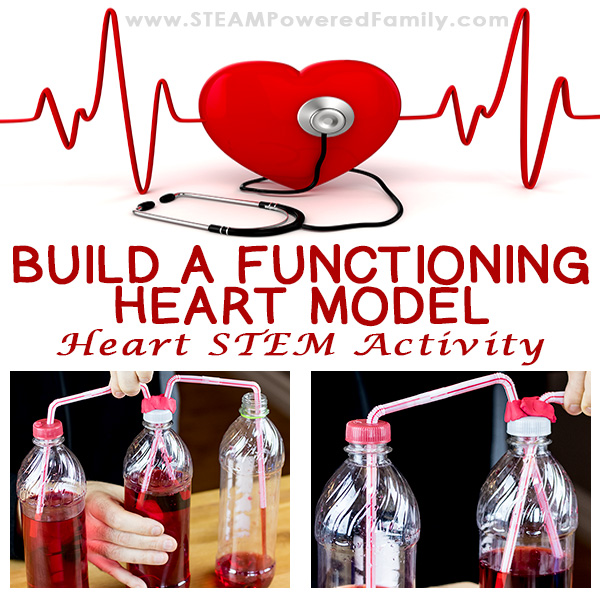
Engineer An Ice Lantern , perfect for the holidays.

WATER PROJECTS THAT ARE LIKE MAGIC
Chasing Hearts – This science experiment is like magic as you explore science and physics principles, all while playing a fun game!

Keep it Dry – A slight of hand activity that kids of all ages love to take a turn at. Become a magical scientist!

Why Does Water Rise? is an activity that is like magic! Kids love this STEM Activity that involves a little tech in the investigative process.
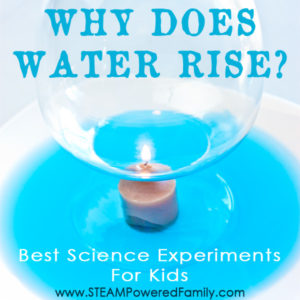
Build a Leak Proof Bag that is filled with water and pierced through with tons of pencils? Sounds impossible, but it’s not if you know the science!
ENVIRONMENTAL WATER PROJECTS FOR KIDS
Students get hands on with a major threat to our marine environments in this Oil Spill Cleanup Experiment .
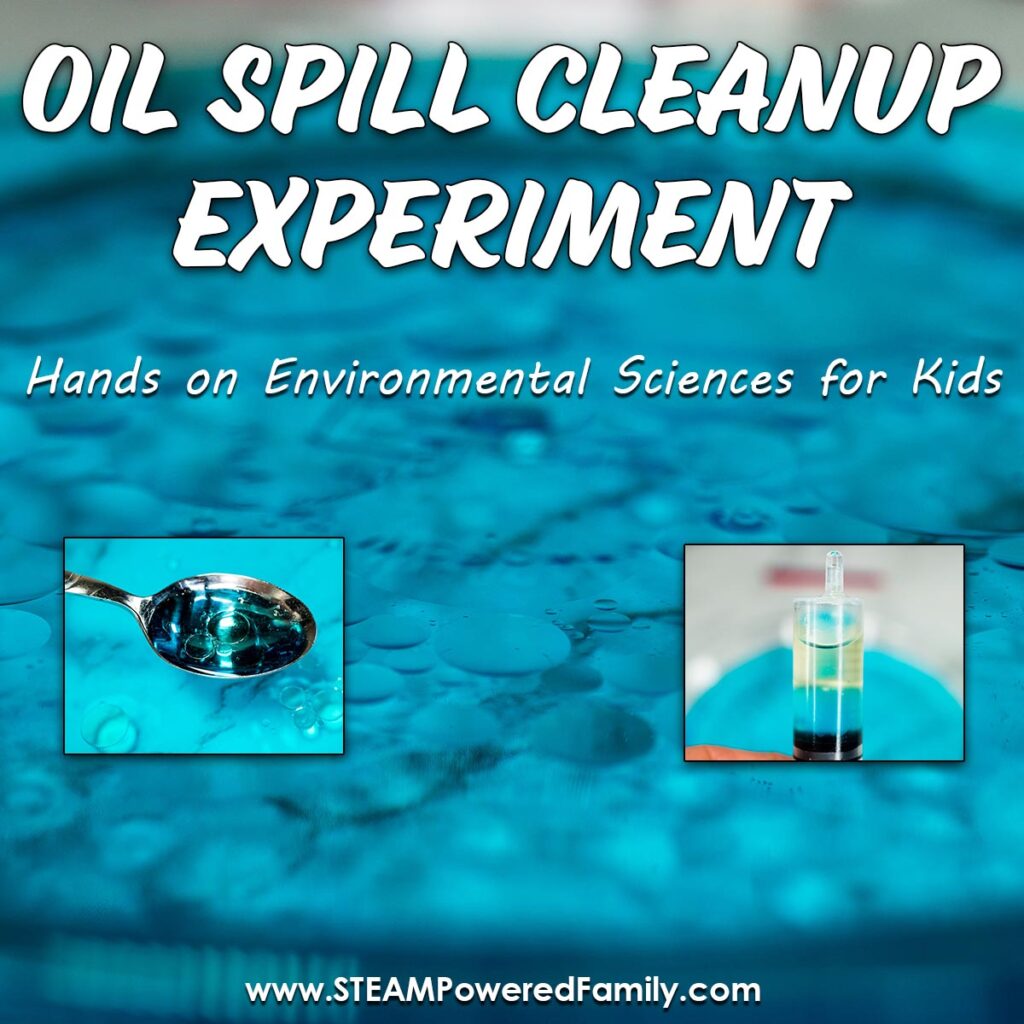
Learn about the Water Cycle in this simple science experiment in a jar. Perfect for students or as a classroom demonstration.

In this experiment, explore how acid rain affects plant life . It is a simple experiment with powerful results.

Next, we explore how water pollution affects plants . This is a simple experiment exploring the effects of water pollution in two different ways. Students learn about osmosis, pH and the scientific method.

The Water Desalinization Project is a interesting activity that explores how to remove the salt from salt water making it safe to drink.

This Fish Diving Activity is a neat way to explore how fish use air to help them move around underwater. A similar activity involves creating a Cartesian Diver .
SENSORY WATER PROJECTS
DIY Play Dough Bubble Bath is not a water project exactly, but it’s an inexpensive way to create some bubble bath play dough. Perfect for doing water projects with kids in the bath tub or at a water table.

Oobleck is a captivating activity to explore the difference in liquids. With the addition of one ingredient to water you create the most bizarre substance. Oobleck projects are an excellent addition to the study of states of matter and the senses. We LOVE playing with Oobleck and have created dozens of fun ways to explore this non-Newtonian Fluid.
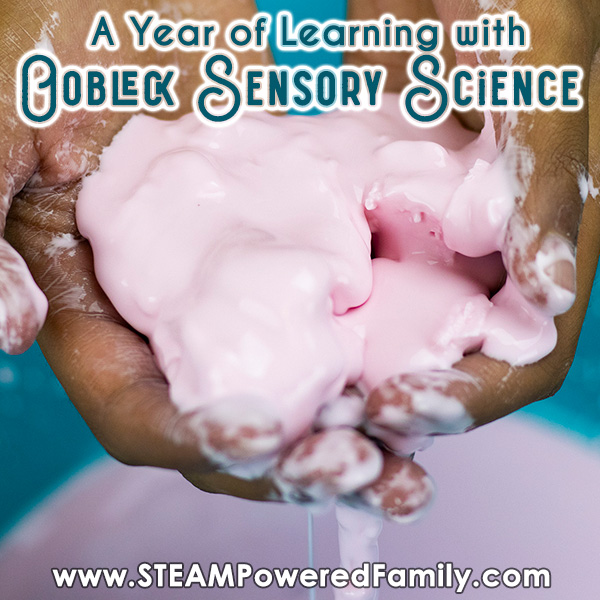
DIY Soap Projects , especially Soap Jellies are a fantastic sensory experience that will encourage kids to get clean! They are so much fun, and super easy to make. For an incredible cross study, make our DIY Layers of the Ocean soap and learn about the ocean with this gorgeous and easy soap making project.

More Water Science Experiments
Explore why the Sky Changes Colour in this fascinating and simple science project demonstrating how the skies change colour during sunrise and sunset.

Another great project is the Rainbow Rain Project . Students will create a stunning display of colour in a jar to explore how clouds (made with shaving cream), hold and release moisture, creating rain! This project is GORGEOUS and so simple.
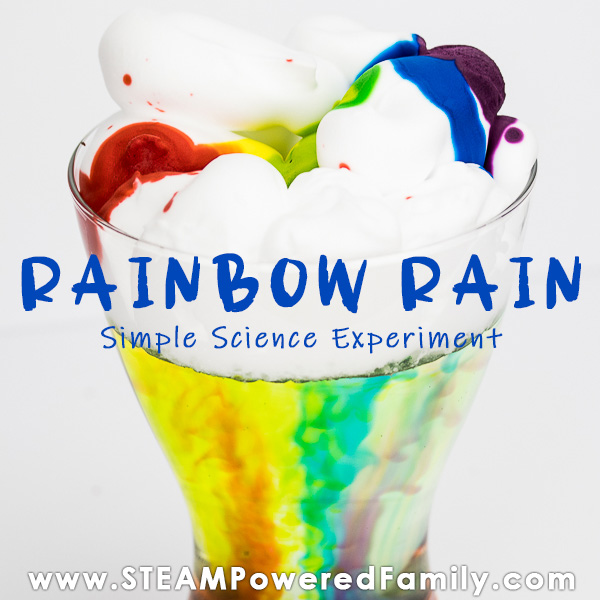
Magic Glitter is a cool experiment that is also a powerful demonstration on how soap works and why it is so important to wash your hands with soap.

Have fun learning with nature’s most valuable liquid – water!

5 Days of Smart STEM Ideas for Kids
Get started in STEM with easy, engaging activities.
Science Fun
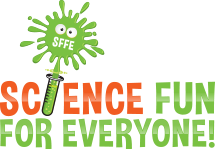
Water Science Experiments
Water science experiments you can do at home! Click on the experiment image or the view experiment link below for each experiment on this page to see the materials needed and procedure. Have fun trying these experiments at home or use them for SCIENCE FAIR PROJECT IDEAS.
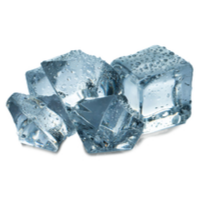
Catch An Ice Cube:
Frozen Water Is A Lot Of Fun

Make A Rainbow:
Refract Water And Make A Mini Rainbow
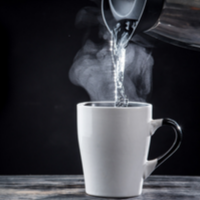
Which Water Leaks Faster?:
See If Hot Or Cold Water Drips Faster
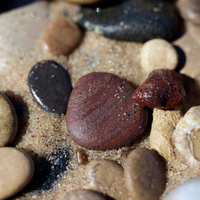
Make A Water Filter:
Can You Make Clean Water With Sand And Pebbles?
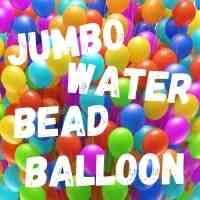
Jumbo Water Bead Balloon:
Make A Strange And Unique Item
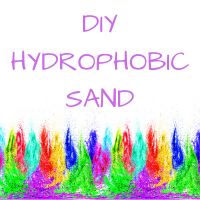
DIY Hydrophobic Sand:
Make Sand That Is Scared Of Water

Fabulous Floating Rocks:
Can Rocks Really Float?

Storm in a Glass:
Model of Rainstorm in a Glass
- Skip to primary navigation
- Skip to main content
- Skip to primary sidebar
- MEMBER LOGIN
Hands On As We Grow®
Hands on kids activities for hands on moms. Focusing on kids activities perfect for toddlers and preschoolers.
12 Water Experiments for Kids to do This Year that are Easy Peasy & Fun!
Science Preschoolers Experiment Resources Water Activities 15 Comments
Get ready, get set, and get wet with easy water experiments for kids to do this year!
I’m always looking for fun ways to add science experiments to our hands-on learning fun . When we have summer days heating up, my boys are just begging to go outside and get wet.

Get a FREE week of Science Experiments to Download
Easy Peasy & Fun Water Experiments for Kids to do This Summer!
Water experiments are a favorite of my boys. Really, it’s just water generally that they love. But they love most science activities as well, so these two combined are magical in our house.
But learning with water is even better, right? And it’s always fun to experiment with things!
Kids don’t really even know they’re learning anything because it’s just all fun!
Learning with water science experiments!
In the summer, we’re all about water experiments. Cooling off plus learning? Perfect!
But it can also be so challenging to keep coming up with ideas all on your own day after day.
How can you learn the most with simple science experiment for young kids?
Put the scientific method to use.
Give your child a pencil to jot down information, or have them record their voice.
Record their predictions prior to starting the water experiments.
Form a hypothesis.
What do you think you will happen?
During the experiment, you are gathering data about what is happening.
Do more questions arise?
What would happen if we tried ____?
Test our your questions that are coming up.
This is a very simplified way to apply the scientific method when doing science experiments with toddlers and preschoolers.
They may not be able to identify what it is exactly that they’re thinking might happen, so use this as a simple way to explore.

What are things you do with water to experiment & learn?
- What Absorbs Water? A stem activity to see what items from nature will absorb the water into them rather than displacing.
- Sink or Float Water Experiment ! This is a fun science lesson about density to see what items from around the house, their favorite toys, will sink to the bottom of a tub versus stay on top.
- What Dissolves in Water? We did this water experiment with glasses of water or plastic cups, we’ve also done it in mason jars in the past. Gather some pantry items and put a spoonful in the water and give it a stir! What happens?
- Water Cycle Experiment . Have your preschooler give you predictions! What will happen to an ice cube as it gets heated? Explore the full water cycle in this simple stem activity.
- Colorful Water Play. Mixing up different colors to see what color you can make. Check out this variation as well. Water Displacement with Pennies . Kids Activities Blog has explored what coins do with a cup of water!
- Liquid Layering Tutorial . Check out Whiz Kid Science for a full tutorial on how to layer different colors of liquids based on their densities.
- Egg Float Experiment . Nerdy Science has how to make an egg float.
- Reverse Water Pollution . Head over to Along the Way to check out this experiment on reversing water pollution.
- Magic Pepper Water Experiment. All you need for this simple experiment is some water, pepper and a drop of dish soap! It so much fun to watch as the dish soap breaks the surface tension.
- Water Xylophone! Ever wanted to make music with cups of water? It’s not as hard as you think! Check out the tutorial.
- What Holds More? Grab some of your child’s favorite toys that can double as containers (we used wagons) and predict and test what holds more water!
- Walking Water Experiment. Pour water into a couple mason jars and add food coloring to each. Connect the two with a paper towel and see what happens. Get all the details here.

What are your favorite ways to learn with your kids with water? Share your ideas with us!
About jamie reimer.
Jamie learned to be a hands on mom by creating activities, crafts and art projects for her three boys to do. Jamie needed the creative outlet that activities provided to get through the early years of parenting with a smile! Follow Jamie on Pinterest and Instagram !
More Hands on Kids Activities to Try

Reader Interactions
15 comments.
April Joy Bernas says
September 15, 2016 at 1:58 am
I will try these activities, although I don’t have children yet. I will make sure my nieces and nephews will enjoy these things, especially now that they just gonna look at their phones and gadgets all day…lol :-) Wish me luck…and thank you.
Gameiva says
May 27, 2015 at 7:24 am
amazing experiment with water..thanks for sharing ..you can even perform this experiment from an amazing science game ..this is totally amazing
November 9, 2014 at 10:47 am
Found this page really interesting.
George says
October 17, 2014 at 12:10 am
Great list Jamie, thanks! Our kids enjoy experiments like these. We generally pick one from here http://www.schoolofdragons.com/how-to-train-your-dragon/science-experiments
jagadeesh says
August 26, 2014 at 9:18 am
Thankyou.. ….
Jessica says
June 13, 2013 at 7:35 pm
Very fun ideas! I’m pinning the page. Thanks for linking to the Nerdy Science experiment.
Jamie Reimer says
June 16, 2013 at 5:00 pm
Thanks Jessica! :)
Amanda @ notjustcute says
June 5, 2013 at 10:51 am
Thanks for including my post, Jamie! I also love the changing states of water experiment. I did it once in my first grade classroom (with the addition of some salt during the ice stage) because a child had asked why cars had all that white stuff on them in the winter time. (We use salt on the snowy roads here.) Nothing teaches like hands-on doing!
June 5, 2013 at 10:53 am
Our water cycle experiment also included salt for the same reason. I have an inquisitive child as well. Love your absorbing experiment – we did it the other day outside. I’ll be sharing that soon.
Erin- The Usual Mayhem says
June 5, 2013 at 7:13 am
Great collection of ideas, Jamie! Pinned and shared.
June 5, 2013 at 7:38 am
Thank you Erin!
Ann @ My Nearest and Dearest says
June 5, 2013 at 6:27 am
Thanks for including our reflections investigation, Jamie!
You’re welcome :) Thanks for submitting it here!
Leave a Comment Cancel reply
Your email address will not be published. Required fields are marked *
This site uses Akismet to reduce spam. Learn how your comment data is processed .

What Parents Have to Say…
- Hands On As We Grow Newsletter "It is hard to think of things to keep the 3 year old entertained and engaged while taking care of the baby. Everything we have tried so far from your website, the three year old has loved. Your ideas are so simple and he can do them for hours. HEAVEN!" - Karen I.
- I am now one happy Dad! "You have changed how I spend time with my kid in so many positive ways! I am now one happy dad that no longer wonders what I am going to do with this little guy for the next 12 hours :P Your site was this first time dad life saver!" - Jack C.
- Hands On As We Grow Newsletter "I feel like a new mama having so many fun ideas. I used to dread the afternoon, after naps, as it was so boring doing the same thing day after day but now I look forward to our "play" time!" - Haley S.
- Free Activity Challenge "Thank you so much for these activities. They have proven to me that I CAN be that mom that does cool and creative things with her kids! And those cool and creative things can actually be quite simple! What a revelation. Thank you!!" - Katie M.
- Activity Plans eBooks "This takes down the need to scour the internet for ideas. It's like looking for a recipe on the internet, so many options that often times it is less overwhelming to look in a book on the shelf than stress about too many options." Robyn G
- So organized and easy to use. I have found it impossible to Google ideas from a million different sites, get organized, shop for supplies, etc. This is exactly what I have been searching for! Thanks for making something so organized and easy to use. - Early Years Activity Plans User, Melissa C.
- The Activity Room Member "I absolutely love that this takes all the prep work out of engaging my children. It is so easy to just put up the calendar, and glance at it for inspiration when we are in a funk." - Rachel
- Grateful to have activities handed to us... "There's always something new for us to discover, as well as old favorites. I am so grateful to have activities handed to us... Fun and easy ones that can be put together in a moment's notice! You're awesome Jamie and I appreciate you sharing your activities and ideas!!" - Melissa C.
Shop eBooks of Activities

Get activity plans delivered to your inbox, every week!
Activities that hands-on parents absolutely love.

Why Routines for Kids are Important

Make a Color Sorting Sensory Bag with Your Kids: Super Easy & Squishy

30+ Scavenger Hunt Ideas for Kids To Do at Any Age

35 Name Activities For Preschoolers

25 Sensory Activities for Kids with Sensory Tubs & Further Exploration
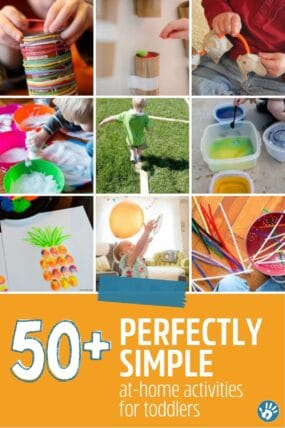
50+ Simple Activities for Toddlers
Get started having fun with your kids.
PLAN THE FUN WITH THE FREE KIDS ACTIVITIES PLANNER! AND RECEIVE ACTIVITIES EVERY WEEK!
- Preschoolers
- Kindergartners
- Grade School
- Literacy & ABCs
- Math & 123s
- Art Projects
- Gross Motor
- Shop Activity Plans
- Member Login

Educational Activities, Toys, and all things STEM
H2-Oh! Engaging Activities and Science Experiments with Water

*We’re an affiliate – we may earn a commission through qualifying purchases from the links on this page. As always, thanks!*
Water is a fascinating and versatile substance that is essential to life on Earth. It can take on many forms and can be found in oceans, lakes, rivers, and even in the air we breathe. Water is also a great medium for conducting STEM activities, as it is easy to work with and can be found in most households.
In this article, we will explore a variety of fun and educational water-based STEM activities that you can do with your kids. From exploring the properties of water density to conducting experiments on water pressure, these activities will help your kids learn about the world around them and develop their critical thinking skills.
Whether you are looking for indoor or outdoor activities, there is something here for everyone. So grab a bucket, fill it with water, and get ready to have some fun!
Here are a few fun and educational experiments and STEM activities involving water that kids may enjoy:
Jump to your favorite science experiment: Water Displacement Light Refraction in Water Frozen Science Melting Ice Sink or Float Experiment for Kids Water Density Experiment Water Glass Xylophone Water Pressure Experiment Water Absorption Water Cycle in a Bag Color Mixing with Water DIY Lava Lamp DIY Water Filter
Water Displacement
Ever drop ice cubes in a glass and had some of the water spill out? Or wonder why the water level in the tub goes up when you get in? That’s water displacement at work. We’re going to do a simple water experiment to demonstrate how this works.

To do the water displacement experiment, you will need the following materials:
- A small object, like a rock or plastic toy – something that’s okay to get wet
- A measuring cup or a ruler
- Towels to sop up any water spilled
Here are the steps to do the water displacement experiment:
- Fill the bowl to the top with water.
- Add a small object, such as a stone or a block, to the bowl.
- Ask your kids to predict how much water will spill over the sides of the bowl when you add the object. Encourage them to think about the properties of the object and how it might affect the amount of water that overflows and spills out.
- When you take the object back out, notice how much water is missing. If you like, you can get a bit more precise by measuring the water before and after it spills out. You can use a ruler or tape measure to measure from the top of the bowl to the water level.
- Encourage your kids to think about why the water behaved the way it did. What properties of the object and the water might have affected the amount of water that spilled?
- Repeat the process with objects of different sizes and shapes to see how they affect the amount of water that spills.
- Encourage your kids to come up with their own hypotheses about what factors will affect the amount of water that spills and test their predictions through trial and error.
Water displacement is when an object is placed in water and pushes the water out of the way as it sinks (or floats.) The amount of water that is displaced, or pushed aside, is equal to the volume of the object. Ultimately, the water level rises relative to the mass of the object.
Water displacement helps us understand how much space different objects take up. It can also help us understand why some objects float and some objects sink. If an object has a volume that is smaller than the amount of water it displaces, it will float. If an object has a volume that is larger than the amount of water it displaces, it will sink.
Light Refraction in Water

Light refraction is an interesting scientific phenomenon and can help us understand how light travels through different materials. It can also help us see things in a different way, like when we look at an object through a jar of water and it appears to be in a different place than it really is. Cool, right?
To do an experiment with light refraction in water, you will need the following materials:
- A clear glass or plastic container
- A pencil or drinking straw
Seeing light refraction in water experiment is one of the easiest experiments you can do. You’re just sticking a pencil in a glass of water and seeing what happens:
- Fill your glass or container with water.
- Put the pencil in the glass of water making sure some is submerged and some is above the water line.
- Observe the pencil, especially at the water level.
- Move the pencil around. What do you see? Does the pencil look like it’s in 2 pieces, or is the submerged part distorted looking?
What you’re observing is refraction, meaning the light is bending as it passes through the water. This affects the what we see. The light travels in a straight line through the air. Water is a different material than air, and the light travels more slowly through water. When the light hits the glass, it will bend and change direction as it passes through the water.
The amount of bending or refraction that occurs depends on the angle at which the light hits the surface of the water and the difference in the properties of the air and the water. When the light hits the surface of the water at a shallow angle, it will bend more than it will if it hits the surface at a steep angle. Similarly, the greater the difference in the properties of the air and the water, the more the light will bend as it passes through the water.
Encourage discussion about why the pencil appears that way when underwater. What properties of the water and the light might have affected its movement? Encourage your kids to come up with their own hypotheses about what factors will affect the movement of the light and test their predictions through trial and error. Use the scientific method to predict what may happen in different conditions.
Frozen Science
Fill a small container with water and add a few small toys or objects. Place the container in the freezer and have kids predict what will happen when the water freezes. Once frozen, observe and describe the changes that occurred.
We did this with plastic dinosaurs and made some frozen dinosaur eggs – check out our full post on dinosaur activities for more!

Water freezes at a temperature of 32 degrees Fahrenheit (0 degrees Celsius) and becomes ice.
Water freezes because the molecules, or tiny particles, in water slow down when it gets cold. When the molecules in water slow down, they don’t move around as much, and they start to stick together. When the molecules stick together, they form a solid, which is called ice.
Water changes states of matter from a liquid to a solid based on its temperature. What’s interesting is that the ice is lighter than water, which means that it floats on top of the water. This is why ice cubes float in a glass of water and why the ice on the top of a lake or pond doesn’t sink to the bottom.
Water is a very special substance because it can change from a liquid to a solid (ice) and back again, which leads us to our next simple science experiment:
Melting Ice
What makes ice melt? If you’ve frozen some object in ice, it’s time to thaw them out. Have kids predict how long it will take for the ice to melt in different conditions (such as room temperature versus outside in the sun or under a hair dryer.) Then, have them measure and record the melting times for condition.

We left one in the freezer for a control (spoiler: it didn’t melt.) We left one in a bowl on the counter, we put one in our utility room with our furnace, and we put one under a hair dryer (yes, the hot air made it melt much quicker.)
Related Post: For more on the water cycle, check out our post on experiments with states of matter and see how water moves from a liquid to a gas or solid.
Sink or Float Experiment for Kids
Fill a bowl or large container with water and provide a variety of objects, such as balls, rocks, and blocks. Predict which objects will sink and which will float, then test their predictions by placing the objects in the water.

We did this with various pieces of fruit in our post on experiments with apples . You can do this in combination with the water displacement experiment, and measure how dropping the objects in the water affects the water level.
Related Post: Learn about surface tension in our floating paper clip experiment.
Water Density Experiment
Fill a clear container with water and carefully add different objects (such as coins, paperclips, and feathers) to see which objects sink and which ones float. Observe what happens when you add a spoonful of salt to each cup.
To do the water density experiment, you will need the following materials:
- A clear container, such as a bowl or a jar
- A variety of small objects, such as coins, paperclips, and feathers
- Measuring spoons (optional)
Here are the steps to do the water density experiment:
- Fill the clear container with water.
- Carefully add different objects to the water, such as pennies, paperclips, and feathers.
- Have your kids predict which objects will sink and which ones will float. Encourage them to think about the properties of the different objects and how they might affect their movement in water.
- Observe what happens to each object as you add it to the water. Which ones sink and which ones float?
- Add a spoonful of salt to the water and observe what happens. Does the salt dissolve in the water or does it sink to the bottom?
- Have your kids observe what happens when you add the salt to each object. Does the salt affect the movement of the objects in any way?
- Encourage your kids to think about why the objects behaved the way they did. What properties of the objects and the water might have affected their movement?
- You can also try adding other substances to the water, such as sugar or baking soda, to see how they affect the movement of the objects.
- Encourage your kids to come up with their own hypotheses about what factors will affect the movement of the objects and test their predictions through trial and error.
Water Glass Xylophone

To create a xylophone using drinking glasses filled with water, you will need a set of glasses of different sizes and a mallet or spoon to strike them with. First, fill the glasses with different amounts of water.
The amount of water you add will determine the pitch of the note produced when the glass is struck. For example, a glass filled with more water will produce a lower pitch than a glass filled with less water.
Once you have filled the glasses with the desired amount of water, you can play them by striking the rim of the glass with the mallet or spoon. Experiment with different combinations of glasses and water levels to create a wide range of pitches and sounds.
Form more on this (and some other cool experiments) check out our post on science experiments with sound.
Water Pressure Experiment
Fill a small plastic bottle with water and have kids predict what will happen when they squeeze the bottle. Then, have them carefully squeeze the bottle and observe the results.
To do the water pressure experiment, you will need the following materials:
- A small plastic bottle
Here are the steps to do the water pressure experiment:
- Fill the plastic bottle with water.
- Have your kids predict what will happen when they squeeze the bottle. Encourage them to think about the properties of water and how it might behave when it is subjected to different types of pressure.
- Have them carefully squeeze the bottle and observe the results. What happens to the water as they squeeze the bottle? Does it flow out in a steady stream or does it spray out in all directions?
- For more pressure, place the bottle on the ground and have your kids stand on it. Observe what happens to the bottle as they apply more weight. Does the bottle collapse or does it remain intact?
- Encourage your kids to think about why the bottle behaved the way it did. What properties of the water and the bottle might have affected the results?
- You can also try using bottles of different sizes and shapes to see how they affect the results of the experiment.
- Encourage your kids to come up with their own hypotheses about what factors will affect the stability of the bottle and test their predictions through trial and error.
Water Absorption
We’ve all found ourselves spilling something and scrambling for something to wipe it up with. What materials are best to sop up a mess? Here’s a fun science experiment to help out.

We’ll use some paper towel, a dish cloth, and a sponge to see how much water each material absorbs over a set period of time. Encourage your kids to come up with their own hypotheses about what factors will affect the water absorption of different materials, and which ones will absorb the fastest and the most water.
To do the water absorption experiment, you will need the following materials:
- Paper towels, Cloth Towels, and a sponge
- Measuring Cup
- Bowls or trays
- A timer or clock
- Pen and Paper to record your findings
Here are the steps to do the water absorption experiment:
- Pour a cup of water into each of your bowls
- Place your paper towel in one bowl, a dishcloth in another bowl, and a sponge in the last bowl.
- Determine your time (3-5 minutes should be plenty) and start your timer
- Once your time has elapsed, observe and record how much water each material absorbed.
- You can remove the saturated items one at a time, and dump the water from each back into the measuring cup to record how much water remained in the bowl.
What did you find? For us, the time didn’t matter too much; everything was super saturated after a minute or so. The dishrag picked up the most (to be fair, it was the largest), followed by the sponge, and lastly the paper towel.
Encourage some discussion about why the different materials absorbed different amounts of water. What properties of the materials might have affected their ability to absorb water? You can also try using different materials, such as cotton balls or felt to see how they compare to paper towels or sponges.
Now, what will you grab the next time you need to clean up a spill?
Self Contained Water Cycle in a Bag
For a quick and easy experiment, fill a small zip lock plastic bag with water and seal it tightly. Place the bag in a sunny spot and observe what happens over the course of a few hours. The heat generated from the sunlight will evaporate some of the water and form water vapor inside the bag, then condense on the sides of the bag. The water is changing from a solid to a gas as it heats up, and back to a liquid as it cools. Check out our post on experiments with states of matter for a more visual take on this and build a cloud in a jar with us.
We did a bit more involved version of creating a small self contained ecosystem in a jar as well. Check it out in our post on activities and experiments with plants and build your own.
Color Mixing with Water
Kids can learn about color science with this simple experiment.
To do the color mixing with water experiment, you will need the following materials:
- 3 clear plastic cups
- Food coloring in different colors (such as red, yellow, and blue)
- A fourth cup for mixing the colors
Note: You may also want to have paper towels or a sponge on hand to clean up any spills.
- Fill three clear plastic cups with water and add a different food coloring to each cup. You can use any colors you like, but it is often best to start with the primary colors (red, yellow, and blue) as they can be mixed to create a wide range of colors.
- Have your kids predict what will happen when you mix the colors together. Will the colors blend together to create a new color, or will they stay separate? Encourage them to think about what they already know about color mixing and how different colors are created.
- Pour the colors into a fourth cup and observe the resulting color. What happened? Did the colors blend together to create a new color, or did they stay separate?
- Encourage your kids to think about why the colors behaved the way they did. Was their prediction correct? If not, why do they think the colors behaved differently?
- You can also try adding different amounts of each color to the fourth cup to see how it affects the resulting color. For example, what happens if you add more blue than red? Or if you add equal amounts of each color?
- You can also try adding more water to the fourth cup to see how it affects the intensity of the color.
- Encourage your kids to come up with their own hypotheses about what factors will affect the resulting color and test their predictions through trial and error.
DIY Lava Lamp
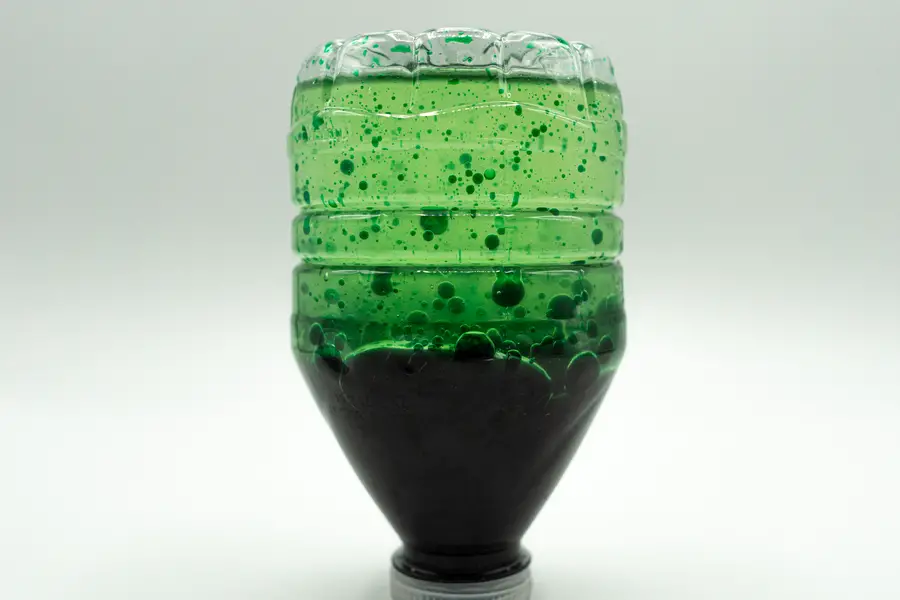
You can make your own lava lamp with some water, food coloring, and vegetable oil.
We made ours in an empty water bottle, and you can check it out in our post on fun projects using recycled water bottles.
DIY Water Filter
Cut a plastic bottle in half and fill the bottom half with layers of materials such as gravel, sand, and charcoal. Add a few drops of food coloring to a cup of water and pour it through the filter. Observe how the water changes color as it passes through the different layers.
To do the DIY water filter experiment, you will need the following materials:
- A plastic bottle
- A sharp knife or scissors
- Food coloring
Here are the steps to do the DIY water filter experiment:
- Cut the plastic bottle in half using a sharp knife or scissors. The bottom half of the bottle will be used as the filter, while the top half can be discarded.
- Fill the bottom half of the bottle with layers of materials such as gravel, sand, and charcoal. The order in which you add the layers is up to you, but you may want to start with the gravel at the bottom and finish with the charcoal at the top.
- Add a few drops of food coloring to a cup of water. The food coloring will represent impurities in the water that you want to filter out.
- Pour the colored water through the filter. Observe how the water changes color as it passes through the different layers.
- Encourage your kids to think about why the water changed color as it passed through the filter. What properties of the different layers might have affected the movement of the impurities in the water?
- You can also try using different materials as layers in the filter, such as cotton balls or coffee filters, to see how they affect the results of the experiment.
- Encourage your kids to come up with their own hypotheses about what factors will affect the movement of the impurities and test their predictions through trial and error.
The sand, charcoal, etc. are used to filter, or clean, the water as it passes through the bottle. When the water passes through the different layers of materials, it helps to remove impurities, or unwanted substances, from the water.
The gravel at the bottom of the filter helps to remove larger impurities, such as sticks or rocks. The sand helps to remove smaller impurities, such as dirt or sand particles. The charcoal helps to remove even smaller impurities, such as bacteria or viruses.
Wrap Up – Simple Water Science Experiments for Kids
We can learn about a variety of science concepts by doing a few STEM activities with water: Refraction, density, states of matter, sound and pitch, basic physics concepts and more. These activities are fun, and kids love to splash around. The key thing is to take a moment and observer what’s happening, and simply ask, “Why?”
By doing experiments like these, we can help kids learn about the world and the water we use every day. Which water science activity was your favorite?

About the author
hevanmiller
Latest Posts

Slime Recipes and Variations: Different Types of Slime
Spread the loveSlime is a popular science experiment and sensory activity, and it’s easy to see why—it’s stretchy, squishy, and endlessly fun to play with! But did you know that there’s a whole world of different types of slime, each with its own unique texture, feel, and even special effects? We’ve got a collection of…

Slime Science Fair Project Ideas & Experiments
Spread the loveIt’s hard to land on a fun project for science fairs. Slime is always a winning idea. From chemistry to physics, slime provides endless opportunities to explore how materials interact, change, and behave under different conditions. There’s plenty of ideas to make slime the perfect science topic for a hands-on, engaging science project…

The Science of Slime: What makes Slime work?
Unlock the gooey secrets of slime! Learn the science behind how simple ingredients create slime, and learn how to make your own.

32 Cool Science Experiments for Kids (that are Fun AND Easy!)

Do you ever want to do science experiments at home with your kids, but you’re not quite sure what to do? Not just any old kitchen science experiment will do – you want something cooler than vinegar + bicarb soda! But, you also want something simple and easy to do – because no-one wants a huge mess from their kids doing crazy science experiments at home!
We understand, and that’s why the writing team here at STEM Geek has put our heads together to come up with the most awesome at-home science experiments for kids! As science enthusiasts and educators, we also wanted to make sure that these are genuine science learning opportunities. So not only are they captivating for the kids, but we also emphasize what questions can be asked as kids explore and apply the scientific method! Plus, we’ve arranged them according to how much time they take: up to 1 hour, 1 to several hours, and long-term.
Related Post: Ultimate Boredom Buster: 101 Things To Do When Kids Are Bored
Science Experiments at Home that take Less than 1 Hour
1. tie-dye milk.
Sounds delicious, right? You’re not actually drinking it, but instead watching science magic happens when you combine dish soap with milk and food coloring. This is a very pretty experiment that draws the focus and mind into what’s happening on the plate, and all because of a little chemistry with everyday items. Well, food dye may not be an everyday item, but it might be after your kids get a hold of this!
So, what’s going on here, scientifically-speaking? Milk is made up of two major ingredients: water and fat. When you add a little dish soap, it bonds with the fat in the milk so strongly that it literally pushes the food coloring and water away from the cotton ball. On a microscopic level, the dish soap is wandering around the milk, which causes the colors to swirl and swirl.
Questions to ask beforehand:
- Before knowing what will happen to the food coloring, ask the kids what they think will happen when dish soap mixes with milk.
- Since the major catalyst is fat in the milk, what would happen if you used other types of milk: Skim milk, soy milk, coconut milk?
You’ll need:
- Round cake pan or plate with high edges
- Cotton ball (some tutorials show cotton swabs)
- Dish detergent
- Different colors of food dye (three or four should do)
Procedure/Instructions:
- Fill the pan halfway with milk.
- Drip one color of food dye in one section of the plate away from the center. Four to five drops works and later you can play around with more or less. Do the same for the rest of the colors around the plate.
- Soak the cotton ball in dish detergent, and when you’re ready for action, place the cotton ball into the center of the pan.
- Watch the colors racing around, creating a psychedelic tie-dye effect!
- You can add more cotton balls throughout the dish to see more action.
- If some food coloring hugs the wall of the plate, take a cotton swab dipped in dish detergent and place it into the food coloring. It will move away!
2. Saturn’s Glowing Rings

I don’t know about you, but I love everything about space. This experiment shows you how Saturn’s rings are made of rocks and ice chunks even though they look so smooth in pictures. You’ll also see why there are big gaps in the rings. Younger kids take delight in using a flashlight and sprinkling powder, while older kids can get more specific with questions about Saturn and how the rocks and ice stay in orbit.
- Do Saturn’s rings give off their own light?
- Why are some rocks and ice chunks more lit up than others?
- Compare the results of light sprinkles to thicker sprinkles.
- Strong flashlight
- Powder (flour, baby powder, etc) in a shaker
- Very dark room
- Darken a room and set the flashlight on the edge of a table or counter, pointing it at a blank wall. Lay the newspaper on the floor between the flashlight and the wall.
- Turn on the flashlight and notice where the light comes from the flashlight and where it hits the wall. You should only see the light from these two places and not from the space between them. This shows you that the light travels through the air without being seen until it hits the wall. The light represents the sun’s light.
- Now to see how Saturn’s rings glow: Hold the powder shaker and sprinkle some powder over the beam of light where you know the light is traveling. You’ll notice the powder lights up and sparkles in the beam of light. The powder shows in glowing clumps, just like in Saturn’s rings.
3. Breaking Down Colors
We all know that the fun, vibrant colors we see in our lives are created by mixing the basic red, yellow, and blue. In this experiment, you and your child will learn which colors make up those fun shades they have in their art supplies. This also teaches some basic chemistry and uses materials you already have at home. It can be done very simply and expanded to create a large-scale investigation if you love it.
- Which colors separate out first?
- Is the same order for each test?
- Which colors make up the original shade?
- Do the different types of color (pen, pencil, paint) separate in the same way or differently?
- Are some separated in a shorter space are the colors the same mixture?
- Coffee filters
- Color sources (markers, colored pencils, paint, etc.)
- A plain pencil
- To complete this experiment, cut the coffee filters into strips, mark one end with a line the same distance from the bottom on each strip.
- Color in each strip (between the bottom and line) with your colors, and write at the top what the color and source are (e.g., purple marker).
- Place each strip in a glass and help it to stand up by folding the top over a pencil (a chopstick, table knife, or any long narrow object will also work) so that it stands up in the glass.
- Fill the glass up to the top of your colored block, and wait. The water will move up the filter, and the colors will separate out as it goes.
- Remove the strip once the water gets near the top of the strip to stop the experiment.
To make this a true experiment, we recommend testing multiple colors and using markers, colored pencils, and paint (as some starting examples). You could test the same colors from each type of art supply to investigate whether they all use the same mix of basic colors to create the same end product.
This post has a nice full description of the methods if you need more detail.
4. Water Xylophone

This simple experiment will teach your child about sound and pitch using glasses, water, and something to act as a mallet. Don’t let the simplicity deceive you, there are a lot of ways to experiment and learn through this process, and it also brings in an element of music that makes it interesting and engaging.
- Do you think more water makes the sound higher or lower in pitch?
- How do you think the shape or size of the glass will affect the sound?
- How should we arrange the glasses to play a simple song?
- Do you think this will work with a plastic cup, why or why not?
- Some glasses
- Something wood to act as a mallet (we recommend wood so you don’t break the glasses!)
- A great way to start is with glasses that are the same size, shape, and material, and filling them with different amounts of water.
- Have your child use the mallet to test how the amount of water affects the sound.
- From there, it’s a really simple extension to use different sized and shaped glasses (or any glass vessel like jars and bowls) to experiment with how the shape, size, and amount of water in the glass affect the tone.
To take this one further and really bring in the musical component, you and your child could work out a simple song and create the right tones to play it. If you or your child are musical, you could get very elaborate and creative (try googling harry potter or star wars theme songs on glasses, there are so many options that I couldn’t even choose one)!
5. Ultimate Bottle Flipping
Ah, bottle flipping. The fad that kids can’t get enough of, but parents are well and truly over. The constant thud of semi-filled water bottles being tossed (and hopefully landing upright) is guaranteed to send parents around the twist!
If you can stand it for a bit longer though, there’s a lot of STEM knowledge to be gained in this bottle flipping experiment. As we know, the aim of bottle flipping is to flip a partially filled water bottle underhand and get it to land upright.
In this experiment, kids will learn the importance of observing a result multiple times before changing a variable (the amount of water in the bottle).
- How much water should you put in the bottle?
- What is the ideal amount of liquid to get the perfect flip?
- What should be the ideal amount of water?
- Was their prediction correct?
- Why do they think the amount of water affects the chances of landing the bottle?
- A plastic water bottle
- Measuring jug
- Paper to record results
- Get the kids to start by flipping their bottle with no water in it at all. Kidspot recommends flipping it 50 times for each step, but you could do less if you need to.
- Try it again with 50ml of water.
- Keep adding more water until the bottle is full.
If they’re keen, you could try other types or sizes of bottles, or even try different liquids to see if that affects the results!
6. Rainbow in a Jar

This simple science experiment is not only very visually appealing, but it’s also a great way to learn about the density of liquids. Warning though, this one could get messy so make sure kids are in some old clothes and you might want to take it outside! I like this experiment because you’ll probably have most of the materials in your kitchen already!
- Which liquids they think will be heaviest?
- Which ones will be lightest?
- Why do they think that?
- A glass jar
- Food coloring
- Various liquids like honey, corn syrup, dishwashing liquid, olive oil, rubbing alcohol and water.
- Use the food coloring to make all your liquids a different color. A dropper comes in handy here, but if you don’t have one you can manage without.
- Slowly add each liquid to the jar (pouring into the middle of the jar is best).
- Soon, you’ll have different layers of colored liquid forming your very own rainbow in a jar.
You might even get them to draw a diagram of what they think the jar will look like at the end. They can compare this with the experiment results to see if their prediction was correct.
It might also help to talk to your kids first about what density is and how materials are all made of different amounts of molecules. The more molecules a liquid has, the heavier it will be. Playdough to Plato demonstrates a great way of introducing this concept using marbles.
7. Write Your Own Secret Messages!
We love science experiments that are made up primarily of supplies that you likely already have in your home.
- Why do you think this will work?
- Which liquid do you think will make the best secret message?
- Why do people write secret messages?
- Juice (eg. Lemon)
- Lamp (or anything else that can be used as a heat source)
- In order to complete this experiment, you’ll need to gather all of your supplies along with a piece of paper, some q-tips, and a lamp or other item that you can use as a heat source.
- Next, you’ll mix your lemon juice with a slight amount of water.
- Using your q-tip, use the mixture you’ve created to begin writing your message.
- Allow it to dry.
- Once dry, apply heat to it in order to get your message to appear.
Extend this project by attempting to write with a juice and water mixture, a milk and water mixture, or any other variation of the liquids we listed as necessary supplies!
8. Create Your Own Butterfly

Your little ones will love practicing their color mixing by creating their very own coffee filter butterflies. Hang them in the windows of your home to spread some cheer and to watch the sun flow through their beautiful wings!
- What colors can mix together to make other colors?
- How do butterflies fly?
- What do you think will happen when we add water to the markers?
- Water spray bottle
- Allow your child to draw on the coffee filter to their heart’s content.
- Spray it with water and allow the colors to mix together.
- Allow it to dry thoroughly.
- Once dry, fold it like a fan and then clip it in the middle.
Ta-da, you’ve created a beautiful butterfly!
9. Make A Duck Call
Give your family an excuse to head outdoors by allowing your children to craft their own duck calls. Test them out at a local pond and see if you can get the ducks to come closer to you for a healthy veggie snack!
- Do you think ducks will be able to hear us with this?
- What other materials do you think could make this noise?
- How is what we have created similar to a duck’s beak?
- Plastic straw
- Push down on the straw to flatten one end and then cut the flattened end into a point.
- Flatten out your straw and then blow into it.
- Feel free to experiment with different amounts of flattening and different point shapes to see how you can adjust the sound.
- When finished, take your duck call into the wild to test it out.
10. Make Ivory Soap Boats

Did you ever carve items out of soap at camp when you were a child? Give your child the same opportunity. Soap can be carved using safe items, like plastic knives.
- Why are we able to carve soap so easily?
- Do you think our boats float?
- Why do you think they float or sink?
- Carving tools (for kids)
- Allow your child to express their creative side by carving their boat out of soap.
- Once they have finished carving it, allow them to test them out in the bathtub. . Extend their learning by discussing density with them–the soap floats because it is less dense than the water.
11. Make Your Own Quicksand
As John Mullaney famously said, “I thought quicksand would be a much bigger problem in my adult life than it would have turned out.” For some reason, quicksand permeates children’s adventure stories – and their imaginations!
- Where can we find quicksand in real life?
- How do you think quicksand works?
- What do you think we will need to make our own quicksand?
- Cornflower (one cup)
- Water (half cup)
- A container
- To make your quicksand, you’ll need to mix the cornflour and water.
- Be sure to stir slowly in order to demonstrate – if you stir too quickly, it will become hard and you won’t be able to see it function the way it should!
12. Make Your Own Lava Lamp

We’ve tried this one in our classrooms, and trust us, our kids go wild year after year. Kids love making something that they can use as home decoration, and they love how easy it is to show new people – this is the experiment that lives on and on!
- How do you think density is involved in this experiment?
- Why don’t the water and oil mix?
- Why can’t we shake our lava lamps?
- Clear Plastic Bottle
- Vegetable Oil
- Food Coloring
- Alka-Seltzer
- Pour water into the plastic bottle until it is approximately one quarter full.
- Then pour vegetable oil in until the bottle is almost completely filled.
- Allow some time for the oil and water to separate.
- It is important that your children do not shake the bottle in this step. It will extend the experiment for no other reason than you waiting for the bubbles to dissipate.
- Add as much food coloring as your child deems fit and then drop a piece of Alka-seltzer tablet into the bottle for the lava lamp fun to begin.
13. Guess the Smell
This one will take a little more prep work, but it’s a great touchstone for your children to begin discussing one of their five senses: the sense of smell!
- What are examples of times we use our sense of smell?
- What other senses do we have?
- If you could only use one sense for the rest of your life, which one?
- Plastic Cups
- Smells (eg. coffee, cinnamon, vanilla, lemon juice)
- Place a variety of common smells in small plastic cups. We like to use coffee, cinnamon, vanilla, and lemon juice.
- Pour these in and place tin foil securely over the top of the cup.
- Poke small holes in the top of the foil.
- Secure the foil with tape (on the sides, not over the holes).
- Allow your children to guess the smells and record their findings on paper.
Home Science Experiments that take 1 to Several Hours
14. mangrove bioshield .
Ecologists and conservationists are pushing for more regulations in building and saving mangrove forests around coastal areas. The reason is represented in this STEM activity. The trees act as a mangrove BioShield (bio = life, shield = protection), showing how natural obstacles can prevent critical damage from marine natural disasters such as tsunamis.
The mangrove BioShield can be for older elementary kids through to high school. Obviously, the younger they are, the more parent involvement. This experiment is done twice to show the effects of having and not having a BioShield. The first part uses little to no trees, and the second uses a forest of trees and rocks.
- What will happen in a tsunami if the village is without a BioShield? And the village with a BioShield?
- Would a BioShield help with hurricanes?
- Would you want to encourage people to save manatee forests if they are beneficial?
- Medium to large clear, plastic container
- Newspaper – wad into balls, then cover half of the bottom container – this help to keep the ground sturdy
- Mud – cover the newspaper and press it in to form a slope down to the empty side of the container. The top side should be flattened for the cardboard houses, then it slopes down into the empty half of the container.
- Cardboard houses (use the bottoms of milk cartons for the house and popsicle sticks for the roofs, place houses on the mud towards the top of the high slope
- Model trees or leafy stems from plants – Different amounts for activity 1 and activity 2
- Several small rocks
- Cardboard – long enough to fit across the container and tall enough to hold it from out of the water
- Water – enough to go halfway up the slope
A tsunami without the mangrove forest – insert only one or two trees down the slope. Place the cardboard piece into the water end of the container and move back and forth to create waves. Notice how easy it is for the water to destroy the village you’ve created.
Part 2:
Repeat the process of constructing the village, but this time insert a lot of trees down the slope to where the water meets the mud. They need to be deeply rooted like mangroves, and I’ve found that aquarium plants work well for this reason. Place the rocks within the mangrove forest and in front of the trees. Add a little bit more water. Insert the cardboard again and move it back and forth to create waves.
15. A Greater Crater
When you look at the night sky and see the moon, one of the first things you notice is its craters. The moon is completely covered in them, and some are so large we can see them from Earth. Meteorites often make the craters that we see when they hit the surface, but it makes us wonder why some craters are so much bigger than others.
This experiment will help you to investigate one of the main reasons why craters come in different sizes.
- What causes craters?
- How big do the meteorites have to be to make a crater?
- What is it about the meteorite that causes the size of the crater?
- Paper to record your results
- Flat floor surface for the experiment, large enough for the newspaper to cover
- Shallow metal pan at least 2 inches deep
- Flour to fill 2 inches of the pan
- ¼ cup hot chocolate powder
- Mesh strainer or flour sifter
- Large marble (and others of varying sizes if comparing results)
- Metric ruler
- Tongs or long tweezers
- Pour the flour into the pan until it reaches 2 inches. Place the pan on top of the newspaper on a level surface.
- Sift a layer of hot chocolate powder over the flour (this is so you can better see the rays and other features of the craters).
- You will be dropping your marble from three different heights, then comparing the sizes of the craters. Measure the diameter (side to side) of the marble and record this on your paper as Marble 1. Hypothesize how large the crater will be and write that next to the diameter of Marble 1.
- Stand next to your pan and hold the marble at knee height above the flour. Drop the marble (do not throw it, just let it fall from your fingers) into the flour and study the shape of the crater. Look for a rim around the crater or any rays coming from the edges.
- Measure across the widest part of your crater, from rim to rim and record on your data sheet as Marble 1 – Knee Height – Width or something similar. You can also draw a picture of your results.
- Very gently use the tongs or long tweezers to remove the marble without destroying the crater.
- Repeat this procedure from waist height, shoulder height, top of head height. Make sure you aim in different parts of the flour so you don’t land on top of another crater. Record all of your results as the different heights you’re using.
- Compare your results.
- You can try again with a different sized marble as “Marble 2” to compare those results with each height as done with Marble 1.
Perhaps now, you’ll look at the moon a little differently!
16. Rube Goldberg Chain Reaction Machine
We’ve all seen them, some pretty far-out there chain reaction machines to complete simple tasks, usually in movies. But they are real , and are becoming even more popular now that we’re all stuck at home for a while. This is a fun way to explore physics with stuff you have at home.
Ask your child to decide what the end goal is (e.g. get the ball into the cup), and ask them to think about creative ways to make it get there. Working together, you can start with small pieces of a circuit to find out how your ball reacts to the set-up, and grow it from there. You can even refer to this video for more ideas:
- What will happen when the ball bounces off of this wall?
- How will these dominoes change the speed of the ball?
- What can we use to make sure that the ball goes in the direction we want it to at this point?
- What should we put here to get the best bounce?
- Paper towel
- Toilet paper tubes
- Fixed objects like walls or furniture
- Any other toys and materials that can be used to build your circuit
To make this a true experiment, it needs to include more than a one-off demonstration, and there are a lot of ways to accomplish this.
- Set up parallel courses and use different sized or weighted balls to go through the circuit.
- Set up one elaborate circuit and use different objects one at a time.
- Set up circuits in different ways to see how different set-ups affect your end goal.
Another experimental component is the process used to create a circuit that reaches your end goal ( like this video about getting the ball into the cup, but you could come up with lots of other endpoints!). Along the way, you and your child get a lot of time to learn about momentum, velocity, friction, energy transfer, and interference (e.g., the cat).
17. Melting

This is a simple and fun experiment that can be set up in a short time and then fill-up your day with observations and new experiments. Using only things you already have at home, you can set-up an engaging experiment with your kids!
Ice melts at different rates depending on a variety of factors including temperature, pressure, and if there are impurities (think salt, sugar, dirt) in the ice or touching the ice. There is a lot of opportunities to get creative and do the experiment in multiple ways, keeping your kids engaged and developing their investigative, experimental, and critical thinking skills.
- Which ice melts the fastest, slowest, and if they have any guesses about why?
- What other ice-melting experiments they think would be fun: Using different temperature liquids? Using different amounts of ice? Different sized cups?
- Lots of ice
- Several matching cups (i.e., they are the same size, shape, and color)
- Measuring cups
- A variety of liquids for the test
- Paper for writing down observations
- Measure the same amount of ice and place it in each cup.
- M easure equal amounts of each liquid and place them in the cups: try to complete this part quickly so that the ice in each cup is in liquid for as close the same amount of time as possible.
- Set up your cups in a place that is easy for your child to watch and observe.
- Ask them to check in at regular intervals (every 15 minutes, every hour) and record or talk to you about their observations.
Other potential experimental examples:
- Using different liquids to test if they affect melting time;
- Using the same liquid and placing ice in different locations to test what conditions throughout your home affect melting;
- Test if different amounts of ice melt at different rates;
- Test if different kinds of cups change melting time.
There are endless possibilities for you to come up with new ways to complete these simple experiments. You get the idea. Explore more!
18. Breathing Leaves
Science experiments don’t get much more simple than this one! It’s effective though and kids will enjoy watching their leaf ‘breathe’. Learning about plant science is often tricky because it can seem a bit abstract. This experiment allows kids to see the process of plants making oxygen right before their eyes!
A question to ask beforehand:
- What do you think will happen if we leave it for a few hours?
- A fresh leaf from a tree
- A bowl of water
- Pluck a fresh leaf from a tree and place it in a bowl of water.
- Use a rock to weigh it down and leave the experiment out in the sun.
- Have your kids predict what they think they will see when they come back in a few hours (they can write their prediction down or draw a diagram if that’s more their style).
- After a few hours, your kids will see lots of tiny little bubbles on the edge of the leaf and in the glass bowl of water (use a magnifying glass to get a closer look if you have one).
So, what’s happening here? Leaves take in carbon dioxide and convert it to oxygen during photosynthesis. The bubbles you can see are the leaf releasing the oxygen it’s created. You could explain to your kids how trees and plants make the oxygen we need to breathe. Kids Fun Science explains this experiment in more detail and suggests taking it further by leaving the plant for a longer period of time (do you see more or fewer bubbles?) or placing a leaf in a dark area to see what difference that makes!
19. How Does Sunscreen Work?

If there’s one thing I know, it’s that kids hate wearing sunscreen! Trying to get it on them is like wrestling a crocodile. Maybe if they knew how sunscreen worked they’d understand how important it is to wear it when they’re out in the sun (and be slightly more cooperative when we’re lathering it over their little faces). This is a simple experiment that shows kids the difference wearing sunscreen will make to their skin.
- What do they observe when they come back?
- Why do they think one side faded and the other not?
- A piece of colored cardboard (a dark color would be best)
- Your usual bottle of sunscreen
- Have your kids smear the sunscreen over one part of the cardboard and leave the other part clear.
- Kids can then predict what they think will happen when they return to the experiment after a few hours.
- Talk to them about how the sun’s UV radiation is absorbed by the sunscreen so it can’t get through to damage the cardboard.
You could even take it further by trying different kinds of sunscreen or leaving your cardboard out during different times of the day.
20. Make A Rubber Egg
Imagine a world in which eggs can be used like bouncy balls. Well, with a couple of home supplies and a little bit of science, you can live in that world. Your child will be dazzled as they remove eggshells from eggs while leaving the insides intact.
- Is vinegar an acid or a base?
- Is there another substance that could do this?
- Simply leave the egg in the vinegar for a few hours and wait to see what happens. Because of the transformative nature of this experiment, it lends itself to science journaling.
- Consider having your kiddos draw before and after pictures of the eggs in order to track their journeys.
21. Flying Tea Bags

Nothing will get your kids’ attention faster than telling them that you are going to spend some time creating something that will fly. However, because this experiment will involve fire, please ensure that you select a time in which you will be able to provide ample adult supervision.
- How do we stay safe with fire?
- How do we make sure we don’t damage the surface we are working on?
- Why do you think the tea bag will fly?
- Single Serving Tea Bags
- A Small Bowl
- A Non-Flammable Work Surface
- First, open the tea bags and unfold them.
- Empty the leaves from the bag.
- Stand the tea bags up on your surface and light the top of each bag on fire.
As they begin to burn, they will float into the sky!
22. Make Wax Paper Lanterns
Your children will love the chance to display their fantastic art skills by creating these paper lanterns. If you want to add a culture lesson, have your children research German’s St. Martin’s Day and learn about why children parade through the streets with lanterns. We promise there’s a good moral story involved here!
- When could we use lanterns?
- What safety considerations do we need to use in this project?
- Why can we see the light through the wax paper?
- Popsicle Sticks
- To begin, tear a ten-inch piece of wax paper off of the roll and cut it in half.
- After that, fold each piece in half.
- Allow your child to color their image on top of the wax paper. (This is a great place for an impromptu lesson in color mixing).
- Fold the wax paper and iron it (consider something in between the crayon mess and the iron you use on your clothes).
- Finally, glue the craft sticks into squares, add the wax paper, and turn it into a cube.
Voila, you’ve created your own lantern!
23. Create an Insect Habitat
Alright, this one isn’t for the faint of heart. Draw up your courage and send your child into the backyard to collect all of the creepy crawlies they’d like to.
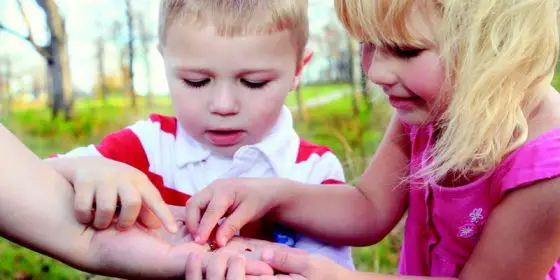
Now you have a home for them. Better yet, you can keep your child entertained for hours as they track the growth of their bug friends.
- What do bugs need to survive?
- What do bugs eat?
- What is the difference between a need and a want?
- Imagination
- Find something that you’re willing to sacrifice to the bugs in order to create a habitat for them – we recommend a shadowbox so that your child can see inside, but a cardboard box will do just fine as well.
- Ensure that there is breathing room for the bugs.
- Create a habitat with sticks, bark, small rocks, dried leaves, and whatever else you can find.
- If you’re willing to hang onto the habitat long enough, use it as an opportunity to talk about decomposition as the bugs begin to break down the twigs.
Long-Term Science Experiments at Home
24. crystal kingdom.
This is the oldest trick in the book, but it’s popular because it’s so effective, fun, and has great results. The only drawback to most crystal-growing recipes is that they take ages to grow, and to be quite honest this one is no exception. In fact, these crystals will take several days to grow but the end result is worth it. The reason is that this experiment involves growing a whole landscape of beautifully colored salt and bluing crystals. Here’s a video for visual reference:
A few things to keep in mind: Allow for plenty of air circulation, preferably inside rather than outside. Ammonia is not necessary but does help in the process.
- What will happen when you add ammonia?
- Why does more salt and less liquid create faster crystallization?
- What part does the bluing solution have in crystal growing?
(Answers can be found here )
- Two bottles of bluing solution
- Large tray/cookie sheets with sides
- Measuring cup
- Liquid watercolors
- Eye droppers
- Cut sponges into large pieces. Spread them out on the tray.
- Measure out 1 cup of each of salt, water, and bluing and then gently mix together.
- Evenly coat or sprinkle the mix over the sponges.
- Add 1 cup of ammonia to the sponges.
- Coat an extra 1 cup of salt on to the sponges.
- By now you’ll see some crystals growing . Sprinkle the magic mix again: 1 cup each of salt, water, and bluing. You can pour the ingredients onto the tray instead of on top of the crystals to keep them from breaking. Don’t worry, more will grow!
- Take an eyedropper, and drop a tablespoon of each liquid watercolor (undiluted) in different patterns over the sponges and crystals.
- Take note of your garden and what the crystal formations look like. You can make a sketch in your notebook as a before and after. Ask questions and observe!
- Observe how the crystals are bigger than before, and notice the colors aren’t as vibrant. Compare the differences in shapes, sizes, and colors.
- If you want more crystals to grow, add a little more water, bluing, and salt.
25. Blow up a Balloon with Yeast
We are surrounded by science in action, but sometimes it is really difficult to see what is happening, especially when it is on a small-scale. When we make bread, yeast ‘eats’ the sugars in the food and creates CO2, giving bread its airy texture. This experiment lets you both visualize what happens when yeast consumes sugar and is a great set-up for an experiment that can be observed throughout the day.
Depending on your supplies and time, you could start with a demonstration and use that to think of other tests, or you could set up several parallel tests at the same time.
- How quickly does the balloon filled with air?
- When does it stop filling (at some point the yeast will run out of food and will stop making gas)?
- Does the starting temperature affect the experiment?
- Does the balloon fill faster in different places in your home (try especially for different air-temperatures, you could include an outside location)?
- Some balloons
- Blow up the balloon a few times before starting so that it’s loosened up a bit.
- Fill the bottle with about 1 inch of warm water (heat is required to activate the yeast, but you could experiment with different temperatures), add the yeast and swirl to dissolve.
- Add the sugar and swirl more.
- Place the balloon over the opening to the bottle and wait. You should expect to see the balloon begin to inflate after around 20 minutes.
- Continue checking and observing how much the balloon inflates throughout the day.
More example experimental setups include:
- Do different temperatures – either with the water you start with or the air the yeast lives in – affect how quickly the balloon blows-up?
- Does using 2x the yeast result in a balloon that is 2x bigger, or blows-up 2x faster?
- Do different types of sugar (e.g., white sugar, honey, syrup, flour) affect how quickly the balloon blows up or how big it gets?
A sk your child to think of new experiments (you could prompt with some of the examples above, or ideas from this post ).
26. Seed Germination
A really simple but fun multi-day experiment is germinating seeds under different conditions. This means finding some quick-sprouting seeds such as beans and putting them in different conditions to see how that affects germination (sprouting leaves and roots) and growth.

I love using seed experiments because they are inexpensive, simple, and leave a ton of room for creating your own unique experiment.
- Which seed will sprout fastest?
- Seeds (Beans, radishes, squashes, and many flowers sprout quickly from large seeds, making them good choices.)
- Small pots or paper cups
- Potting soil
- Cloth or paper towel
- Somewhere with good light
- To get started, you’ll need some seeds – feel free to choose something you already have, if you’re a gardener you might have some seeds ready for the coming season and could spare a few – or find something online or at your local nursery.
- Use small pots or paper cups and fill each with your growth material (we recommend a minimum of 3 for a useful comparison).
- Fill one with potting soil, one with sand, and one with a cloth or paper towel.
- Place them somewhere with good light, and add water.
- Ask your child to predict which seed will sprout fastest, and make observations every day. If possible, make them around the same time each day.
- Once you see growth, you can ask your child what they think caused any differences, and you can use that as a jumping-off point for more experiments
Additionally, you could:
- Use one type of seed and different types of growth media: soil, paper towel, gravel, sand, water, etc.
- You could use different seeds (beans, flowers, grass, herbs) and grow them under the same conditions (soil, water, sun exposure) to see how different plants grow differently.
- You could see how different light conditions (by a window, in the basement, in a bright room away from a window, etc.) affect germination.
You could also extend each experiment by simply continuing to grow each seed to learn whether the different germination time affects long-term growth (you may want to re-pot everything in the soil for this to be effective, depending on the specifics of your initial experiment).
27. Colored Celery
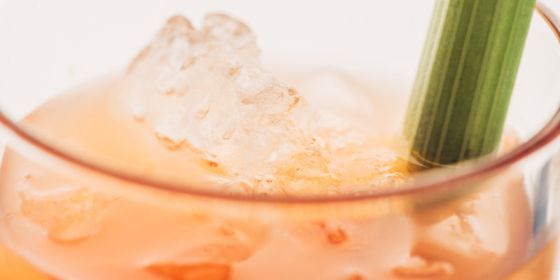
It’s hard to imagine plants having little capillaries inside them that transport water and nutrients, but this experiment shows that in action. It’s easy to set up, but you’ll have to wait at least a day to see some results. Your kids will be able to see how transpiration takes place and plants absorb water from the soil all the way up into their leaves.
- A few stalks of celery (celery works best for this because it’s a bit more visible, but you could also use flower stems)
- Different food coloring
- Place each stalk in a cup of colored water and make your predictions about what will happen.
- After a day or so you’ll see the celery leaves becoming the color of the water they’re standing in.
- Have your kids describe their observations (they can write down what they see or draw it if they prefer).
- If you look at the base of the stem you’ll also see tiny little holes that the colored water is traveling through.
When you’re done with the experiment, make sure you snap the celery and look inside – you should be able to see the capillaries in action. For more ideas, Little Bins for Little Hands has got some great hints and tips for this experiment.
28. Moldy Bread
This experiment is an oldie, but a goodie! Kids love looking at disgusting things and this one will certainly come up with the goods. Not only will kids learn about how mold grows, but they might also take on some lessons about the importance of washing their hands!
You might want to check out the results of this experiment at Science Alert before you start to see if your stomach is up to it.
- A few slices of bread
- Some ziplock bags
- Sticky little hands.
- Get a few slices of bread and lay them out on your kitchen bench.
- Have your kids touch one piece of bread with dirty, unwashed hands.
- They can wash their hands with soap and water and touch another slice, then do the same using hand sanitizer.
- Leave one piece of bread untouched.
- Place them all in clear, labeled ziplock bags and predict which one will grow the most mold.
- Leave your bread slices for at least a week (it may take a bit longer, depending on the conditions where you live) and get the kids to record their observations.
You can also try wiping your bread slices on other surfaces to see what moldy results you get (their laptop or tablet is a great place to start)!
29. Sprouting Beans

Give your household a real survivalist feel by beginning an indoor garden. We recommend planting your beans in a clear cup so that your children can be privy to all of the processes during the plant’s journey.
- How does a plant grow?
- What does germination mean?
- What is in season to grow in our area now?
- Unprocessed Beans
- If you’d like your child to see every step of the process, consider placing the beans inside of a damp paper towel inside of a ziplock.
- You can wait, see the germinated seed together, and then plant it inside of a small cup.
- Once inside the cup, watch it grow.
Extend your work by planting various beans and altering the growth conditions in order see what makes your beans grow best!
30. Begin Composting
Begin your “go green” resolutions by teaching your child the value of composting! Best of all, once the science experiment is done, your family will have a recycling process that will last your entire lifetimes.
- Why is composting important?
- How else can our household go green?
- Why do we need a foundation layer for compost?
- Compost Bin
- Organic Material
- First, create a compost bin. You can purchase one or build one out of wood.
- To begin your composting, you’ll need even amounts of brown materials (think shredded paper, dryer lint, etc.) and green materials (think fruit and vegetable waste, lawn clippings, etc.).
- If you’re really feeling fancy, throw some earthworms in there.
For days to come, your family will be able to discuss what can and cannot be broken down by the decomposers inside of the compost bin. Never-ending science!
31. Turn Grapes Into Raisins

Your kids may or may not eat raising – but we can guarantee you, they’ve likely never considered the option of creating their own!
- What other snacks can we make with science?
- Should we ever eat our experiments?
- How does this work?
- For this experiment, you’ll need grapes. (Really, that’s it!)
Leave your grapes somewhere where they will not be disturbed and use this as an opportunity for your children to journal the changes in the grapes from day to day. Believe it or not, this type of sequential journaling is a valuable literacy skill!
32. DIY Science Experiment
The best science experiment your child can engage in is the one they create themselves! Begin brainstorming a list of questions and let the world be their oyster as they plan and carry out their own experiments. Some of our favorite brainstorming questions, from Scholastic’s Science-Fair Project Guide, are listed below:
- What is the effect of toothpaste brand on teeth-cleaning power?
- What brand of trash bag can withstand the most weight before ripping?
- How does the type of material affect how long a shirt takes to dry?
Written by Miranda Altice, Kaitlin Anselmo, Mark Coster, Allison Ebbets, and Jodie Magrath.

Mark is the driving force behind STEM Geek. With 20 years of experience in chemistry education and research, and 3 willing children as guinea pigs, Mark has a passion for inspiring kids and adults to combine fun and learning with STEM Toys!
Editor’s Picks

7 Best LEGO Star Wars Sets | Our Top Picks of All Time!

Best LEGO Creator Sets – Take Your Pick From These 7 Gems!

How to Use a Metal Detector: 8 Essential Tips to Get the Most of It

Best Metal Detector for Kids: 5 Top Picks (+ Buying Guide)

Best 2+ Player Cooperative Board Games (Top 6 in 2024)

MEL Chemistry Review: Is Your Child the Next Bill Nye?
Playing With Rain
Explore the World Around You
Fun Water Experiments
Share with your friends!
There are so many super fun and easy science experiments that can be done with just water and a few household supplies! Your kids will love these Fun Water Experiments and will ask to do them over and over again!
My favorite thing about these water experiments is that they are a great way to entertain your kids while also teaching them something new!
PIN THESE EXPERIMENTS FOR LATER

Table of Contents
- Floating Orange Experiment – A great way to explore how the density of objects determines what floats or sinks.
- How to Freeze Water Fast – You won’t believe it when you watch a glass of water instantly freeze when an ice cube is placed in the water!
- Leak-Proof Bag Experiment – How does a plastic bag poked with sharp skewers not leak water everywhere!?

- Magic Blooming Flowers – These paper flowers that bloom in water will keep your kids entertained and teach them some cool science too!
- Rain in a Bottle Experiment – If you have always wanted to make it rain, then you have come to the right place!
- Hot and Cold Balloon Experiment – Inflate and deflate a balloon by simply heating up or cooling down the air inside the balloon!

- Air Pressure Bottle Experiment – Use a balloon filled with air pressure to power a homemade drink dispenser!
- Water Bottle With Holes Experiment – Holes are poked into a bottle full of water and the water doesn’t leak out!
- Water Pressure With Water Bottle Experiment – Explain the force that water pressure has on deep-sea divers and scuba divers!

- Balloon and Candle Experiment – This balloon experiment uses a cool trick with water to make it flame-resistant!
- Balloon and Glass Experiment – Squeeze an inflated water balloon into a glass jar with the help of some fire and water!
- Gobstopper Experiment – Create a dramatic display as Gobstopper candies are broken down by water in a very colorful way!

- How to Make Instant Snow – So easy and only takes 2 household ingredients to create endless snowy fun for the kids!
- How to Turn Water Into Ice Instantly – Pour supercooled water out of bottles to create ice pillars!
- Rising Water Experiment Step by Step – Learn about the properties of air pressure by watching water get pulled into an upside-down jar!

- Light Refraction in Water – You won’t believe your eyes when you see an image reverse directions when placed behind a glass of water!
- Upside Down Glass of Water Experiment – Watch the power of air pressure hold water inside an upside-down glass!
- Dancing Grapes Experiment – Carbon dioxide bubbles created from baking soda and vinegar make a dazzling show of dancing grapes!

- Dancing Pepper and Soap Experiment – This classic and very fun science experiment demonstrates the power of water surface tension.
- Candle Water Experiment – This cool science experiment for kids is a great way to demonstrate the high heat capacity of water!
- Dancing Raisins Experiment – Kids will love watching raisins magically bounce up and down in a glass of fizzy liquid.
- How to Make an Egg Float – We are going to change the density of water and make an egg float with this fun experiment for kids!

More Resources:
- Weather Experiments for Kids
- Static Electricity Experiments
- Balloon Science Experiments
MORE ABOUT PLAYING WITH RAIN
LET’S CONNECT
Search for more ideas, create at your own risk.
All content on this blog was created for inspiration and entertainment purposes. Creating anything with the suggested tools, products or methods, is under your own risk!

100+ Easy Science Experiments for Kids To Do at Home (Using Materials You Already Have!)

- Pinterest 1.3K

Looking for fun science experiments to do at home with your kids? We’ve compiled the ultimate list of cool science experiments for kids – most of which can be done with materials you already have on hand!
Children are naturally curious about the world around them, but explaining scientific concepts without a physical demonstration can be confusing, and well, just not fun! We’ve found the best way to teach science is with simple science experiments that provide hands-on learning opportunities – making concepts more accessible, and most importantly, extremely fun and memorable for kids.
We’ve scoured the web to pull together an epic list of the best easy science experiments you can do at home with your kids. Whether you have preschoolers starting at square one, or tweens or teens looking for the ultimate Science Fair project idea, this list has it all – ranging from weather, water and physics experiments, to chemical reactions and explosions (always a kid favorite!).
And you won’t have to make a special trip to the craft or hardware store – almost all of these fun science experiments use common household ingredients that you probably already have at home. Score!
So what are you waiting for – dive right in and have some science fun!
PIN for when you’re ready to perform a fun science experiment:

Science Experiments using Chemistry (Hello, Explosions!)
Your kids will have a blast watching how different materials react and change with these simple chemistry experiments – there’s tons of bubbly explosions, fizzy reactions and rainbow creations to choose from!

(1) These Oozing Pumpkins are sure to bring lots of laughs from your young scientists as you create overflowing reactions from baking soda and white vinegar. (via Little Bins for Little Hands)
(2) Or swap the pumpkin for a lemon to create a miniature volcano right in your kitchen with this Lemon Volcano . (via The Best Ideas for Kids)
(3) Go big or go home with this incredible Watermelon Volcano experiment where you just need a few simple materials including baking soda, dish soap, vinegar and a little bit of food coloring. (via Preschool Play & Learn)
(4) We love this colorful twist on the classic Baking Soda and Vinegar Reaction . It just never gets old! (via Crafts by Amanda)
(5) Grab a baking sheet and try this Fizzing Colors activity to make a bubbly piece of art! (via Mom Wife Busy Life)
(6) A fun Rainbow variation on the classic Baking Soda and Vinegar experiment that is sure to make kids smile. (via The Best Ideas for Kids)
(7) Make these amazing Magical Color Changing Unicorn Noodles with cabbage and then squeeze on some lemon to watch the noodles change color! (via Left Brain Craft Brain)
(8) Learn about reactions on a large scale and turn milk into a work of art with this interactive Giant Magic Milk experiment . (via Hello Wonderful)

(9) Up the ante and make this Vinegar & Baking Soda Rocket – the chemical reaction can make it fly 30-50 feet into the air! (via 123 Homeschool for 4)
(10) Or try this super cool Chemical Reaction Car – it gets a boost from a fizzy reaction from a base (sodium bicarbonate, aka baking soda) and an acid (vinegar) which mix together and release carbon dioxide. (via Left Brain Craft Brain)
(11) Kids love this simple experiment about Apple Oxidation where they can predict which liquid will keep the apple slices from browning, then test their hypothesis. (via Jennifer Findley)
(12) Ever wonder why the Statue of Liberty is green? Get the answer to that question and learn a little bit about a famous US landmark with this cool Penny Science Experiment . (via The Keele Deal)
(13) Wow your kids by making raisins dance! This Dancing Raisins chemical experiment requires minimal ingredients (water + baking soda) but gets maximum results. (via 123 Homeschool 4 ME)
(14) What happens if you drop an egg? It cracks, right? But what if you drop a bouncy egg?! Learn how to make Bouncing Eggs with this fun kitchen experiment. (via 123 Homeschool 4 ME)
(15) It’s an old classic, but it’s still fun to do – try to fit a hardboiled egg into a glass jar with this Egg in a Bottle experiment. (via Left Brain Craft Brain)
(16) Practice fire safety while learning about the relationship between oxygen and fire with this incredibly simple Fire Safety Experiment . (via Mama Smiles)
(17) Impress your kids with this cool Smoking Fingers Trick that makes it look like your fingers are on fire as smoke rises from them! And yes, it’s best to leave this one to the grown-ups for demonstration. (via Left Brain Craft Brain)
(18) Kids will enjoy watching these balloons inflate “on their own” in this fun Balloon experiment . (via All for the Boys)

(19) With a few ingredients from your pantry, you can head outside and try this Exploding Sidewalk Chalk , because who doesn’t love messy explosions?! (via Hess Un-Academy)
(20) How do elephants keep their teeth clean? With Elephant Toothpaste of course! This is one of the best science experiments for kids of all ages – from preschoolers to teens. All it takes is hydrogen peroxide, dry yeast, dish soap and food coloring to make this super cool foamy reaction. (via Teach Beside Me)
(21) Kids (and parents) will enjoy seeing the “lava” flowing in this fun experiment where you can Take a Look Inside of a Volcano ! (via 123 Homeschool 4 Me)
(22) How pretty are these Crystal Flowers ? They’re a craft and science experiment all in one! (via Preschool Play & Learn)
(23) Make your own sweet treat, with this Fizzy Sherbet and learn the science behind why it tickles your tongue. (via Go Science Kids)
(24) Grab all your dull pennies and task your little scientists to try different solutions to determine How to Clean Pennies , then learn why some solutions work better than others. (via Gally Kids)
Weather Science Experiments for Kids
Why is it rainy one day and sunny the next? What causes thunder and lightning? How do clouds form?
The weather is always changing and easily observable by kids. That makes weather experiments not only super fun, but incredibly relevant for children of all ages. Explore weather-related science with these easy experiments:

(1) Have fun creating your very own rain clouds using shaving cream and food coloring with this Rain Cloud in a Jar activity. (via The Best Ideas for Kids)
(2) If you’ve got a marker and a plastic zipper bag, your kids will love getting to watch the water cycle in action by creating their very own Water Cycle in a Bag . (via Playdough to Plato)
(3) Or simply use a glass bowl and some ice cubes for a Water Cycle Experiment on the kitchen counter! (via Taming Little Monsters)
(4) Alternatively, reuse plastic bottles for a hands-on Water Cycle Experiment . (via 123 Homeschool 4 ME)
(5) Now that you know all about the water cycle, why not Build Your Own Rain Gauge ? (via Nurture Store)
(6) Learn what happens when warm air rises and cool air sinks with this colorful simple experiment. (via Mom Brite)
(7) Kids will love watching a cloud form and escape when you Create a Cloud in a Water Bottle . (via Playing with Rain)
(8) If you don’t have an empty water bottle lying around, you can check out this post to create another billowing cloud using a mason jar . It is so exciting to watch the clouds roll out of the jars! (via Little Bins for Little Hands)

(9) This Tornado in a Jar is one of the most classic science experiments and is always a hit with kids. (via Natural Beach Living)
(10) Light a fire and learn about how heat moves from the Earth in this Observing Conduction experiment. (via Learn, Play, Imagine)
(11) If it’s too cold to go out and play, make the most of your time inside with this Snowstorm in a Jar . (via Taming Little Monsters)
(12) You can create your own lightning spark at home with static electricity by using just a balloon and a metal spoon! (via Learn, Play, Imagine)
(13) Have you ever wondered how hail forms? Well, you’re in luck! Grab your hair dryer for this Understanding Hail activity . (via Playing with Rain)
(14) Watch wind create energy by Making a Pinwheel. (via Science Sparks)
(15) Your kids will love learning about ice caps and polar regions with this fun sensory Melting Polar Ice Caps science activity. (via Science Sparks)
(16) And if that’s not enough snow, you can kick it up a notch with this Avalanche Experiment . (via A Dab of Glue Will Do)
(17) Grab some sidewalk chalk on a sunny day for a Human Sundial Experiment . (via Rhythms of Play)
(18) Make your own Rainbow and learn about refraction and dispersion of light. (via Rookie Parenting)
Easy Science Experiments with Candy
Adding candy makes anything more exciting for kids (or at least more sweet!), and these cool candy science experiments are no exception.
These experiments are easy, fun, and a great way to use up any extra candy that might be hanging around after the holidays!
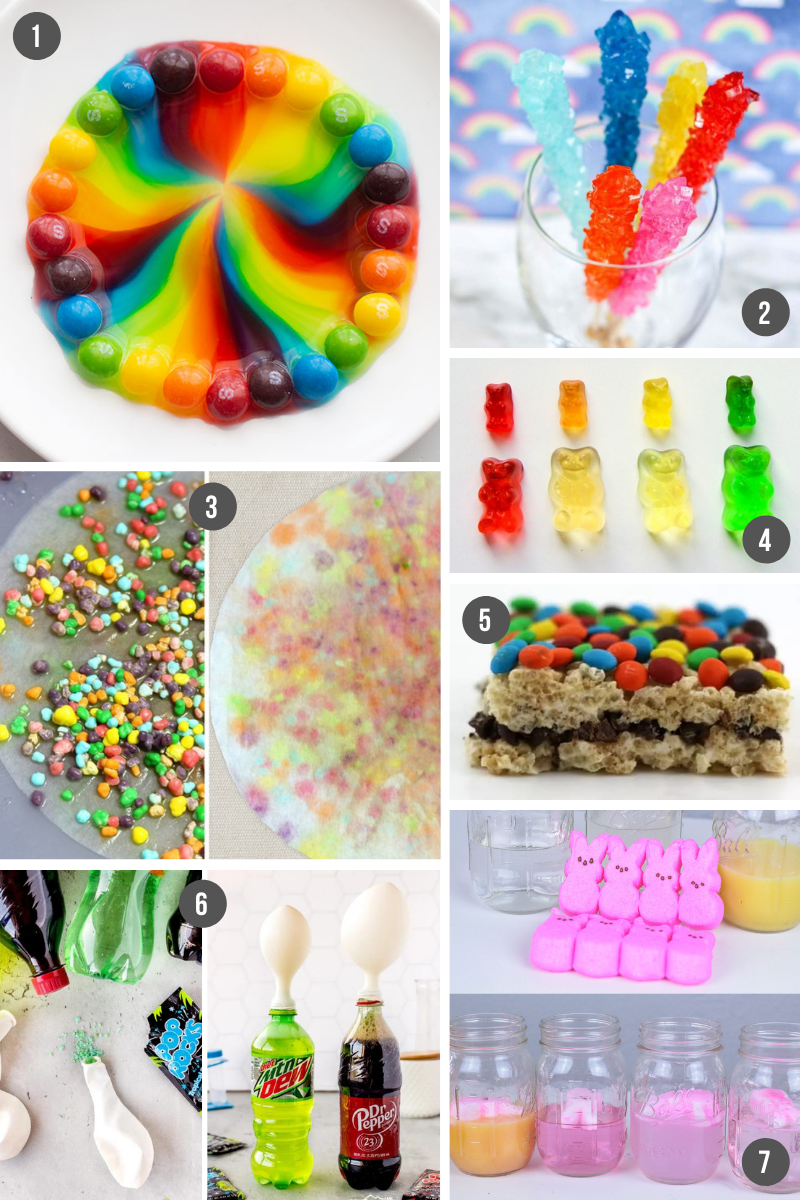
(1) Create a rainbow on your plate with this stunning Easy Skittles Experiment . (via The Best Ideas for Kids)
(2) Now this is an experiment that kids will get excited about! Make your own Homemade Rock Candy while learning about the crystallization process. (via Better Life Blog)
(3) Explore chromatography, a technique for separating difference substances (in this case, candy and dye), with this cool Candy Chromatography kid-friendly experiment. (via Mama Miss)
(4) Learn about osmosis and watch gummy candy magically grow with this simple Gummy Bear Science Experiment . (via Playdough to Plato)
(5) Does your child like to collect rocks? Why not let them dig deeper by making these Edible Sedimentary Rocks . (via Rainy Day Mum)
(6) Watch your kids get excited as you make Pop Rocks blow up a balloon in this epic Pop Rock Science Experiment . (via 123 Homeschool 4 ME)
(7) While many people either love or do not love bright marshmallow Peeps, everyone will love learning what makes them dissolve in this Dissolving Peeps experiment. (via A Dab of Glue Will Do)
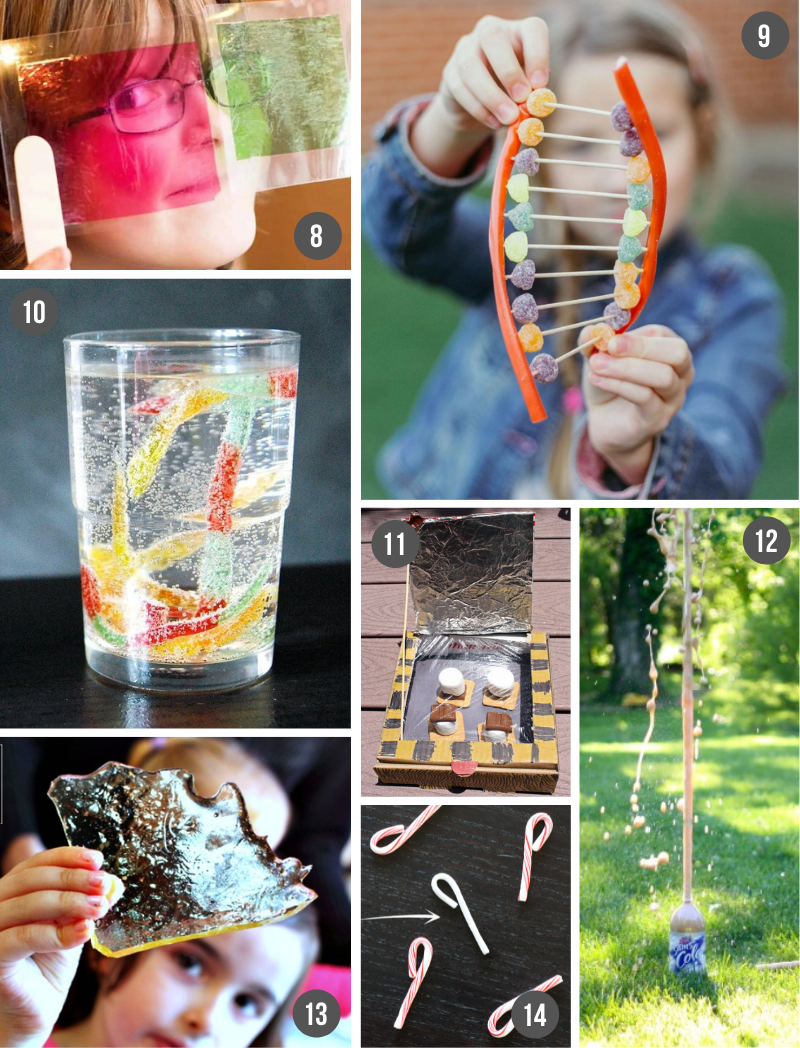
(8) If your candy has transparent colored wrappers, you can save them to learn about color mixing in with this fun color science project . (via Kids’ Craft Room)
(9) There are many ways to learn about the human body, but we’re pretty sure that the sweetest way is with candy. Kids of all ages will love making this Candy DNA Model . (via Science Sparks)
(10) Your kids won’t be the only wiggle worms in the house with these fun Dancing Frankenworms . (via Playdough to Plato)
(11) Learn how powerful the sun can be with these DIY Solar Oven S’mores . We bet you can’t eat just one! (via Desert Chica)
(12) Your little scientists will LOVE this Mentos Geyser which will teach them what happens when carbon dioxide in Soda meets a Mentos candy, while putting on quite the display! (via I Can Teach My Child)
(13) Usually we’d advise that kids stay far away from broken glass – unless, this is, it’s this yummy Edible Glass ! (via Go Science Kids)
(14) This is a simple science experiment and a magic trick! Find out what happens to sugar when emerged in warm water with this cool Disappearing Candy Cane Stripes experiment. (via Playdough to Plato)
Science Experiments Using Water
If there is anything that is almost universally fun for kids, it’s playing with water. Try one of these fun water science experiments that are perfect for a rainy day indoors, or for keeping cool on a sunny day!

(1) If your little one enjoys all things colorful, they will love this incredible Walking Water Science Experiment – and all you need are paper towels, water and food coloring to get started. (via The Best Ideas for Kids)
(2) Your kids won’t believe their eyes when they see cabbage changing colors in this fun Rainbow Cabbage experiment . (via Growing a Jeweled Rose)
(3) Discover how different liquids react together with this easy experiment that creates a colorful Layered Density Column . (via Steve Spangler Science)
(4) Or learn how water travels upward through vines and stems all while creating a beautiful bouquet with these Color Changing Flowers . (via The Best Ideas for Kids)
(5) Observe how different liquids do or do not mix by creating Fireworks in a Jar . (via Hands on Teaching Ideas)
(6) Find out how temperature affects the density of water with this colorful Hot and Cold Water Density experiment. (via STEAMsational)
(7) “Grow” your own Rainbow with this colorful science experiment that highlights chromatography. (via The Best Ideas for Kids)

(8) Keep exploring the concept of absorption, diffusion and solubility while bringing out your creative side with this Coffee Filter Process Art . (via Babble Dabble Do)
(9) See how quickly you can move water from one container to the next using sponges in this fun Water Transfer Activity. (via Live Well Play Together)
(10) Play with water and Bubbles while learning about surface tension and evaporation. (via Hello Wonderful)
(11) Who else had a lava lamp growing up? This DIY Frozen Lava Lamp experiment is not only simple and fun, but brings back the lava lamp nostalgia! (via Hello Wonderful)
(12) Explore the relationship between gas, pressure, and volume in this easy Rising Water Experiment . (via Team Cartwright)
(13) Explore the power of water pressure with this low-prep, big fun Water Suspension Science activity. (via A Mothership Down)
(14) If you are looking for an activity that you can do almost anywhere, take a couple of minutes for this Water Light Refraction Experiment . (via Go Science Kids)
(15) Learn about absorption and expansion by Measuring Water Beads. (via Blue Bear Wood)
(16) Kids will love watching their drawings come to life with these Floating Dry Erase Figures . So cool! (via Go Science Girls)
(17) What will happen if you poke a hole in a bag full of water? Will it leak? Not with this Leak Proof Bag experiment. (via Montessori from the Heart)
Life Science Experiments for Kids
One of our favorite things to learn about is how living things (ourselves included) work. These life science experiments and activities will spark your child’s curiosity about the world around them!

Life Science Experiments about the Human Body:
(1) Learn how our heart pumps blood to our bodies with this Heart Pump Model . (via Science Sparks)
(2) Your child can learn how our lungs work by making a Model Lung with simple materials you probably have around the house: a plastic bottle, straw, elastic band, balloons and play dough! (via Science Sparks)
(3) These printable life-sized organs allow kids to study their body anatomy in a hands-on way. (via Adventure in a Box)
(4) Learn all about scabs – what causes them (and why they’re so important not to pick!) by making a Fake Jelly Scab that can then be eaten! (via Science Sparks)
(5) If you’re willing to brave glitter, this Glitter Germs Hand Washing Activity teaches children the importance of thorough hand washing while talking about how germs spread. (via The Soccer Mom Blog)
(6) Or, try this Growing Germs easy science experiment which uses an apple and your own child’s germs to not only teach kids to wash their hands, but all about controls and variables too! (via Playdough to Plato)
(7) Demonstrate how tooth decay happens and how to prevent it by soaking eggshells in various liquids in this Tooth Decay experiment. Is sugar a culprit? A great lesson for kids. (via Sciencing)
(8) This super easy Heart Rate Investigation will teach your kids about their heart, blood circulation and pulse, but also get them moving! (via Science Sparks)
(9) Your budding artists will love this Magic Heart Painting activity. Watch the cardiovascular system appear before their eyes! (via Taming Little Monsters)

Life Science Experiments with Plants:
(10) How do different liquids affect plant growth? Find out with this Plant Growth experiment – it’s one of our favorite science experiments and makes a great Science Fair Project! (via Lemon Lime Adventures)
(11) Discuss how plants grow and what they need to thrive by growing a Bean in a Jar . (via Growling a Jeweled Rose)
(12) Or use a plastic bag instead! All you need is a Ziploc baggie, a few beans and a damp paper towel to Grow Beans in a Bag . (via Community Playthings)
(13) Combine engineering and science while learning all about germination with this DIY Sprout House . (via The STEM Laboratory)
(14) Observe plant growth both above and beneath the “ground” by planting bulbs in a clear cup . (via Buggy and Buddy)
(15) Watch how plants respond to sunlight in this super easy Plant and Sunlight Experiment . (via Mama Smiles)
(16) Kids will love learning How Leaves Breathe with this simple plant experiment. (via Edventures with Kids)
(17) Did you know that you can grow vegetables with scraps? Watch your scrap veggies grow new life with a Scrap Garden . (via Hess UnAcademy)
Easy Physics Science Experiments for Kids
Learn how things move with these simple physics experiments for kids. Physics is the branch of science that studies matter, how it moves, and how it interacts – it encompasses the study of motion, light, electricity, magnetism, aerodynamics, and sound.
We’ve found that the best way to explain physics to kids is to skip the explanation and do a hands-on demonstration instead. Use these fun experiments to jump feet first into the world of Physics:

(1) First off, a classic Craft Stick Catapult ! This simple activity is a great way to teach about energy cause and effect, as well as simple machines…and you thought you were just going to be launching marshmallows across the room! (via Team Cartwright)
(2) Explore physics and play at the same time with these awesome Pom Pom Shooters . (via Left Brain Craft Brain)
(3) This classic science fair project will teach your kids how to use chemistry to generate an electric current by making a Lemon/Lime Battery ! (via Babble Dabble Do)
(4) Explore the science of sound with this pretty Rainbow Water Xylophone . (via Mama Papa Bubba)
(5) Make a simple Newton’s Cradle out of popsicle sticks, string and marbles to demonstration the conservation of momentum – kids loooove this one! (via Babble Dabble Do)
(6) Send a balloon blasting off and introduce simple physics with these neat Balloon Straw Rockets . (via Preschool Play & Learn)
(7) Grab some plastic bottles and string to make this fun Inertia Zoom Ball – a project kids can learn and play with! (via What Do We Do All Day)
(8) Popsicle sticks, rubber bands and some blocks are all you need to make a Stixplosion – demonstrating chain reactions which you can use to teach about kinetic and potential energy. (via Babble Dabble Do)

(9) Make a Salty Circuit to introduce your kids to electricity and how it moves from a battery through a circuit to power an LED. (via Babble Dabble Do)
(10) Demonstrate work and energy with this super cool Paper Airplane Launcher . (via Frugal Fun 4 Boys and Girls)
(11) Visually show the concept of gravity with this easy Gravity Activity with Paperclips . (via Buggy and Buddy)
(12) If you’re feeling particularly ambitious, you can create your own Light Bulb Experiment to see how electricity travels through a circuit. (via 123 Homeschool for Me)
(13) Discover what things are magnetic and vice versa with this fun Magnet Fishing Game . Great for preschoolers! (via Rhythms of Play)
(14) Baseball fans will enjoy this Frozen Baseball Experiment to observe how temperature affects how a baseball travels. (via Our Family Code)
(15) Learn more about inertia with these easy Inertia Science Experiments with Pennies . (via Frugal Fun 4 Boys and Girls)
(16) This awesome Rollback Can is a simple physics project that will amaze your kids and demonstrate potential and kinetic energy. (via Babble Dabble Do)
(17) These 4 Magical Magnet Projects will teach your kids about magnetism, and they’ll be mesmerized by its power! (via Babble Dabble Do)
States of Matter Science Experiments for Kids
All matter is either a solid, liquid, or gas, right? Or is it? And what happens to make some matter change states more easily than others? Kids will love these easy States of Matter science activities where they will get to learn the answers to those questions and more!

(1) This Simple Balloon experiment will teach young kids all about the 3 states of matter with a Hands-on Density test. (via 123 Homeschool 4 ME)
(2) Watch as liquid cream becomes a solid by making your own Homemade Butter . Make sure you taste test it too! (via Playdough to Plato)
(3) And because it’s always a good time for ice cream, see how simple ingredients come together and change state when you make this Ice Cream in a Bag . It’s also a great activity to discuss an exothermic reaction, a chemical reaction that releases light or heat. In this instance, heat is released from the shaking, yet it freezes the cream – science sure is amazing! (via House of Nash Eats)
(4) Fill up balloons with different types of liquid in this fun Water Balloon Science Experiment and then try and predict if they will float or sink in water. (via 123 Homeschool 4 ME)
(5) A messy project that is universally loved by kids – Oobleck ! This Non-Newtonian fluid can act like a solid and a liquid. And you can make it at home as long as you’ve got cornstarch in your pantry. (via The Best Ideas for Kids)
(6) Task your kids to create an insulated box for an ice cube using materials from around the house in this Don’t Melt the Ice experiment. (via Frugal Fun 4 Boys and Girls)
We hope this list of easy science experiments for kids proves that science doesn’t have to be complicated…or boring! With materials you already have at home, you can create a memorable learning experience, and you definitely don’t need a lab coat to watch science come alive!
RELATED: Looking for more fun indoor activities to keep your kids busy? Check out 87 Energy-Busting Indoor Games & Activities for Kids (because cabin fever is no joke!)
What’s your favorite science experiment? Let us know your favorites in the comments below!

Mary Leigh is a stay-at-home mom to 3 fun and active boys. She started her blog, Live Well Play Together , as a creative way to encourage moms to celebrate the simple, everyday moments in motherhood. You can most often find her writing about kids’ activities, thoughts on motherhood, and simple ideas for family fun. Follow her on Pinterest , Instagram , Facebook , and Twitter for fun ideas to bring a little fun to your everyday!

Similar Posts

80+ DIY Star Crafts Ideas For Kids To Make (& Adults Too!)

Brand Spotlight: Tsukihoshi – Fun & Functional Shoes Your Kids Will Rave About (And So Will You!)

Creative Crayon Crafts & Art Projects

Fun Way To Give Money As A Gift. Free Printable “Something A Little Extra”.

70 Creative, No-Carve Pumpkin Decorating Ideas for Kids

75 School Lunch Box Hacks. Clever Ideas To Save Time, Money & Your Sanity.
Comments brighten our day. leave one here. cancel reply, featured in.

Unique & Useful Party Favor Ideas for Kids That Aren’t Junk!

Tween Boy Birthday Party Ideas – Fun Themes & Activities!

90+ Fun Indoor Birthday Party Games For Kids of All Ages

Creative Mother Daughter Photoshoot Ideas. Top Poses & Tips!
- Blog Detail

Simple Science Experiments that You can do at Your Home

Do you know that conducting science experiments at home is one of the effective ways to spark an interest in the subject?
Yes, we know that a majority of groundbreaking experiments require expensive lab equipment or hazardous substances. However, there is still a chunk of science experiments that you can easily perform with the help of household materials. Every trial usually lasts around half an hour and teaches fundamental science ideas applicable to children's learning. Students of all ages can enjoy these simple science experiments, which can also serve as a means of education for them. Moreover, these simple science experiments also foster critical thinking and problem-solving skills when you learn to conduct these projects, and assess their results. To help you understand better, we have compiled a variety of simple science experiments that you can attempt anytime and anywhere!
Invisible Ink: A Magical Science Experiment for Kids
Here’s a simple experiment in science that lets you create invisible ink! With the help of very simple ingredients that are readily available, you can write secret messages, which in turn can be revealed using heat. By performing this simple science project that combines science and mystery, you can learn a great deal about chemistry in a fun way.
Materials Required:
● Cotton swab
● Plain white paper
● Lemon juice
● A few drops of water
● A bowl or cup
● A lamp or light bulb (as your heat source)
Steps to Create Your Secret Message:
● Prepare Your Ink: Mix lemon juice with a few drops of water in a cup.
● Write Your Message: Use the cotton swab dipped in the lemon juice to write or draw on the white paper.
● Let It Dry: Allow the paper to dry, turning your message invisible.
● Reveal the Secret: Hold the paper close to a lamp or light bulb, and watch as the heat uncovers your hidden message!
The Science Behind the Fun
Lemon juice contains compounds that remain invisible until heated. When exposed to heat, these compounds break down, causing the carbon in the juice to oxidise and turn brown, revealing the message.
Mini Volcano: Timeless Simple Science Project
The mini volcano experiment is a true classic, bringing the excitement of science right into your home! This science experiment is an easy activity that kids can do both indoors and outdoors. Using just a few common household ingredients, you can create easy scientific experiments at home that are both educational and enjoyable.
● A plastic cup
● Water
● 3-4 tablespoons of baking soda
● 1 teaspoon of dish soap (optional for bubbly lava)
● Food colouring or washable paint
● 1 cup (8 oz) of vinegar
Steps to a Miniature Eruption:
● Prep Your Volcano Base: Fill the plastic cup about 2/3 full with water. Place towels or newspapers underneath to catch the “lava.”
● Prepare the Mix: You can add a few drops of food colour or paint to a cup filled with baking soda, and soap .
● Mix It Up: Stir everything well, creating the base for your volcano.
● Eruption: At this point, ensure to p our in the vinegar and watch the mixture fizz and overflow like a real volcanic eruption.
● Repeat with Flair: Experiment with different colours or even build a volcano structure for more fun!
This exciting experiment is one of the best science experiments for kids. Carbon dioxide is produced when vinegar (an acid) combines with baking soda (a base). This reaction causes bubbling and fizzing, which is quite similar to a volcanic eruption.
Hair-Raising Fun: A Simple Static Electricity Experiment for Kids
This simple static electricity experiment is perfect for a hands-on learning experience with no mess involved! It’s one of the best science experiments at home, offering an exciting way to demonstrate the wonders of physics and have a blast while doing it.
● A balloon (inflated)
● A piece of cloth (preferably wool, but any fabric will work)
Steps to Electrifying Fun:
● Inflate the Balloon: Blow up the balloon and tie it off. Involving your little scientists in this step adds to the excitement!
● Generate Static: Rub the balloon with your cloth for about 40 seconds. Be sure to cover the entire surface evenly—this will build up a good charge.
● Hair-Raising Magic: Hold the balloon just above your child’s head (or your own) and watch in ama z ement as their hair begins to rise and stick to the balloon!
The Science Behind the Experiment
Negative charge is produced when you rub a balloon with fabric, causing the electrons to move from the cloth to the balloon. An attractive force between the opposite charges is created when you bring the balloon near your hair. As your hair contains positive charge, it makes your hair stand up and cling to the balloon. This hands-on science experiment easy activity is a great way to learn about static electricity and its impact on everyday objects.
Sugar Water Rainbows: A Vibrant Science Activity for Kids
If you are looking for a colourful and educational activity, try the Sugar Water Rainbow experiment! This vibrant experiment teaches kids about density and buoyancy while producing a beautiful rainbow effect. You only need common household items to get started, making it one of the best science experiments at home.
● Food colouring (red, yellow, green, blue)
● Water (room temperature or warm)
● Sugar
● 5 clear cups or glasses
● Tablespoon
● Pipette or syringe for layering
Step to Create the Rainbow:
● Prepare the Glasses: Fill four glasses with equal amounts of water. Keep the fifth glass empty for layering.
● Add Food Colouring: Add red food colouring to the first glass, yellow to the second, green to the third, and blue to the fourth.
● Add Sugar:
a) In the first (red) glass, don't add any sugar.
b) In the second (yellow) glass, add 1 tablespoon of sugar.
c) In the third (green) glass, add 2 tablespoons of sugar.
d) In the fourth (blue) glass, add 3 tablespoons of sugar.
● Stir Well: Stir each solution until the sugar fully dissolves.
● Layer the Colours: Using a pipette, fill the empty glass ¼ full with the blue solution (the densest). Carefully layer the green, then yellow, and finally red solutions on top.
● Enjoy Your Rainbow: If done carefully, the colours will remain separate, forming a stunning rainbow!
The Science Behind the Rainbow
This science experiment easy activity illustrates the concept of density. The blue layer settles at the bottom as the sugar makes the water denser. On the other hand, the red layer floats on the top due to its lesser density. The difference in these densities causes the separate layers to appear as vibrant. This is just one of many fun and simple science experiments that can help captivate your interest in the subject.
In a Nutshell
Performing simple science experiments at home is a great way for you to foster an ever-lasting love for learning in the science field. These fun activities turn ordinary household items into valuable tools for studying. This further helps you understand basic scientific principles in a fun way. We always encourage nurturing curiosity from a young age as it helps develop critical thinking skills in the future. So, what are you waiting for? Gather your materials and dive into these science experiments easy projects! You will be amazed to discover the wonders of science right in your living room!
Recent Blogs
- Mastering the Art of Success: Do's and Don'ts to Become a Chartered Accountant
- Study Smarter, Not Harder: Study Tips to Upgrade Your Study Game
- How to Reduce Exam Stress and Study Like a Pro
- How to Study Effectively: Tips for Killer Study Sessions
- Tips for Studying: Best Study Tips for Final Exams

IMAGES
VIDEO
COMMENTS
Water Science Experiments. 1. Walking Water Science Experiment. This experiment is a simple yet fascinating science experiment that involves observing the capillary action of water. Children can learn a lot from this experiment about the characteristics of water and the capillary action phenomenon. It is also a great approach to promote ...
Some common household chemicals can also affect this beverage's glow. In this science activity, you will make tonic water glow…. Walking Water. Add Favorite Overflow Menu. Imagine this challenge: You have two glasses of water—one empty and one full. You want to pour half of the full glass into the empty one.
Go Science Kids. 43. "Flip" a drawing with water. Light refraction causes some really cool effects, and there are multiple easy science experiments you can do with it. This one uses refraction to "flip" a drawing; you can also try the famous "disappearing penny" trick.
17. Make a Rain Cloud In a Jar - Coffee Cups and Crayons. 18. Water Xylophone Sound Experiment - Little Bins for Little Hands. 19. Growing Mint in Water - Sloely. 20. Sticky Ice Experiment - Capri Plus 3. See more of these awesome simple water science experiments on page 2!
2. Frozen Lava Lamp Fun. Create your own frozen lava lamp with colorful ice cubes and watch as mesmerizing colored water globules dance in clear oil. 3. Investigating Water Surface Tension. Let's explore how salt and temperature affect the surface tension of water! 4. Temperature and Water Movement.
This Magic Toothpick Star Experiment is impressive to watch and will definitely wow your kids. Watch as five toothpicks transform into a beautiful star. We know that kids love glow-in-the-dark play. Try this non-toxic glowing ice for fun science play for kids. Tonic water is the secret ingredient.
This fun water experiment demonstrates how insects can glide on water. 4. Dry Ice Bubbles. Use dry ice, water & soap to make these amazing dry ice bubbles! This is the ultimate water science activity! 5. Water Science: Water Pump Sprinkler. This fun water science activity demonstrates how a sprinkler or a water pump work.
Easy Water Experiments For Kids. Click on each link below to explore cool experiments with water! Easy water experiments for elementary through middle school include concepts like the water cycle, buoyancy, density, and more. This age group is beginning to learn about core concepts in chemistry, including states of matter, how different ...
Here you will find simple experiments with water to do at home or in a school setting. They are all easy to manage and do not need a lot of preparation. Most of these water science experiments are suitable for preschoolers and older children. Go check out our fun list of the 25 Best Water Science Experiments for kids now: Enjoy!
How to: Pour hot water into jar. Place lid upside down on top of jar. Place a handful of ice cubes on the lid and let sit there for approximately 20 seconds. Remove the lid and quickly spray a spritz of hairspray into the jar. Replace the lid with the ice on top back onto the jar, and watch as a cloud forms inside the jar.
CHEMISTRY WATER EXPERIMENTS. Bath Bombs or Bath Fizzies are the ultimate in bath time fun! They are also an exceptional chemistry experiment. You can simply make a bath bomb and see how water is the magic ingredient to trigger the reaction, or do a science experiment exploring the effect of water temperature on bath bomb reactions.
Water science experiments you can do at home! Click on the experiment image or the view experiment link below for each experiment on this page to see the materials needed and procedure. Have fun trying these experiments at home or use them for SCIENCE FAIR PROJECT IDEAS.
Science Preschoolers Experiment Resources Water Activities 15 Comments. Get ready, get set, and get wet with easy water experiments for kids to do this year! I'm always looking for fun ways to add science experiments to our hands-on learning fun.When we have summer days heating up, my boys are just begging to go outside and get wet.
Pen and Paper to record your findings. Here are the steps to do the water absorption experiment: Pour a cup of water into each of your bowls. Place your paper towel in one bowl, a dishcloth in another bowl, and a sponge in the last bowl. Determine your time (3-5 minutes should be plenty) and start your timer.
Awesome Wacky Water Experiments. The activities in Week 8 of our Awesome Summer Science Experiments series feature science and engineering activities related to the design of boats, how submarines work, how water can be moved from one place to another, and how physics explains why poking a hole in a container doesn't necessarily cause a leak.
Along the way, you and your child get a lot of time to learn about momentum, velocity, friction, energy transfer, and interference (e.g., the cat). 17. Melting. This is a simple and fun experiment that can be set up in a short time and then fill-up your day with observations and new experiments.
How to do: Put some ice cubes in a glass with some amount of water. Lay the string over the ice cube. Now, sprinkle salt when the string touches the ice, and wait for about 45 seconds to a minute. Once you pull one end of the string, you will find that the ice sticks to it, making it easy to lift.
There are so many super fun and easy science experiments that can be done with just water and a few household supplies! Your kids will love these Fun Water Experiments and will ask to do them over and over again!. My favorite thing about these water experiments is that they are a great way to entertain your kids while also teaching them something new!
Step 1: Place two glasses of water side by side on a flat surface. Step 2: Cut your paper towel so that the edges will fit neatly inside your water glass. Use your washable markers to create a rainbow grid on both ends of the paper towel. Step 3: Place each end of the paper towel into your two water glasses.
Try one of these fun water science experiments that are perfect for a rainy day indoors, or for keeping cool on a sunny day! (1) If your little one enjoys all things colorful, they will love this incredible Walking Water Science Experiment - and all you need are paper towels, water and food coloring to get started. (via The Best Ideas for Kids)
With Ryan missing Aquro while he's off on his next big adventure with Leo, he decides it might help to perform some water experiments as a tribute to the lit...
The Science Behind the Fun. This exciting experiment is one of the best science experiments for kids. Carbon dioxide is produced when vinegar (an acid) combines with baking soda (a base). This reaction causes bubbling and fizzing, which is quite similar to a volcanic eruption. Hair-Raising Fun: A Simple Static Electricity Experiment for Kids